« July 2006 | Main | September 2006 »
August 31, 2006
JOHN MCCORMACK +
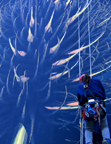
NEW THURSDAY CLUB EVENTS @ GOLDSMITHS
JOHN MCCORMACK, Co-director, Centre for Electronic Media Arts, Monash University (Australia) :: Thursday September 7th, 2006 at 6-8pm in the Lecture Theatre, Ben Pimlott Building, Goldsmiths, University of London, New Corss, SE14 6NW :: FREE, ALL ARE WELCOME.
SIMULATION, SYSTEMS, ARTIFICE: In this talk I will give an overview of how I have used generative processes as a creative system. My aim is to enable new modes of creative expression with computation that are unique to the medium. Most existing software tools borrow their operational metaphor from existing creative practices: for example Photoshop uses the metaphor of a photographer's darkroom; 3D animation systems borrow from theatre, film and conventional cell animation. In a tool with an oeuvre as diverse as the modern digital computer, one would hope that computation itself as a medium might have things to offer that are not based on metaphors borrowed from other media. I will illustrate some possibilities using the software systems I have developed over the last 15 years and the creative works that I have produced with them. These works include: Turbulence: an interactive museum of unnatural history (1994); Eden an evolutionary ecosystem (2000-2005) and the Morphogenesis series of evolved forms (2002-2006). Examination of these works will be placed in a philosophical framework and historical context. I will also discuss some possibilities for future development of generative software based on these ideas.
About Jon McCormack: John is an Australian-based electronic media artist and researcher in Artificial Life and Evolutionary Music and Art. His research interests include generative evolutionary systems, machine learning, L-systems and developmental models. He is currently Senior Lecturer in Computer Science and co-director of the Centre for Electronic Media Art (CEMA) at Monash University in Melbourne, Australia. CEMA is an interdisciplinary research centre established to explore new collaborative relationships between computing and the arts. John's artworks have been exhibited internationally a wide variety of galleries, museums and symposia, including the Museum of Modern Art (New York, USA), Tate Gallery(Liverpool, UK), ACM SIGGRAPH (USA), Prix Ars Electronica (Austria) and the Australian Centre for the Moving Image (Australia).
**NEW CLUB NIGHTS** NEW CLUB NIGHTS** NEW CLUB NIGHTS**
on *5 OCTOBER* with ***MICK GRIERSON*** :: *AUDIOVISUAL COMPOSITION AND THE AVANT-GARDES*
Mick is a musician, film-maker and researcher. He recently became a Research Fellow at the Goldsmiths Electronic Music Studios.
*19 OCTOBER* **UNEASY SPACES*
*Opening of a photo /video show in collaboration with the New York University
*20 OCTOBER* CONFERENCE (will circulate info separately)
on *26 OCTOBER* with ***ADNAN HADZI & MARIA X***
*ON STRATEGIES OF SHARING: THE DEPTFORD.TV PROJECT*
Adnan is a PhD candidate and Visiting Lecturer at Goldsmiths (Media and Communications). Maria is a PhD candidate at Goldsmiths (Digital Studios & Drama) and Visiting Lecturer at Birkbeck.
* 2 NOVEMBER* with ***BRIAN KAVANAGH*** :: *SONIC SENSORIUM*
Brian is an artist and musician. He is just completing his MA in Interactive Media at Goldsmiths.
*16 NOVEMBER* with ***TIM HOPKINS*** :: **ELEPHANT AND CASTLE*: A PRESENTATION OF WORK-IN-PROGRESS ON A LYRIC THEATRE PIECE*
Tim is an opera and multimedia lyric theatre director, and a NESTA Fellow.
*30 NOVEMBER* with ***MARK D'INVERNO*** :: **CELL*: AN INTERDISCIPLINARY PROJECT LOOKING AT NEW THEORIES OF STEM CELL BEHAVIOUR*
Mark is Professor of Computing at Goldsmiths with a research interest in
intelligent agents and multi-agent systems.
*14 DECEMBER* with SPEAKER TBC
Finally, just to remind you that
***THE THURSDAY CLUB: works in progress***
is an open forum discussion group for anyone interested in the theories and practices of cross-disciplinarity, interactivity, technologies and philosophies of the state-of-the-art in today’s (and tomorrow’s) cultural landscape(s).
Originally set up in October 2005 by Goldsmiths Digital Studios (GDS) as a more informal setting for research discussions, it has grown to include over 80 members, artists, technologists, scientists, in fact, a growing diversity of people from different communities worldwide, that are now connected via an online forum and discussion group.
There are also regular meetings in ‘real space’ at the Ben Pimlott site of Goldsmiths, University of London. Anyone can attend these events. They are free, and in keeping them informal they allow for a more diverse and open ended discourse for people who perhaps would not have the opportunity to discuss ideas outside of their chosen discipline.
For more information on the Thursday Club check http://www.goldsmiths.ac.uk/cccc/thursday-club.php or email maria x: drp01mc[at]gold.ac.uk
Maria Chatzichristodoulou [aka maria x] PhD Art & Computational Technologies 15 Rodmell Regent Square London WC1H 8HX
The Cybertheaters blog is discussing emergent networked performance practices that employ the Internet and/or other networking technologies /techniques as media, but also as hybrid spaces - and thus, cybernetic stages.
Posted by jo at 06:55 PM | Comments (0)
GROW YOUR OWN MEDIA LAB
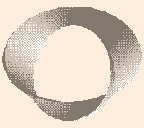
FREE WORKSHOPS
IN BARROW, CUMBRIA - STARTS SEPTEMBER 9TH – PLACES STILL AVAILABLE :: Grow Your Own Media Lab is a trans-regional action research project that aims to investigate, improve and document a low cost, participatory, open source media lab model.
folly is delivering a series of 5 GYOML workshops throughout September-December at The Canteen Film Project, based in Northern Riviera in Barrow-in-Furness, Cumbria. The workshops will give participants the opportunity to work in a variety of computer-based artistic disciplines under the guidance of some of the best-known and well-respected artists working in the field.
The Workshops will be led by 7 artists from the international collectives: Openlab, Goto10 and dyne.org.
Session One: The introduction to dyne11 and puredyne, 9th September 2006
Session Two: Realtime audiovisuals (Puredata/Gem), 30th September 2006
Session Three: Realtime animation workshop (Fluxus), 21st October 2006
Session Four: Building networked games with SVS, 11th November 2006
Session Five: Home Studio (jack, ardour, weq24, hydrogen, wired...), 2nd December 2006
All workshops will run from 11am to 4.30pm at The Canteen in Barrow, Cumbria.
How to Get Involved: The GYOML project is FREE to attend. For further information and to book your place - contact Jennifer Stoddart, programme assistant at E: mailto:jennifer.stoddart[at]folly.co.uk T: 01524 388550 V: http://www.folly.co.uk
Posted by jo at 08:57 AM | Comments (0)
August 30, 2006
Medienstammtisch @ Ars
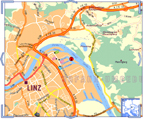
Gathering of Independent Artists
When: Friday, September 1, starting at 10.00 p.m. :: Where: extreme couching, Goethestraße 30 (map)
The Medienstammtisch* Linz invites interested Ars Electronica Festival guests and visitors to come by during the festival. The MST includes individuals – artists, activists, cultural workers and others – from the Freie Szene (the independent art scene of Linz) and various organizations and institutions, whose special interests include tools & skills for independent artists and others working in cultural contexts, electronic and social networks, possibilities for accessing and using various types of media ...
We would be happy to talk about some of the things going on in Linz and hear about similar and related interests and experiences elsewhere, including: infrastructures (e.g. public hotspots) that can be meaningfully used for artistic and social-critical projects; working and production conditions needed for independent media art and how these can be secured; various (online and offline) communication structures and platforms that can promote cooperation and collaboration; how cooperation, collaboration, solidarity are even possible when everyone is competing (has to compete) for limited resources; the use of free software for independent media work; how tools and software need to be designed so that they can be used effectively.
Those who can't make it then will also find us at the Unofficial Time's Up "simply a party" on Saturday, September 2.
Additional information: http://www.servus.at/xchange
(*A "Stammtisch" is a table at a pub or restaurant where regulars gather to discuss certain shared interests, in our case "media". Whether the discussions lead to actions or just more talk depends on the people at the table.)
Posted by jo at 08:41 PM | Comments (0)
The Bubble Project
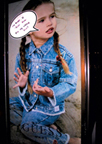
From Corporate Monologue to Public Dialogue
The Bubble Project is created by Ji Lee and is a comment on the fact that communal spaces to an ever increasing extent are being filled with ads of various kinds. The idea behind the project is to place Bubble stickers on the physical ads, thereby transforming them from corporate monologue into a dialogue open to the public. The Bubble stickers are meant to encourage anyone to fill them in with any form of self expression, free from censorship.
The Bubble Project is presented at this years Conflux festival for contemporary psychogeography, which takes place in Brooklyn, NYC, September 14-17. The Conflux festival investigates the everyday urban life through emerging artistic, technological and social pratice.
Also check out the online bubbles. [blogged by Lene Mailund on Digital Experience]
Posted by jo at 07:15 PM | Comments (0)
Upgrade! International: Oklahoma City
![]()
DIY Exhibition: Call For Entries
DIY Exhibition: DIY (do-it-yourself) is the overarching theme for the exhibit. We live in an era of increased technological dependency in which the phrase, “Do-it-Yourself” has and will continue to take on new cultural meanings. The Upgrade! OKC and IAO (Individual Artists of Oklahoma) are inviting local and regional artists working with digital and electronic media to submit examples and interpretations of this concept to be exhibited as part of the 2006 Upgrade! International Symposium. These works will be shown at the IAO Gallery with a net art exhibition curated by Tubulence.org, Rhizome.org, and Upgrade! New York. The Symposium will be a four-day event running from Thursday, November 30th – Sunday, December 3rd. However, this exhibition will remain on display through December 29th.
About Upgrade!: Upgrade! is an international, emerging network of autonomous nodes united by art, technology, and a commitment to bridging cultural divides. While individual nodes present new media projects, engage in informal critique, and foster dialogue and collaboration between individual artists, Upgrade! International functions as an online, global network that gathers annually in different cities to meet one another, showcase local art, and work on the agenda for the following year.
About the Upgrade! International Symposium: The UIOC will be the second annual international gathering where individual Upgrade! organizations and their artists converge in one physical location to present art and ideas to each other and the community. Included in the event will be workshops on art and technology, audio/video performances and presentations, and an exhibition of international and regional artists. Workshops will cover topics such as net art and creating content for the world wide web for children, creative application of open source software, social mapping as a medium of self expression, and much more.
Submission Guidelines: Please submit a detailed proposal that includes documentation, installation information, and contact information. An artist’s statement is recommended but not required. Documentation may be in the form of, but not limited to: sketches, video, CD or DVD. Installation, performance, net art, single and multi-channel video, sound/noise art, are all acceptable candidates. Please be clear about what, if any, multi-media equipment your work requires. Installations and/or works requiring extra set-up time must be installed by November 29th. Artists will be responsible for the installation of these works. This is a regional call for entries open to artists in the state of Oklahoma and surrounding areas including Texas, Kansas, Missouri, Arkansas, Colorado, New Mexico, and Arizona. By submitting work to the exhibit, the artist agrees to let their work be reproduced in a catalog and marketing materials. Artists selected to participate in the exhibit will also be granted free admission to all workshops, performances, etc.
Delivery:
Proposals may be mailed to:
PO Box 60824
Oklahoma City, OK 73146
Emailed to:
iaogallery[at]coxinet.net
Or, delivered in person to:
IAO Gallery
811 N Broadway
Oklahoma City, OK 73102
Sales: No commission will be retained on sales from the exhibition. IAO Gallery will provide artists’ information upon request to potential buyers. A 30% donation to IAO would be appreciated.
Liability: The artist is responsible for safe delivery and timely pickup of work. IAO Gallery will take every precaution to keep work safe for the period from November 22, until the final pickup date, Wednesday January 3rd, 2006. The artist is responsible for damage or loss after this date. By submitting work to this exhibition, the artist agrees to abide by the terms set forth here.
Important Dates:
September 27th - Submissions should be RECEIVED by this deadline.
October 18th - Notification of acceptances
November 22nd - Artwork due at IAO
December 1st - Opening
December 29th - Last day of exhibition
January 2 - 3rd, 2007 - Pick up work at IAO
Curators:
Adam Brown: Brown directs the Oklahoma component of Upgrade!. He has a diverse undergraduate educational background in Biomedical Engineering and Intermedia. He completed all of his graduate work at the University of Iowa, and obtained his M.F.A. there in May 2000. While at Iowa, Brown was instrumental in creating a new digital media art program called Digital Worlds. Since 2000, Adam Brown has been a Professor at the University of Oklahoma where he teaches courses in electronic media, computer science, interactivity, video and theory. He currently resides in Oklahoma City.
Jeff Stokes: Stokes grew up in Oklahoma and received a B.F.A from Oklahoma State University in 1990, and an M.F.A. in painting from Wichita State University in 2004. Stokes has curated numerous contemporary art exhibits in Kansas and Oklahoma museums and galleries, as well as showing his own sculpture, drawings and paintings in Kansas, Oklahoma, and New York. Stokes taught art in the secondary schools, and was an adjunct instructor in drawing at both Oklahoma State and Wichita State before accepting a position as Executive Director at Individual Artists of Oklahoma (IAO) in 2005. IAO is a not-for-profit arts organization committed to supporting Oklahoma artists in all media, including the visual arts, poetry, performance art, and film & video.
Julia Kirt: Kirt has served as the Executive Director for the Oklahoma Visual Arts Coalition since 1999 where she works with more than 2,500 artists statewide for professional development, grants, exhibitions and publications. She has planned and led more than two dozen workshops for artists, spoken to hundreds of students, and coordinated public educational events around the state. She instigated the Momentum exhibition and event for young artists that was attended by more than 2100 people this year and the Virtual Gallery online, which highlights hundreds of artists' artwork. She served on the board of the National Association of Artists' Organizations from 2000 until 2004, for which she acted as Treasurer in 2002 and 2003. Kirt has been a grant panelist twice for the National Endowment for the Arts in Access, Preservation, Visual Arts Creativity and Organizational Capacity categories.
Joseph Daun: Daun graduated from Florida State University in 1990 with a Bachelor’s of Fine Arts with an emphasis in Photography. In 1994, Daun earned his Master’s of Fine Arts from the University of Texas San Antonio with an emphasis in both Photography and Sculpture. Daun was selected as Chair of the Art Department at the University of Central Oklahoma. In 2005, Daun earned a tenure appointment at UCO.
During his academic career, Daun has shown in numerous art galleries and spaces across the United States including a prestigious artist’s residency at ArtPace in San Antonio, One person Exhibit at Hallwalls Contemporary Art Center in Buffalo, NY, A large installation at Fotouhi-Cramer Gallery in New York, NY, a one-person exhibit at 621 Gallery in Tallahassee, FL, large installation at Transylvania University in Lexington, KY, One person exhibit at Texas A&M University in Corpus Christie, TX. His work is in numerous university and private collections, including the University of Texas at San Antonio and the University of Central Oklahoma.
Posted by jo at 06:00 PM | Comments (0)
Sound Mirrors Project
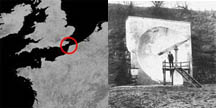
Channel Communication Amplifier
Lise Autogena's Sound Mirrors Project is inspired by the derelict acousic mirrors at Denge, England, it aims to create two new sound mirrors on the coast of England and France which will enable people on either side of the Channel to speak to each other.
The Channel Communication Amplifier incorporates the latest technology to transmit sound but has at its heart a device first developed before to World War II and the invention of radar: the acoustic mirrors built as early warning devices around the coasts of Britain to detect airborne invasions. These giant concrete dishes also existed in mobile and even wearable versions btw.
Autogena plans to build two acoustic mirrors. One will be placed in Folkestone, the other will be sited on the coast of France, 25 miles across the Channel.
Visitors will be able to climb up to a listening platform in front of the mirror and listen to the sounds of the sea, as well as for voices speaking to them from across the Channel. Standing at the focus point the person will hear a complete “holographic” binaural sound image which will appear to be coming from the air all around them.
Via Mountain7. More info on the project in The Telegraph, Creative Partnerships.
Lise Autogena also worked together with Joshua Portway on the beautiful Stock Market Planetarium, a planetarium of stars, each one representing a company and its relative value on the stock market. [blogged by Regine on We-Make-Money-Not-Art]
Posted by jo at 05:56 PM | Comments (0)
NETWORKED_PERFORMANCE
![]()
Joburg-Derby-London & You
The Premises Gallery at The Johannesburg Civic Theatre invites you to join us for a Red Bull and some live online performance: NETWORKED_PERFORMANCE VisitorsStudio performance Joburg-Derby-London live at The Premises and online at http://www.visitorsstudio.org.
A live-online collaborative performance by Nathaniel Stern, Marc Garrett and Ruth Catlow. And open laptop mixing by audiences and invited local artists at the Premises Gallery (Johannesburg), HTTP (London) and Q Arts (Derby).
EVENT: Saturday 2nd September, 16:30 – 19:00 (SA time)
Getting started and uploading at The Premises: 16h00 (SA time)
Live scheduled performance: 17h00- 17h30 (SA time) and 16h00 - 16h30 (UK time) by Nathaniel Stern, Marc Garrett and Ruth Catlow
Open collaborative mix: 17h30 (SA time) and 16h30 (UK time) Everyone welcome to join!
![]()
About VisitorsStudio: an online place for real-time, multi-user mixing, collaborative creation, many to many dialogue and networked performance and play. VisitorsStudio is a Furtherfield project @ http://www.visitorsstudio.org. VisitorsStudio is included in the Game/Play networked touring exhibition. A collaboration between Q-Arts, Derby and HTTP, London. Please see www.game-play.org.uk for further information.
How to PARTICIPATE
First, get the latest flash player on your computer. South Africans wishing to participate can bring their laptops (with ethernet cables) or content to The Premises a bit early, and upload content on our open network via their own machine or one of ours. Or, upload anywhere, anytime - you can even mix with us from Cape Town. If you want to be part of the VS performance by nathaniel, be sure to name your files beginning with SA_, and then an idea of what it is he would be including in the mix. If you want to play on your own, supply names for your files that you will remember. File types supported are jpg, png, mp3, flv and swf files, as long as they are under 200k.
More info, and to play: http://www.visitorsstudio.org
SPONSORED BY:
http://furtherfield.org
Art & Technology, Johannesburg, Co-directed by nathaniel stern and Prof Christo Doherty
Red Bull South Africa
the trinity session
The Premises at the Johannesburg Civic Theatre
The Premises at the Johannesburg Civic Theatre
Loveday Street, Braamfontein, Johannesburg, South Africa
+27 (0) 11 877 6859
thepremises[at]onair.co.za
Gallery Hours -
Tuesday - Saturday
10h00 - 17h00
office[at]onair.co.za
Directors -
Stephen Hobbs
+27 (0) 11 403 8358
sh[at]onair.co.za
Marcus Neustetter
+27 (0) 11 339 2785
mn[at]onair.co.za
Posted by jo at 01:25 PM | Comments (0)
Furtherfield.org

New Reviews/Articles
New Reviews/Articles on Furtherfield.org (August 06):
SCANZ - Article Written by Helen Varley Jamieson :: SCANZ (Solar Circuit Aotearoa New Zealand, represented several firsts: it was the first Polar/Solar Circuit event to be held in New Zealand, and the first festival of its kind in this country, bringing together 25 artists from NZ and around the world for a two week collaborative residency. SCANZ provided the context for the first faces meeting in New Zealand, and it was also the first time a group residency had been offered to Avatar Body Collision – our first opportunity for the four globally dispersed Colliders to actually meet and work together in the same physical space … !!!
Slippage - Review by Yasser Rashid :: An exhibition of net.art curated by Nanette Wylde, bringing together a group of 8 artists that include: Mez Breeze; Krista Connerly; Juliet Davis; Lisa Hutton; Paula Levine; Jess Loseby, et al.; UBERMORGEN.COM; and Jody Zellen. The exhibition presents an eclectic mix of work under the broad concept of 'exploring and exposing relationships between intention, perception, control, experience, behavior, memory, knowing and the unexpected'.
aPpRoPiRaTe! - Review by Mark Hancock :: Feeding a movie that you’ve downloaded from a Peer to Peer network, into aPpRoPiRaTe by Sven König, reveals the nature of the “collaborative” effort that the image/audio undergoes in the sharing process. Watching the individual frame sequences on his website, we see how the image is staggered and broken into 'blocky' difficult to view images. There’s an aesthetic at work here that feels right in the context of shared content on the web. What appeals most of all is that the software reminds us of what movies really are.
Elephants Dream By The Blender Foundation - Reviewer: Rob Myers :: Visually, Elephants Dream is a brooding European social-realist surrealist fantasy rather than an American Disney-inspired Pixar fantasy. Bleak mid-20th-century technological landscapes are twisted into a fantastic realm of vertiginous, deep, dark spaces and vague but ever-present threats. Flying electrical cables and cthonic telephone earpieces attack as clockwork birds and self-dictating typewriters watch on. Proog and Emo walk on robotic footholds across bottomless pits or argue in front of fragments of a world projected by giant projectors on tripods that have the air of martian war machines.
All reviews:
http://www.furtherfield.org/displayreviews.php
Reviewers at Furtherfield:
http://www.furtherfield.org/reviewersbio.php
Posted by jo at 11:19 AM | Comments (0)
Open Burble
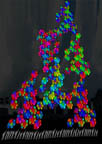
A Combination of the Crowd's Desires + Turbulence
bur.ble n.: 1. A gurgling or bubbling sound, as of running water. 2. A rapid, excited flow of speech. 3. A separation in the boundary layer of fluid about a moving streamlined body, such as the wing of an airplane, causing a breakdown in the smooth flow of fluid and resulting in turbulence.
In Open Burble, a crowd of participants designs and constructs a "burble" that rises towards the sky like a plume of smoke. The project came about because we wanted to find a way to use the technology developed for Sky Ear in a more intuitive way that enables people to engage directly with the tactile experience of flying the cloud.
Participants will divide into groups in order to assemble about 140 hexagonal "clouds" into a complete Burble, built to such a scale that, when inflated with helium, it will soar upwards like Jack's beanstalk. Just as the participants are the generators of the Burble's 60m tall form, so too are they the ones to control it. They hold on to it using handles with which they may position the Burble as they like. They may curve in on themselves, or pull it in a straight line - the form is a combination of the crowd's desires and the impact of wind currents varying throughout the height of the Burble.
The Burble will move, rustle, tangle, fold in on itself and create turbulence as the wind catches it like a sail. Suddenly, the entire construction will ignite with colour, sparkling in the evening sky. As people on the ground shake and pump the handle bars of the Burble, they will see their movements echoed as colours through the entire system. They will see their own individual fragments, perhaps even identifying design choices they have made. Their invididual contributions will become an integral part of a spectacular, ephemeral experience many times their size that they have come together to produce. [via Interactive Architecture dot Org]
Posted by jo at 08:33 AM | Comments (0)
August 29, 2006
Interferenze festival 2006
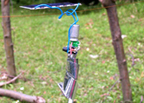
Naturalis Electronica
Digital and organic are never antonyms at Interferenze, the annual festival of new arts taking place in San Martino Valle Caudina (Italy). In the middle of a beautiful chestnut trees forest the 2006 edition lead the young local enthusiastic curator crew to succeed in integrating digital culture with their own cultural roots. 'Naturalis Electronica' was the leit motif of three days of electronic art, celebrated in a friendly atmosphere with no barriers between artists and public, sharing almost the same spaces, perfectly mixing the local environment and food tradition with the artistic research on the edge of digital and organic. The curators' commitment to this philosophy is almost total and it was seamlessly implemented in the festival program attracting the usual mass of thousands of local curious people plus experts arrived from all over the nation attending the event. Amongst the most popular one there were the workshops of the solar-powered micro-robots by Ralf Schreiber: they were unofficially repeated every day after the first crowded one. Schreiber scattered also some of his chirping electronic lifeforms around the forest as an installation ('Living Particles'), forcing the hanging around crowds to always wonder themselves if the sounds they heard was real or virtual.
Food was also one of the main topics, as in the 'gastroacoustic' performance of the Troyer brothers + Philip Furtenbach. This was perhaps even too ethereal bringing some speakers together that 'cooked' sounds at the very moment the (freely available) near raw chicken and vegetable soup was doing, placed on a wood fire. But this was not the only food involved: a professional daily workshop was available for appreciating craftily prepared cheeses, wines, truffles and hams. This kind of food knowledge was adding important levels of information in the tasting process, providing a deeper level of understanding of the manufacturing act and, more relevant, a much better conscious sensorial experience. The awareness of technical tools was the goal of a conference on the use of Open Source software to intervene in the urban and natural territory management. Stimulating the consciousness of sounds, instead, was one of the implications of 'Acquatic' by Marianne Decoster-Taivalkoski, a hidden webcam activated sound environment made out of calm / normal / frightening recordings of sea waves, triggered by the amount of audience movements. The other two installations were the famous 'Process 6,7,8' by Casey Reas, the beautiful organic drawings generation coded with his own Process programming language and an interactive showcase of the graphic organic irony of Frédéric Durieu/ LeCielEstBleu.
Sounds were omnipresent, and the locative approach of Zeenath Hasan and Richard Widerberg (IMPROVe) was refreshing. After a collective recording walk in the wood they performed a 'concert' happily cutting the found and raised sounds. A different type of collective performance was organized by the well known Japanese Sine Wave Orchestra. Their shared sinewave generating transparent eggs gave a different soundtrack to the obscure ambiental surroundings, provoking night birds wondered twitters as a reaction.
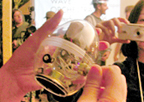
The live sets in the night were surrounded by the deep dark of sleeping mountains. Biosphere opened his long and retrospective set with agricultural samples used in his upcoming album while the Japanese O.blaat flustered a silver bowl of water placed on a big speaker with her own software-generated sound waves. The only performance unfortunately affected by nature was in the end the Emi Maeda with Lia one. While the former was intriguingly attacking a classic harp, the latter guided her graphic abstract patterns evolution on the screen, but a sudden thunderstorm interrupted the final part. With a solid partnership with the Pixelache festival in Helsinki, Interferenze is uniquely questioning the digital art festival form, going deeper and deeper in its own territory roots and extending accordingly to the rest of the world its specific research. [posted on Neural]
Naturalis Electronica, Interferenze festival 2006 photo set
Posted by jo at 11:12 AM | Comments (0)
Second Life Liberation Army
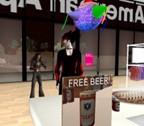
Battles in the Virtual World of Second Life
A group called the Second Life Liberation Army have been harassing Second Life inhabitants in the stores of First World brands. Earlier this month, members of the SLLA stopped shoppers buying in American Apparel. Their mission is to get voting rights in the world plus a share in the Second Life company, Linden Labs.
Second Life Liberation Army - The SLLA is a national liberation movement working towards establishing citizens rights within Second Life.
More info about on-line rebellion here. [posted by Marc Garrett on netbehaviour]
Posted by jo at 10:58 AM | Comments (0)
Art & Activism at Mejan Labs

Art that Presents Alternatives
Art & Activism at Mejan Labs :: August 31 - October 8, 2006 :: Opening: Thursday, August 31, 5-8 pm.
Art & Activism is the first project at Mejan Labs for the autumn of 2006. It deals with art that presents alternatives and that often has some sort of a political content. In collaboration with the British organization Furtherfield we present a number of artists who combine art, activism and new media. Participating artists are Heath Bunting, Kate Rich, C6, Eva and Franco Mattes (0100101110101101.ORG) and Andy Deck.
We will also show the new film 5+5=5, produced by Furtherfield in collaboration with Mejan Labs. Participating artists and filmmakers are Mongrel, David Valentine, Chris Dooks, Furtherfield, Michael Szpakowski, Simon Poulter, Anya Lewin, C6 and Tobias Lee.
Mejan Labs, AkademigrŠnd 3, SE-111 52 Stockholm, Sweden Tel: +46 (0)8-796 60 30, info[at]mejanlabs.se
Posted by jo at 08:45 AM | Comments (0)
August 28, 2006
Wifi Camera Obscura
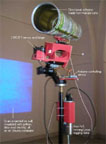
Photos of wifi Space
Today, we are increasingly creating and responding (sometimes in a very painful way) to non-visual electromagnetic fields: those emanating from our devices and environments. What might a camera obscura for our age look like? How might it reveal the relationship we have to our data environments?
Wifi Camera Obscura reveals the electromagnetic space of our devices and the shadows that we create within such spaces, in particular our wifi networks which are increasingly found throughout cities of the developed world. The data are scanned, analysed and translated into a luminous composition projected, line after line, on a wall. Different SSIDs are assigend different colors.
A collaboration between Usman Haque, Bengt Sjölén and Adam Somlai-Fischer. The work is currently exhibited at Waves in Riga until Sept 17, than a second version of it will be shown at Perimeters, Boundaries and Borders, Folly, in Lancaster, UK from Sept 29 to October 21. [blogged by Regine on WMMNA]
Posted by jo at 07:22 PM | Comments (0)
Device Art:
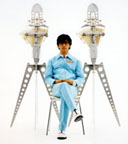
A New Form of Media Art from a Japanese Perspective
Device Art is a concept for re-examining art-science-technology relationships both from a contemporary and historical perspective in order to foreground a new aspect of media art. The term "Device Art" may sound obscure, or even self-contradictory, but it is a conscious choice. The concept is a logical extension of a change in the notion of art that already started in the early 20th century with art movements such as Dada and Surrealism. More recently, interactive art has redefined forms of art and the role of artists. What we call device art is a form of media art that integrates art and technology as well as design, entertainment, and popular culture. Instead of regarding technology as a mere tool serving the art, as it is commonly seen, we propose a model in which technology is at the core of artworks.
As I will discuss later, the concept took shape on the basis of an analysis of works by contemporary Japanese media artists. Features surfacing in many of these projects include interaction, a positive attitude towards technology, and playfulness. The influence of Japanese cultural tradition can be clearly traced in these haracteristics. Another aspect of this work is the artists' involvement in fields such as design, entertainment, and commercial production, which becomes evident in the approach of internationally recognized artists such as Toshio Iwai, Nobumichi Tosa (Maywa Denki), and Kazuhiko Hachiya. This approach, which is often considered suspect from a Western point of view, is actually a natural part of Japanese art. A long history of visual culture that developed independently from Western paradigms of art plays an important role in the Japanese art scene, offering artists wider possibilities for bringing their concepts outside of the context of museums and galleries." From Device Art: A New Form of Media Art from a Japanese Perspective by Machiko Kusahara, Intelligent Agent Vol. 6 No. 2, [pdf] [via] [Related post]
Posted by jo at 06:48 PM | Comments (0)
Art Show Down
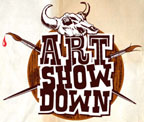
A Game Show About Art & An Exhibition About Game Shows
Art Show Down @ Art Interactive :: September 15 – November 5, 2006 :: Opening reception: Friday, September 15, 6-8 pm :: Gallery hours: Saturday & Sunday, 12-6 pm :: Curated by Roland Smart and Jeff Warmouth.
Beginning in the 1950s, at the end of the quiz show era, several scandals revealed that networks were conspiring to affect the outcomes of competitions and their ratings. A series of investigations by the Federal Communications Commission led to a general distrust of commercial networks. Through the process of re-branding quiz shows as game shows, along with new FCC regulations, game shows regained the trust of their audiences and soared in popularity. Art Show Down aims to critique and exploit the game show genre by exploring the nature of televised competition and how it interfaces with commercial interests, culture, and the production of contemporary art.
During the run of the show, seven half-hour episodes will be broadcast on Cambridge Community Television. Additionally, Art Show Down is a gallery exhibition featuring a display of artwork created during the live performances, as well as a behind-the-scenes view of the studio set, props, costumes, and taped episodes.
Episodes: Sept. 16, 2 & 6 pm, Sept. 30, 2 & 6 pm, Oct. 14, 2 & 6 pm, and Oct. 28, 6 pm.
Artists: Rand Borden, Paul Concemi, Rob Coshow, Megan Goltermann, Ravi Jain, Matt Nash, Nick Rodrigues, Haik Sahakian, & Jeff Smith
Installation Manager: James Manning
Music: Brendon Wood
Research & Writing: Anna Goldsmith & Ardra Whitney
Art Interactive
130 Bishop Allen Drive
Cambridge, MA 02139
Tel: 617.498.0100
Fax: 617.498.0019
www.artinteractive.org
Posted by jo at 05:42 PM | Comments (0)
WAVES
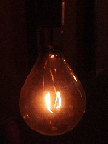
A Show With Electromagnetism
Electromagnetic waves surround us, in fact they constantly pass through us. They propel the technologies that keep our lives in motion, so it is natural that new media artists would be drawn to them as a subject. An exhibition currently on view in Riga, Latvia, 'looks at electromagnetic waves as the principle material--the medium--of media art.' The WAVES show includes forty projects by over seventy artists from eighteen countries, many of which are much more utopian than those seen in recent medium-specific exhibits. WAVES organizers at the new media organization, RIXC, have worked to formulate a roster that 'interrogates the conventions of media art exhibitions' and educates viewers about the ubiquity and plurality of contexts in which these signals flow. The ultimate message is that taking control of the waves might actually allow for alternate realities via alternate power structures and communication systems. Considering how invisible these waves tend to be, there are some remarkably large-scale works in the show, which the curators summarize as sometimes 'based on screens and audio-visualisations of waves,' but also 'rely[ing] on physical objects... obscure or forgotten communication technologies... and the antenna as an art object.' Point your own antenna at RIXC's website to learn more about several dozen innovative art projects. - Regan McGill, Rhizome News.
Posted by jo at 05:30 PM | Comments (0)
Playback_Simulated Realities

The Impact of Re-Enactments on Society
Playback_Simulated Realities :: 3 September - 5 November 2006 :: Opening: 2 September 2006, 7 p.m. :: Participating Artists: Ant Farm and T.R. Uthco, Christoph Draeger, Omer Fast, Beate Geissler/Oliver Sann, Lynn Hershman, Felix Stephan Huber, Eddo Stern, Milica Tomic, Susanne Weirich.
Public interest in elaborately staged history spectaculars which are supposed to bring the past to life as realistically as possible by virtue of faithful adherence to detail continues to grow apace. The form used for re-enacting political events and milestones of world history is also increasingly shaping approaches to art. Forms of 're-enactment' and simulation occur above all in the context of the new technologies. The exhibition "Playback" investigates the influence and impact re-enactments and simulations have on society. It raises questions about the function of the digital substitute worlds developed in computer games in satisfying viewers' needs. It discusses the yearnings for authentic experience which are also addressed in reconstructions of past eras. In a 'society of spectacle', which only values reproduction, it raises the question of whether we can still trust our own experiences and memories and, if so, to what extent.
What changes take place when historic events are retold? The works shown in the exhibition examine in reconstructions and stagings how experiences and memories are at once individually experienced and culturally construed.
The Eternal Frame, a video by the Ant Farm and T.R. Uthco group, is a critical commentary on the globally reknown images of the assassination of John F. Kennedy disseminated by the mass media that has engraved themselves on our collective memory. Christoph Draeger's Black September restages the terrorist attack that claimed eleven victims at the 1972 Munich Olympic Games; fact and fiction, past and present are so intricately interwoven that the boundaries between documentary and real experience are blurred. In his video Spielberg's List, Omer Fast deals with the construction of, and response to, the past, describing the casting process and what the cast of the Holocaust film "Schindler's List" by Stephen Spielberg experienced in making the film.
Return to Veste Rosenberg by Beate Geissler and Oliver Sann plunges viewers into a computer game that has become reality. Pictures of soldiery deployed in a medieval fortress alternate with fairy-tale shots of enigmatically phantasmagoric figures from a different time. In her documentary feature film Strange Culture, Lynn Hershman relates the dramatic events which changed the life of artist Steve Kurtz when the FBI, after the tragic death of his wife, suspected his art activities as an act of eco-terrorism. In the video Vietnam Romance, Eddo Stern investigates the influence of mass-media images on public perceptions of wars and shows images from computer games that recreate the representation of the Vietnam War in Hollywood films. In the computer installation Ops Room by Felix Stephan Huber, the player is caught up in the simulation of an historic place. What is staged is the celebrated control room realised in Santiago de Chile by the cyberneticists Stafford Beer and Fernando Flores in 1972, which was intended to be used as an instrument for computer-controlling the interventionist socialist economy under Salvador Allende.
In Container, Milica Tomic has succeeded in creating a memorable link between questions of identity and memory, personal and political history. Dependencies and power politics experienced by members of a capitalist society are subjected to radical criticism in this video and slide show, in which she refers to the issue of human beings as wares. In Silent Playground, Susanne Weirich stages six film sequences, which borrow the logic and setting of computer games. Matching the binary strategy of such games, each filmic sequence has a good and a bad ending.
Events: Friday, 8 September, 8 p.m. :: Sir Drone (1989) by Raymond Pettibon :: Filmscreening within the scope of the Oldenburger Filmfestival
A catalogue will be published.
Guided Tours: every Sunday, 3 p.m.
17 September and 22 October: guided tour by Sabine Himmelsbach
Edith-Ruß-Haus für Medienkunst
Katharinenstraße 23, 26121 Oldenburg
t. +49 (0) 441 - 235 3194, http://www.edith-russ-haus.de
Posted by jo at 03:24 PM | Comments (0)
Sometimes
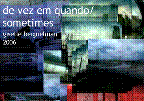
(De Vez em Quando)
Sometimes (De Vez em Quando) by Giselle Beiguelman, 2006 :: ZKM interconnect @ between attention and immersion Sep. 01 – Oct. 15 ::
Sometimes explores the mutations of the urban vision mediated by multimedia mobile phones. It is a generative video which decomposes and reconstructs itself through the audience's actions. Images captured by the artist, with cell-phone cameras, in the traffic, among moving cars, are offered to the public's manipulation. Using just the resources of mouse and keyboard, the interactors recompose on big screens, in real time, the order of frames and re-edit the original film, introducing color and light filters over the images. The original film restarts, on the new image layers built by the audience, anytime the mouse and/or keyboard are abandoned. The result is a fabric of images which consume themselves, following the logic of intense traffic and jam situations. In that context, the registers' build-up happens through saturations, constructing visual memories with different degrees of opacity, guided by hiatuses and gaps. In the intermittent play between acceleration and stagnation, a palimpsest of inputs prevails, oscillating between sometimes and once in a while.
Posted by jo at 10:39 AM | Comments (0)
I Am(not)sterdam

10 Exercises to get the City out of your Body
Radio LIGNA / Radioballet / :: I Am(not)sterdam: 10 Exercises to get the City out of your Body :: Saturday September 2nd | 13.30 pm :: Radio Patapoe 88.3 FM and Radio Ruigoord 90.3 FM :: Location: Leidsestraat :: Bring your own radios and mobile phone receivers! :: Radio receivers also distributed at De Balie, Kleine-Gartmanplantsoen 10, Amsterdam.
Amsterdam Inc. - In the streets of Amsterdam, we are not only inhabitants or visitors of the city, but we also are part of a brand, that blends the individual being and the city into a common identity: 'I amsterdam'. There is no being in the city without being the city. The public sphere becomes the showroom for the new brand Amsterdam.
Deviant Behaviour - The appearance of the inner city as showroom is a product of sanitizing policies, eviction, surveillance and control. The latter is not only executed by police, and security personnel, but also by ourselves, as we have internalized modes of self-control and 'proper' behaviour. In the beat of the corporate city we confirm this logic by simply repeating the same set of fixed gestures again and again: walking around, stopping, looking in the shop windows, exchanging money for commodities. No rule is needed forbidding deviation: individual deviation is already part of the city branding.
'I amsterdam' means diversity. But what happens if we fail to repeat these gestures, and invent alien gestures on a collective scale? Can we, as inhabitants and visitors of Amsterdam, intervene in its regulated urban rhythm without becoming incorporated in the city's branding?
Radio ballet - The Radio Ballet 'I Am(not)sterdam' challenges you to find an answer! The radio ballet consists of a radio broadcast, especially produced for the Leidsestraat. It will suggest 10 different exercises to get the city out of your body. As a dispersed collective of participants, we perform deviant gestures (according to the script of the radio ballet), which would normally be impossible to do on an individual basis. Can we subvert the logic of the corporate city, by not subjecting ourselves to it anymore?
Come and find out! Be part of the Radio Ballet in the Leidsestraat on Saturday, 2nd of September 2006! I Am(not)sterdam! Dispersed collectivity instead of common identity! Don?t subject to the corporate city - become alien by public radio listening!
About Radio Ballet LIGNA
The free radio group LIGNA exists since 1995. LIGNA consists of the media theorists and radio artists Ole Frahm, Michael Hüners, and Torsten Michaelsen, who since the early nineties have been working at the "Freies Sender Kombinat" (FSK), a public non-profit radio station in Hamburg. In several shows and performances they have been investigating the importance of dispersal in radio as well as of the radio. One of the main focuses is to refer to forgotten and remote possibilities of radio use in order to develop new forms of interactive practices. Another emphasis has been placed on the development of concepts and the production of performative audio plays in order to find out how radio can intervene in public and controlled spaces, so that its public nature reappears in the form of uncontrollable situations
The “Radio Ballet” is an excellent example of the latter: it is a radio play produced for the collective reception in certain public places. It gives the dispersed radio listeners the opportunity, to subvert the regulations of the space. Held for the first time in Hamburg’s Central Station in 2002, this focused on how radio can intervene in public and controlled spaces, so that its public nature reappears in the form of uncontrollable situations. Yet, Ligna's performances aim to confront the privatised, controlled production of capitalism with the dispersed, yet collective, uncanny and public production of the radio. The Radio Ballet brought back excluded gestures of deviant behavior were invited to enter the station, equipped with cheap, portable radios and earphones. By means of these devices they could listen to a radio program consisting of a choreography suggesting permitted and forbidden gestures (to beg, to sit or lie down on the floor etc.). These suggestions were interrupted by reflections on the public space and on the Radio ballet itself.
The Radio Ballet I Am[not]sterdam, especially developed for De Balie, consists of a radio broadcast, produced for the Leidsestraat in Amsterdam. The radio broadcast will suggest ten different exercises to get the city out of your body. The dispersed collective of radio listeners will be able to perform deviant gestures that no one would or could do alone.
Is it possible to subvert the logic of the corporate city, if people do not subject themselves to it anymore? Come and find out! Become part of the LIGNA Radio Ballet in the Leidsestraat on Saturday, 2nd of September 2006!
The Radio Ballet starts at 14:00. You can get radios at De Balie from 13:30 on. But better bring your own radios, or mobile phones with receiver! The Ballet will be broadcasted on the Frequency of Radio Patapoe 88,3 FM.
I Am[not]sterdam! Dispersed collectivity instead common identity! Don´t subject to the corporate city - become alien by public radio listening!
Posted by jo at 10:03 AM | Comments (0)
transmediale.07 + club transmediale.07
![]()
Call for Entries
transmediale.07 :: festival for art and digital culture berlin :: 31 January - 4 February 2007 and club transmediale.07 :: international festival for electronic music and related visual arts :: 26 January - 3 February 2007 :: Call for Entries :: Deadline: 8 September 2006 :: Award Ceremony: 3 February 2007 :: Find the complete call and submission form here
transmediale.07 festival for art and digital culture berlin, invites submissions for its Award Competition 2007. The competition highlights outstanding contemporary artistic positions in digital media art. The international jury will award one main prize of EUR 4.000, and two second prizes of EUR 2.000 each.
The transmediale award is a major international award for art reflecting on the aesthetical and cultural impact of new technologies. Previous award winners have included renowned artists like Shilpa Gupta (in), Zhou Hongxiang (cn), Istvan Kantor (ca), Thomas Koener (de), Agnes Meyer-Brandis (de), Netochka Nezvanova (us), Adrian Ward (uk), schoenerwissen (de), Herwig Weiser (at), 242.pilots (no/pl/us), and others.
As a festival for art and digital culture, transmediale presents advanced artistic positions reflecting on the socio-cultural impact of new technologies. It seeks out artistic practices that not only respond to scientific or technical developments, but that try to shape the way in which we think about and experience these technologies. transmediale understands media technologies as cultural techniques which need to be embraced in order to comprehend, critique, and shape our contemporary society.
Digital media are increasingly used by artists of all disciplines to express their ideas and to explore new aesthetic territories and the relation between art and technology. What is important for transmediale, though, is that the artistic practices do not only make use of technologies, but that they imply a reflection about the aesthetic, cultural and social dimensions of such technological developments. transmediale and its competition promote an understanding of media art as a sounding board and catalyst for a critical and creative expansion of the potential of human agency through new technologies.
We invite the submission of works and projects that respond to this challenge. We are interested in works that expand our understanding of digital image and sound aesthetics, of narrative, of interactivity and, in particular, the cultural significance of software and computer programming as cultural techniques. However, we are also curious to see the submission of works outside of these areas, works that expand our notions of artistic practice, and works which can makea strong argument for the crucial role that new technologies play in our perception and projection of a contemporary global culture.
Together with the jury, we explicitly welcome submissions from artists who live and work outside of Western Europe and North America.
transmediale is hosted by Berliner Kulturveranstaltungs-GmbH in cooperation with Akademie der Kuenste. Funded by the German Federal Cultural Foundation.

club transmediale (CTM) - festival for adventurous music and related visual arts - takes place in conjunction with the transmediale. CTM is an independent platform for new forms of electronic and experimental music and for the various artistic activity drawing infl uences from and refering to sound- and club culture. It presents outstanding productions in digital, electronic and experimental music, audio-visual performance and installation.
CTM reflects on the role of contemporary music culture as a changing agent for present society and - due to the massive dissemination of music - as one of the key elements to shape the transformation processes that characterise todays mediasphere. With a focus on the exploration of performative concepts, informal networks and the interaction between different media formats - especially of image and sound - CTM emphasises the situative potential of live music and performance. Thus it encourages the crossover of institutional, academic and subcultural contexts.
club transmediale invites the submission of works and projects in the fields of digital, electronic and experimental music, audiovisual performance, sound art, installation, video-performance/VJing, music video and of design concepts aimed to shape social situations and communication processes related to music culture.
Posted by jo at 09:25 AM | Comments (0)
SHIRLEY BASSEY GETS MIXED UP
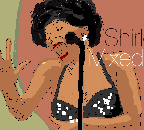
A Collaborative Biography
Shirley Bassey Mixed Up is a collaborative biography: an illustrated biography of the legendary diva, where the reader helps to 'mix' the illustrations online, using Internet searches. The biography was inspired by an incident on a TV awards show last year, where Bassey was publically humiliated. I felt sad to see this happen, and wanted to know more about what led up to this. All illustrations are built on-the-fly from live Yahoo searches. By specifying different searches and playing with the customisation options, the reader creates the illustrations themselves. This is a traditional (linear) 14-page story built on top of a generative composition tool, that uses Internet search data as its input.
The work can be described as a networked narrative, as a story partly created by networked data. Adding unexpected and uncontrolled elements to the story influences and changes the presentation, how it's experienced and what we take away from it. This shapes the story, changing fact into fiction, sometimes disrupting the story. As the networked elements are dynamic and largely unpredictable, every version of the biography is unique. Your version of the story is packaged into booklet form, for you to print and keep.
About Dave Miller: Dave Miller experiments with illustrated stories and networked media. More of his work can be seen here. [Related]
Posted by jo at 09:16 AM | Comments (0)
Liverpool Biennial Conference: City Breaks?
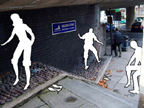
Art and Culture in Times of Expediency
Liverpool Biennial Conference :: City Breaks? Art and Culture in Times of Expediency :: 19 – 22 October, 2006 :: Static, Liverpool
Today, the idea of culture as an expedient has gained legitimacy in West and underpins the enormous capital investment in a contemporary art infrastructure (of late in China). Increasingly, culture is supported as a purveyor of economic development and a tool to remediate social inequality. This trend has produced a contradiction for art whereby accountability and visibility jar with self-organisation and open-ended processes of valorisation.
Biennial exhibitions are habitually criticised for spectacularising the presentation of art. However, in recent years the proliferation of Biennials has yielded different models that distinguish themselves notably in their relation to place. Where on the one hand this multiplication follows the logic of globalised capital on the other a revaluation of our relation to the global has generated renewed attention to the local situations and translocal existencies. In addition new alliances between art, science and fe. ngo’s, cunning, trickery and ruses displace rugged nostalgia for oppositionality. Arguably some Biennials have contributed to the creation of new public spheres and a meaningful critique therefore needs to be precise about the ways in which the relation between the local and global is constituted. How does this new generation of Biennials fare?
Arguably some Biennials have contributed to the creation of new public spheres in their localities. Is it possible to square demands of city marketing and cultural tourism with an engagement with issues of citizenship, communities, dissensus and denizens? How can we constitute a bifocal perspective allowing us to examine the visual regime of capitalist consumption and the immanent meaning of art and social practices at the same time?
City Breaks? takes place over four days (the length of a ‘city break’), starting on the Thursday evening with an evening lecture, and followed by morning panels and afternoon workshops, in which thinking and doing enacts both local and international dimensions.
With: Ackbar Abbas, Cecilia Andersson/Work Ltd, Christian Nolde/ Biomapping, Claire Bishop, John Byrne, Nina Edge, Charles Esche, Flying City, Beatriz Garcia, Jonathan Harris+Felipe Hernandez/CAVA, Pablo Helguera/ The School Pan-American Unrest, Manray Hsu, Gerardo Mosquera, Amalia Pica, Jean Francois Prost, Sala-manca, Stealth Unlimited, Paul Sullivan/Static, Ti-Nan Chi, Stephen Wright, George Yudice, a.o.
Ticket information and booking:
Tel: +44 (0)151 709 7444
Fax: +44 (0)151 7097377
Email: claireraffo[at]biennial.com
Posted by jo at 08:12 AM | Comments (0)
August 25, 2006
State of Play
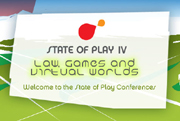
Conference Heads East
Aaron Delwiche of San Antonio’s Trinity University and the Terra Nova blog posts the news that the next State of Play conference will be held January 7-9 in Singapore. “We are convening thought leaders from Asia, Europe, Africa and the Americas to engage in a lively discussion about the unique regulatory and cross-cultural challenges posed by the growth of transnational virtual worlds.” It’s an interesting choice of location for what’s probably the most forward-thinking conference on virtual worlds. Asia has more virtual world “residents” than any other region of the world, and has seen a number of legal decision handed down that treat virtual worlds more like real places — with real property laws — than any in the West. Singapore will be tough to get to for many Western-Hemisphere VW pundits, but it also opens the dialogue to people we haven’t heard that much from on te other side of the world.
As Aaron’s post (and the SoP splash page) puts it:
Throughout Asia, people of all ages are gathering in cybercafes to participate in “deep” virtual worlds such as Lineage II and World of Warcraft or to play casual titles such as PangYa. With the highest broadband penetration rate of any country on the planet, Korea is currently an epicenter of gaming innovation, pioneering a free-to-play business model that seriously threatens subscription-based titles. Meanwhile, analysts note that India is poised to become a huge player once it builds out the necessary technological infrastructure. India is already the region’s third largest market for on-line games, despite the fact that less than .02% of the population has broadband access.
When you take into account the fact that NGOs and many government development agencies hope to seed the Asia Pacific region with inexpensive wireless broadband notebooks, it is clear that we are witnessing something completely unprecedented. We are eager to tease out the implications of these developments, and are intentionally convening virtual world industry experts, game scholars and technological neophytes to deepen our shared understanding.
Interestingly, the splash page also flags a New York State of Play this October, but there doesn’t seem to be any information about it on the site. I spoke on a panel on virtual journalism (Reporting from the Front) at last year’s event, which was a fantastic gathering of thinkers in the space. Among the speakers flagged for Singapore are Neal Stephenson, Cory Doctorow and Julian Dibbell, who will be holding “an extemporaneous discussion about the future of virtual worlds,” Alice Taylor, Nick Yee, Ren Reynolds, Richard Bartle and a handful of other similarly impressive names.
I haven’t made travel arrangements yet, but hopefully I’ll be there. I have made travel arrangements to get myself to Austin next month, where I’ll be flapping my gums on a very cool panel at the Austin Game Conference, but more about that in an upcoming post. [blogged by Mark Wallace on 3pointD]
Posted by jo at 06:49 PM | Comments (0)
Conference Report: On Zero One/ISEA 2006
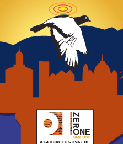
Where Art Thou Net.Art?
Conference Report: Where Art Thou Net.Art? On Zero One/ ISEA 2006 by Randall Packer :: Commissioned by Rhizome.org :: The long awaited Zero One/ ISEA 2006 took over San Jose, California, two weeks ago in a sprawling, city-wide, mega-festival celebrating art and technology in the heart of Silicon Valley. Much has already been written about it, from daily observations in the local papers to a feature in the New York Times, from the Blogosphere to the listservs. As one who has been immersed in the new media scene since the late 1980s, I would like to contribute a bit of historical context to the discussion: I offer my commentary from a pre-millennial perspective, when the dream emerged in the 1990s, during an era of optimism and promise, the dream of a new art form that would side-step a mainstream art world mired in curators, museums, galleries, objects, and old aesthetic issues. This was the dream of Net.Art, a revolutionary new international movement of artists, techies, and hackers, led in large part by the unassuming, unabashedly ambitious new media curator from the Walker Art Center, Steve Dietz, now director of Zero One.
These were heady times indeed. I met Steve in 1997 while I was in residence at the San Jose Museum of Art. His research had brought him to the holy Mecca of new media, Silicon Valley and the community of artists in the Bay Area who had been working with new technologies since the dawn of the personal computer. He wanted to meet Joel Slayton (who would later become director of the 2006 ISEA Symposium), so I escorted him over to San Jose State University where Joel is head of the CADRE Laboratory for New Media.
Shortly thereafter, Steve launched two groundbreaking Net.Art exhibitions, Shock of the View, and Beyond Interface, both of which brought together leading Net artists exploding on the scene: Mark Amerika, Natalie Bookchin, Masaki Fujihata, Ken Goldberg, Eduardo Kac, Jodi, Mark Napier, Alexei Shulgin, to name just a few. It was a time of artistic transformation, new paradigms, hypernovels, distributed authorship, and globally extended, real-time, robotic, collective art. It seemed anything was possible. By 1999, David Ross was Director of the San Francisco Museum of Modern Art, Intel was pouring millions into Artmuseum.net, and there seemed no end to the surging tide of experimental new media art. It was at that time that early discussion began of an international festival of art and technology in Silicon Valley. Beau Takahara founded the organization Ground Zero, which would later become Zero One.
But with the new millennium the tides would turn: Natalie Bookchin announced the death of Net.Art, the tech boom was a bust, and both David Ross and Steve Dietz were ousted from their museum jobs for harboring visionary aspirations in an economic downturn. So with the announcement that the Zero One Festival and the ISEA Symposium would launch in 2006 in San Jose, with Steve Dietz at the helm, it was something like the Phoenix rising from the ashes.
And it rose with a bang! "Seven Days of Art and Interconnectivity," with over 200 participating artists, an international symposium, city-wide public installations, exhibitions, concerts, performances, pubic spectacles, performative-live-distributed cinema, wi-fi interventions, container culture, skateboard orchestras, digital dance, sine wave surfing, datamatics, surveillance balloons, a pigeon blog, the squirrel-driven Karaoke Ice Battle on wheels, and to top it off a nostalgic, bombastic blast-from-the-past from Survival Research Laboratories. The 13th International Symposium on Electronic Art Exhibition took over the sprawling South Hall at the Convention Center. Its themes: Interactive City, Pacific Rim, Transvergence, Edgy Products, and on and on... spoke of enough technology to wire a third world nation.
And so, with all the buzz, and the sheer largesse of this ambitious festival of new media, I couldn't help ponder how it was connected to the original Net.Art dream, when a new art form arose from networking every computer on every desktop and engaging a global audience in new, pervasive ways that became possible as technology was increasingly ubiquitous and transparent. The Net.Art dream would call into question our relationship to the new media, as art has always aspired, to critique its impact on our lives, our culture, our communications systems, our relationships, our view of the world, our own changing humanity in a technological world. I couldn't help but to wonder, what exactly happened to that dream, once driven by a small fringe core of artists, writers, thinkers, and curators, and now practiced by literally thousands of techno-artists emerging from every university and art school across the planet, many of whom converged in San Jose for Zero One / ISEA.
The first thing that came to mind was that art and technology no longer exists on the fringe of the artworld, and in fact, the demarcation between art and engineering has blurred considerably. At Zero One you couldn't tell the artist from the engineer (Billy Kluver must be rolling in his grave). Joseph Beuys' notions of social sculpture, or Allan Kaprow's participatory Happenings now inform the new systems of art that have dissolved the distinction between artist and non-artist, between performer and audience. For example, the Interactive City theme, organized by Eric Paulos, sought "urban-scale projects for which the city is not merely a palimpsest of our desires but an active participant in their formation."
In the installations of Jennifer Steinkamp at the San Jose Museum of Art, I saw suburban moms taking snapshots of their kids in strollers bathed in layers of colored light. In the Listening Post by Mark Hansen and Ben Rubin, also at SJMA, the artists orchestrated chat room discussion, in real-time, from around the globe. Etoy's mesmerizing Mission Eternity involved a trailer installation parked outside SJMA in the downtown Plaza, which investigated personal data storage for the afterlife (ashes to ashes, bits to bits).
There was good art and there was bad art, but everywhere you turned there was art or something like art permeating the physical spaces of downtown San Jose (including the mobile light rail cars and the dome of City Hall), as well as the invisible ether of the airwaves, from bluetooth networks to cellular tours (the latest rage). There was very little time to spend with any particular work. Everyone was engaged in high gear, moving from one venue to the next. In Bill Viola's keynote address, he made the prescient remark, "artists are jumping into a train for a high speed ride while they're still laying the tracks ahead."
The hyper-adrenalin flow resonated in the on-line commentary as well, where, if you read the considerable Blog chatter surrounding Zero One/ISEA, you would find that the experience became concentrated on sheer movement and the social networking that reigns supreme at all conferences and festivals.
And so what about the dream of Net.Art? Those of us who have spent countless hours, in the past decade, bemoaning the loss of the dream could now say that the dream had been realized (for better or for worse). I heard artist friends complain about the democratization of Net.Art, the selling out of Net.Art, the "mainstreamization" of Net.Art, and other remarks I won't mention here,
and yet, I think that we would all agree that the uber-dream of Net.Art -- to dismantle the precious nature of the object, an art that would defy the walls of the museum, that would, as expressed in Roy Ascott's Museum of A Third Kind, reject the notion of the physical museum space altogether, the dream of Net.Art as a force that would rewire the experience of art, a "fantasy beyond control" according to Lynn Hershman -- had become a living, breathing reality in San Jose for those compressed seven days.
And if you turned to the Blogosphere there were plenty of critics: Patrick Lichty wrote, "There are many topics, like locative media, data mapping, ecologies, and so on that are being explored. On a rhetorical level I have to ask whether these are the right ones and why these are the ones that are compelling to us." And on the CRUMB list, I found an insightful comment by Molly Hankwitz, who said, "I think the process of interaction must be done very carefully. The worst thing is the mainstreaming of situationism into a middle class playground."
Finally, I turn to Mark Amerika, one of the original dreamers, for a closing observation: "Net art is in many ways still the most alive and accessed art movement ever to NOT be absorbed into the commercial art world and that's fantastic!" Perhaps the success of Zero One / ISEA was in its commitment to concentrate on experimental media art, to emphasize media art's inclusive, democratic, and participatory nature, and lastly, that contemporary art must embrace the new technologies - shamelessly, fearlessly, defiantly. Net.Art may be dead, but Net Art 2.0 is alive and kicking.
Randall Packer is a widely-exhibited artist, composer, educator, and scholar. He is Assistant Professor of Multimedia at American University in Washington, DC, and the author of Multimedia: From Wagner to Virtual Reality.
Posted by jo at 06:01 PM | Comments (0)
aMAZElab
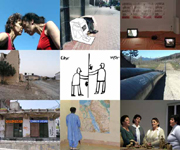
Urban Interventions + Cultural Exchanges
aMAZElab: Urban interventions, workshops, films, debates, cultural exchanges, publications :: aMAZElab is a non-profit cultural lab based in Milano, which works for the diffusion and knowledge of contemporary cultures. Founded and directed by Claudia Zanfi and Gianmaria Conti, promotes projects and events on social-territorial research, cultural interchanges and micro-geographies. At its 5° birthday, aMAZElab develops over 2006 summer/autumn a series of activities and appointments for reflection and research, such as:
20 September/10 October 2006 :: Nicosia, Cyprus :: Transcrossing memories (urban installations) :: "The Memory Box" is a mobile device to collect popular history from the common people. This bilateral intervention will serve as a travelling public space open to everyone, and will host various presentations, artistic projects, readings, video, debates, performances etc… The project is held in collaboration with Artos Foundation Nicosia, Ashik Mene Studio, Art schools, theoreticians, architects and artists in Cyprus, from both sides.
The “Memory Box” is a concept by Gianmaria Conti, designed in collaboration with Bauhaus University, Weimar (Germany).
aMAZElab, Via Cola Montano 8 20159 Milano, ph-fax 02 6071623 info[at]maze.it
Posted by jo at 09:40 AM | Comments (0)
Practice, Power, Politics, and Performance

A Symposium in honor of Allan Pred
[...] I am totally unconcerned with the disciplinary limits of geography, but fully concerned with geography as an ontological condition, as an inescapable existential reality. Everybody has a body, nobody can escape from their body, and consequently all human activity -- every form of individual and collective practice-- is a situated practice and thereby geographical. I regard the invisible geographies of power relations and meaning/discourse as every bit as "real" as the visible geographies of the built landscape and actual human activity. Whether exploring the historical geography of past and present urban modernities, or the production of gendered and "racial" difference, I am always preoccupied with the complex and multi-scaled processes through which visible and invisible geographies emerge out of one another. [...]
I take writing and questions of representation very seriously, believing that there should be some congruence between my textual strategy and the subject matter I am dealing with, between the way in which I write and what I am writing about. I look forward to the day when the watchdogs of academic style lose their teeth and it will not be considered out of line to submit Ph.D. dissertations in CD-Rom format, where text, sound and image are fused with one another. [...] [via nicholas senn on critical spatial practice]
Posted by jo at 09:30 AM | Comments (0)
Dislocation

Environment of Deception and Uncertainty
Dislocation, by Alex Davies, attempts to create a mixed reality environment in which the virtual world inhabits the viewers' physical reality. The exhibition room is empty, apart from four small inset screens. Concealed from the visitors, a camera is embedded in the rear wall, and an array of eight speakers is mounted within the walls around the floor of the room.
Visitors need to approach the monitors closely to see what they are showing. After a moment they realise that what they see is their own back (recorded by the hidden camera), and those of the neighbours peering at the adjacent monitors. After a while, the screen flickers slightly, as if there is a minor disruption in transmission, and people -- pre-recorded and superimposed onto the live image -- enter the gallery, one can even hear their movements within the room. It is easy to mistake to pre-recorded images as people in the room with you at the same time.

Apparently, a significant proportion of gallery visitors do a "double take" at this moment, looking in the screens, turning around to clarify their reference of reality and then returning their gaze to the portals to verify what they think they perceived.
Other work by Alex Davies: drift, a sightseeing telescope allowing the viewer to elastically manipulate time and space. [blogged by Regine on we make money not art]
Posted by jo at 09:08 AM | Comments (0)
Interactive Architecture dot Org X 4

Robotic Art
You Move Me (Work in Progress) by Lara Greene [cable tests movie 58MB - requires QuickTime] :: The figure is a fully articulated machine that moves via cables extending out from within the body to multifunctioning levers that can be pushed pulled and twisted to create various movements and affect it's position in space. A group of up to 6 people will be required to operate the piece, these being visiting members of the public. The figure has the capacity for elegance or awkwardness, dependent upon the level of people's control and ability or desire to co-operate with each other. People will struggle with or surmount this challenge, as she responds and embodies these conditions the character will come to life allowing people to empathise and respond in return. You move me is a tool for expression that draws people together in a web of interdependency provoking many forms of communication. [via Interactive Architecture dot Org]
Hysterical Machines - Bill Vorn
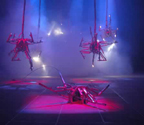
Bill Vorn is working in the field of Robotic Art since 1992. His installation projects involve robotics and motion control, sound, lighting, video and cybernetic processes. He pursues research on Artificial Life (and Death) and Agent Technologies through artistic work based on the Aesthetics of Artificial Behaviors.
Each Hysterical Machines has a spherical body and eight arms made of aluminum tubing. It has a sensing system, a motor system and a control system that functions as an autonomous nervous system (entirely reactive). Some machines are suspended from the ceiling and their arms are actuated by pneumatic valves and cylinders. Pyroelectric sensors allow the robots to detect the presence of viewers in the nearby environment. They react to the viewers according to the amount of stimuli they receive. The perceived emergent behaviors of these machines engender a multiplicity of interpretations based on single dynamic pattern of events.
The aim of this project is to induce empathy of the viewer towards characters which are nothing more than articulated metal structures. The strength of the simulacra is emphasized by perverting the perception of the creatures, which are neither animals nor humans, carried through the inevitable instinct of anthropomorphism and projection of our internal sensations, a reflex triggered by any phenomenon that challenges our senses.
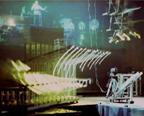
The Mechanized Eccentric Performance Series
Louis-Philippe Demers is a multidisciplinary artist using machines as media. He has worked on the conception and production of several large-scale interactive robotic installations, so far realizing more than 225 machines. 'In a more pronounced way than traditional theatre, mechanical theatre becomes a space for a collective consensus of the acceptation of simulacrum (even more surreal). The level of abstraction of the mechanical theatre enables a multiplicity of interpretation, it is an open ended work where each person sees a reflection of its own feelings.' (See Video)
The Mechanized Eccentric Series is a collection of several installations and performances united together in a large spectacle.
The Series regroups:
L'Assemblee, 48 robots layed out on an arena;
Colony 001, 8 robots and 1 central robots, a comment on nanotechnology;
Colony 002, 8 robots caught in cages;
The robotic characters of Armageddon (an operetta for robots) and a choir of 12 members;
and the two main robots of Le Proces.
Each robot is equipped with speaker(s), light(s) and motion(s) enabling the whole environment to become a vast surround soundscape. Namely, the performances include 6 voices of ambient sound plus a range (8 to 32) of independent robot sounds.
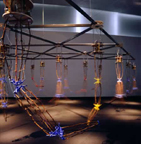
I thought after a week mainly showing some robotics based projects, I'd post a little about one of my favourite pieces of work by one of my favourite artists, Ken Rinaldo. Video
Ken Rinaldo is an artist and theorist who creates interactive multimedia installations that blur the boundaries between the organic and inorganic. He has been working at the intersection of art and biology for over two decades working in the catagories of interactive robotics, biological art, artificial life, interspecies communication, rapid prototyping and digital imaging. Rinaldo teaches interactive robotic sculpture, digital imaging, multimedia and Directs the Art and Technology program in the Department of Art at The Ohio State University in Columbus Ohio.
It consists of fifteen robotic sound sculptures that interact with the public and modify their behaviors over time. These behaviors change based on feedback from infrared sensors, the presence of the participant/viewers in the exhibition and the communication between each separate sculpture. This series of robotic sculptures talk with each other through a computer network and audible telephone tones, which are a musical language for the group. Autopoiesis is "self making", a characteristic of all living systems which was defined and refined by Francisco Varella and Humberto Maturana. The interactivity engages the viewer/participant who in turn, effects the system's evolution and emergence. This creates a system evolution as well as an overall group sculptural aesthetic.
In Autopoiesis the robotic sensors compare their sensor data through a central-state controller, so the viewer is able to walk through the sculptural installation and have the arms interact both individually and as a group. Because each arm has its own on-board computer control, the overall speed of reaction is rapid and therefore, life-like. Local control always supercedes group control when a local sensor is aware of a human nearby. This also allows individual arms to show accuracy and delicacy of approach and avoidance when encountering the viewer/participant. At the tip of two of the arms, lipstick cameras project what they see onto the walls of the space. This gives the viewer/participant a sense of being observed by this artificial life robotic sculpture.
Also see Regine from wmmna's recent interview with Ken Rinaldo.
Posted by jo at 09:00 AM | Comments (0)
August 24, 2006
My Building and the Sheher
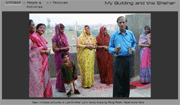
How is the idea of a community changing?
My Building and the Sheher, by Abhinandita Mathur and Venu Mathur, presents a visual essay on our building, where about 100 Mathur families reside. Shree Ganesh Group Housing Society is one of the many housing Societies in Patparganj that came up in the 80's, defining a new way of life for middle class Delhi.
The Mathurs are a close knit community and have a special relationship to the city of Delhi. Most families from this building can trace their history to the old city or Sheher.
This relationship between the community and the city was once well known and evident. It was apparent in the way of life, language, food, clothing and culture. The photographs document how the community has adapted to suburban living while continuing with some of its traditional ways. The project also contains an archive of these old traditions, such as typical songs and recipes of the community.
Through this assemblage of the present documentation and the archives of the past, this project attempts to map out the journey of the community and the city from the past to what it is today.
The project engages with the following ideas:
Social history
The history of the Mathur community and the city are closely related. Therefore by researching the history, studying the changing culture and documenting the community life of Dilliwale Mathurs the project attempts to correlate the history of the city and the community. Also, how does this community view the change in the city?
Community and culture
Certain cultural practices are developed and nurtured within a community setup. How has this Mathur community retained some of these cultural practices and how have these changed since the days of living in the Shahar? What strategies did the community develop to retain some of these cultural practices and how have they adapted to change?
Concept of community living
The community can be a site of conflict between the individual and society. The idea of personhood is determined by the competition between the individual v/s family v/s clan v/s caste v/s class v/s state… In the clash between tradition and modernity which of these social units are becoming more dominant over the others? How is this Mathur community facing up to these challenges?
Transforming communities
How is the idea of a community changing? No longer confined by physical and geographical proximity, old communities are using telecommunication technologies to retain and propagate their networks. How is this Mathur community coping with nostalgia? Is there a clash between the hardliners and the liberals and who is winning? Have the individuals of this community found stronger associations in newer communities based on alma mater, profession, class status, specific interests, political affiliations, sexual preferences, etc.?
[via sarai.net]
Posted by jo at 06:35 PM | Comments (0)
The Pong Dress
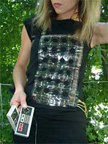
Body as Screen
The little black dress as erotic playground for pong? Max Moswitzer and Margarete Jahrmann alias Marguerite Charmante of the Ludic Society (and of the Nybble Engine fame) have crafted a Pong Dress to dissolute the boundaries between body and screen.
White LED's shine through the black front of the dress. At hip level, two retro-game consoles are offered to players to play Mini-Pong on a 5x7 LED screen worked into the dress. Two pixels move up and down as rackets to the left and right along the waist. With every achieved point, the green score display blinks at chest level.
Hit the dot back and forth with two sticks - this time all new on a 3D playing field, that is moving, chatting and laughing. we hit the dot with some spin from the height of the belly button and aim at the left nipple.
Check it at the Pong Mythos exhibition that just opened in Leipzig. More images.
The dress was inspired by Valie Export's Tap and Touch Cinema, 1968, in which the artist, a box attached to her naked chest, invited pedestrians in several European cities to "visit the cinema".
Via Selectparks. Related: Dress, a polypropylene dress fitted with small "counters" which offer glimpses of human flesh for "sale"; One ball, two bats and our life in a digital world. [blogged by Régine on we-make-money-not-art]
Posted by jo at 02:13 PM | Comments (0)
Improv Everywhere
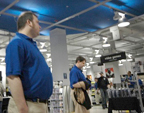
Operation Best Buy
Improv Everywhere is a group of agents (pranksters) based in NYC who organize missions (happenings) in public space. Their intent is to bring excitement to otherwise unexciting locales and give strangers a story they can tell for the rest of their lives. One of the group's latest missions took place in a Best Buy shop and was carried out by more than 80 agents.
The group met at a Best Buy shop all wearing blue polo shirts - almost identical to the store's uniform - where after they entered the shop and began circulating. They did not claim to work at the shop, however when a customer mistook them for an employee, they did their best to help out...Extensive documentation is available online. [blogged by Sebastian Campion on Guerrilla Innovation]
Check out Cell Phone Symphony, Suicide Jumper, and lots of their other missions.
Posted by jo at 12:30 PM | Comments (0)
The (New) Familiar Stranger
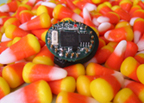
Subtle Connections and the Unknown
Wireless, mobile, digital technologies are rapidly transforming our relationship to people and place in public urban settings. The Familiar Stranger Project developed by Eric Paulos and Elizabeth Goodman from Intel Berkeley Lab, explores these devices implications that provide a loose connection (but no explicit communication) to those nearby whom we do not know - our 'Familiar Strangers'. Familiar strangers are individuals that we regularly observe, particularly in public urban spaces, but do not interact with. A good example is a person seen on the tube every morning: if this person fails to show up we suddenly notice it.
The claim is that the relationship we have with the familiar strangers is indeed a real relationship in which both parties agree to mutually ignore each other. And this familiarity with strangers help us to feel part of a group. However current trends in mobile phone usage increasingly divide people from co-located strangers within their community. In quirky situations or strange places in fact we use our mobile phones uncomfortably, dramatically decreasing the chances of interacting with individuals outside our social groups. The research goal is to use wireless devices to extend the social phenomenon of Familiar Stranger. Paulos and Goodman are not interested in designing a friends' finder, matchmaking device - strangers must remain stranger. Instead, they want to develop mobile devices to explore and play with our subtle connections to strangers and the unknown.
One of these prototypes is the Jabberwocky, a freely available mobile phone application that takes advantage of current Bluetooth device proliferation. Users of the Jabberwocky are able to visualize current and historical Familiar Strangers and places using collections of Bluetooth addresses. Importantly, other users do not need to use the application: the tool is entirely capable of detecting other Bluetooth mobile phone users. One of the most powerful elements of Jabberwocky is that it is not driven by the bits of an online network, but by actual real-life, by the movement and interaction (or non-interaction) of others who's path we cross. Therefore, the number of 'participants' is not simply the size of some database on a central server but a more powerful and personal membership in urban life. To be specific, every Bluetooth mobile phone user is within the Jabberwocky community. As Lewis Carrol would have written, "Beware the Jabberwock(y), my son!". Valentina Culatti, Neural.
Posted by jo at 11:50 AM | Comments (0)
One Hundred and Four Thousand
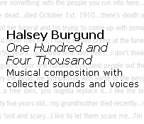
Call for Voice-Mail Contributions
One Hundred and Four Thousand :: Through the evocative memorials at Forest Hills, people from the past "speak" to us about their relationships and lives. Halsey Burgund uses 21st century technology to add a new layer of expression to this landscape. His sound collage combines music with fragments of conversation he collected during interviews at Forest Hills.
You can download the entire piece to your computer and iPod or listen online: I - Remembering the Dead [mp3 - 5:56] II - Life to Grow [mp3 - 2:16] III - I Just Want to Be Recycled [mp3 - 3:12] IV - How Infinite Memories Can Be [mp3 - 9:18] V - The Stately Oak and the Predatory Owl [mp3 - 4:23]
You can alternatively listen via cell phone by calling 617.344.6796; this system will also collect voice-mail contributions, which the artist will selectively incorporate into the piece on an ongoing basis.
"I wanted to explore the cemetery’s contemplative nature as well as the relationships that various cemetery ‘dwellers’ have to their surroundings. My intent was to create music that evokes my own personal feelings about spending time within the borders of Forest Hills through the words and voices of other cemetery dwellers.
Over the course of several months in early spring, I interviewed 26 people in the cemetery, both visitors and employees. I used these recorded interviews in tandem with traditional instruments. For listeners, the music and voices will mix with the ambient sounds, smells and sights they encounter as they make their way through the cemetery on paths of their choosing." -- Halsey Burgund
Posted by jo at 09:53 AM | Comments (0)
August 23, 2006
Recursive Instruments
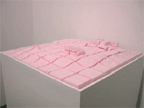
The Value of Translating the Virtual to the Real
Recursive Instruments is generously supported by Linden Lab through their Fellowship for the Visual and Performing Arts ... The value ascribed to objects, scripts, textures, and land in Second Life contrasts sharply with the value given to similar, material wants. Digital work cannot yet economically compete with comparable real world services. Our initial proposal to Linden Lab investigated these different markets of exchange. The ease of copy and paste undermines traditional economic practice. Without an original—a gold standard—the Linden faces an uphill battle to establish value in the minds of others. We believe that a body of images, objects and ideas exterior to Second Life is of paramount concern for a sustainable environment.
Just as [Simon Spartalian's] words and these slides communicate between you and I, so must Second Life use its content to communicate with culture. Tangible objects can carry a vivid experience outside the world that gave them birth. Our work began at this intersection. Using the Open GL Extractor (OGLE) from OpenLab and EyeBeam Research in NYC we can capture the 3D data behind Second Life. We have a Computerized Numerical Control (CNC) mill for the purpose of carving objects built from this data. Our first construction centered around the landscape of Sheep Island, a Sim which we printed, section by section (acre by acre), into the real world. Read more >> [Related post]
Posted by jo at 11:33 AM | Comments (0)
Seven Maps
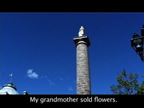
Call and Response
When filmmake /videoblogger Daniel Liss challenged himself to make 7 videos in 7 days, he also challenged his online audience to collaborate with him in the process. His daily assignments came from viewers of his videoblog who determined where, about what and how he should make each video.
Each day, they posted an assignment and each day Daniel posted a video in response. Then came praise and criticism in the comments of each day's videoblog post. The process took him miles from home, he told personal stories, invented new narratives, and played more than a few tricks on his guiding/goading audience.
For this video he was given the assignment, 'oday, you are a local. Trick us into believing that you are a local. Tell us a story about your history.' The entire Seven Maps series can be seen here : http://pouringdown.tv/sevenmaps [blogged by mica scalin on DVblog]
Posted by jo at 08:47 AM | Comments (0)
[iDC] Interactive City: irrelevant mobile entertainment? Part 3
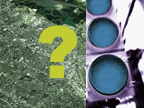
Anna Munster's Response
Steve, John and others,
I'm glad that you, Steve, took the time out to interact with this discussion and to add some of your comments about the background and intent to some of the projects and themes you worked on. I think this is important information to have because, in fact, it can be then passed on, informally to others in terms of organisational and process 'notes'
Without wanting to detract from the fact that you and Joel and many,many others obviously put a great deal of work into the event (and I have been involved in conference organisation and know that it's long, hard and thankless), I still think you have to take account of the fact that many people who went to this year's ISEA and 01 Festival think it didn't work. This is evidenced from: this and other list discussion, everybody I ran into commenting upon this while there and various blogs. It's ok for something not to work. You should also be aware that there were many individual events and particularly curated aspects that did work, were enjoyed. The point is why did it not work overall and how can things change toward something more productive in the future.
It didn't work NOT because you didn't put a huge amount of work into it. It didn't work for all the reasons that people have been speaking of on this list:
- irrelevant or not completely articulated and worked through themes.
- a general sense of experiencing the relationship to the city of San Jose and its space and architecture as dislocated, nonlocated, delocalised. And while you list various projects that did try to work with place and community this did not come across as a major experience for many who participated over the 7-10 days.
-a sense that too much was trying to be achieved in too many disparate spaces. That's a case of being over-ambitious and obviously under-resourced. Less things more tightly drawn together might well remedy this. People do not need to be constantly entertained but rather thoughtfully provoked.
-a sense among many artists and thinkers and cultural producers that there are terribly more urgent issues at stake right now and that there is responsibility from a critical, artistic community holding any event in the US now to foreground these issues: imperialism / empire / nonempire, war / ethics, technology / military, poverty / human rights, precarity / labour / illegality, paranoia / regulation / deregulation, fundamentalism etc etc...
I also believe that this is the creative responsibilty of a country such as Australia right now and pointed to the Sydney Biennale as an example of another lost opportunity in this area.
I did not expect ISEA to be smooth, slick or perfect. I expected chaos and the rough and ready...However what I primarily took away from the event overall was a kind of disconnected emptiness. Unfortunately I did see a kind of biennale structure being emulated and this is quite possibly an effect of the scale of the projects ISEA is trying to achieve. In the Pacifc Rim summit the point was made a number of times that small-scale, localised participation in relation to locale can often be more successful an experience for participants. I have to say I agree.
As for John's comments about the devolution of Anglo-American societies toward fascism at the moment - yes, I couldn't agree more. I certainly don't exempt my own 'nation' from that either. I returned to a whole bunch of news reports about outbreaks of anti-semetic and anti-islamic graffiti and desecration of mosques and synagogues throughout Sydney. We are just as racist a country and it is State sanctioned racism similarly buffeted by organised fundamentalist religions.
But what I did really sense from going to the US (and this is not the first time - I spent about 3 months in NY in 2004 during the period Steve Kurtz was arraigned and have been back and forwards many times b4 that) was the very deep level of militarisation of every aspect of civilian life. To me this is fundamentally frightening and the most obvious sign that we have moved headlong into neofascism...what is to be done, socially, culturally...has never been a more pertinent question...
Best Anna
A.Munster at unsw.edu.au
Dr. Anna Munster
Senior Lecturer,
Postgraduate Co-ordinator
School of Art History and Theory
College of Fine Arts
University of New South Wales
P.O Box 259
Paddington,
NSW 2021
ph: 612 9385 0741
fx: 612 9385 0615
iDC -- mailing list of the Institute for Distributed Creativity iDC[at]bbs.thing.net http://mailman.thing.net/cgi-bin/mailman/listinfo/idc
List Archive:
http://mailman.thing.net/pipermail/idc/
Posted by jo at 08:40 AM | Comments (0)
August 22, 2006
[iDC] Interactive City: irrelevant mobile entertainment? Part 2
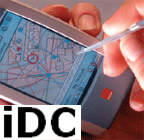
Mark Shepard's Response
It's encouraging to find such an outpouring of interest and critique on the subject of locative media and its relation to pyschogeography, mapping and urban play. While we had originally planned on addressing many of these issues in September as part of the Architecture and Situated Technologies thread, I think the current discussion provides an opening to address how an evaluation of certain locative media practices (and their failures) might provide a "sandbox" for thinking through the opportunities and dilemmas of a near-future world of networked "things". From locative media to atoms, bits and ubiquity.
As someone whose interest in the Situationists predates my work in new media, I have long felt uncomfortable with media art practices that claim or aspire to transpose concepts of pyschogeography and tactics of the dérive or detournment to contemporary urban environments. It is critical to remember that the dérive emerged in a specific historical context, one that I would argue no longer holds. In part a response to 20th century urban planning strategies promoted by modern architects associated with CIAM (Congrès International d'Architecture Moderne), the dérive sought to reclaim a space for the creative capacities of an imaginative subject in face of an onslaught of the functional rationalization of modern capitalism. CIAM's strategies aimed to reorganize the city - perceived as an ailing beast in need of a cure - through a strict functional segregation of dwelling, work and recreation (leisure) zones connected by rationalized transportation corridors.
Citing a 1952 study by Parisian sociologist Chombart de Lauwe that mapped the movements made in the space of one year by a student living in the 16th Arrondissement, Debord expresses outrage that her itinerary "forms a small triangle with no significant deviations, the three apexes of which are the School of Political Sciences, her residence and that of her piano teacher." [1] To a certain extent, the dérive was conceived to explicitly counteract this rationalization of patterns of movement through the city and the corresponding limitations imposed on the diversity, messiness, and richness of urban life. Understood as a form of ludic play, the expressed aim was to free people from "their relations, their work and leisure activities, and all their other usual motives for movement and action, and let themselves be drawn by the attractions of the terrain and the encounters they find there." With regard to kanarinka's comment about the gentleman invited to drift with them who "summed it up nicely" by saying "Sorry, I can't go with you. I have to work here until 8PM and then I have to go to my other job," I would argue that it is precisely this mentality that the dérive sought to address.
In evaluating locative media projects claiming or aspiring to a Situationist agenda, I often find myself questioning to what extent their deployment of mobile technologies ends up actually reifying this rationalization of patterns of use or movement. Put another way, to what extent do conventions for the use of consumer mobile technologies actually contribute to CIAM's agenda in their codification of modes of interaction with and within the contemporary city? Perhaps the most pertinent question for locative media might be: how might these technologies be (mis)used in an attempt to counteract (rather than reinforce) an ongoing rationalization and commodification of urban life? It would seem less a question of "locating" oneself, perhaps more one of getting lost...
Brian Holmes' critique of locative media [2] focused on a perceived noncritical ("naive") adoption of GPS technologies and Cartesian mapping systems in the context of Situationist aesthetics. Specifically, Holmes attacks the non-reflexive use of technologies developed by the military and their domestication in the context of scenarios of play, where aesthetics becomes politics as decor. This critique was originally delivered at a workshop held at the RIXC center in Latvia in 2003. Since then the field has expanded significantly, and while early locative media projects may have relied heavily on these technologies, it would be difficult to identify locative media exclusively with either GPS or Cartesian mapping today. At the same time, some contemporary projects built on GPS are far more reflective of the dark side of locative media. [3] This is not to say Holmes' critique no longer holds. Quite the contrary, as it would seem it has been in many cases internalized by the field. While this year's ISEA / ZeroOne San Jose symposium and exhibition presented a few GPS-based locative media projects, they were by no means the majority. Drew Hemment et. al.'s LOCA project is one example of a "pervasive surveillance project" aimed at raising public awareness of how certain consumer technologies (bluetooth in this case) enable tracking in ever more subtle ways. [4] Alison Sant's paper "Redefining the Basemap" [5] addressed the fact that many locative media projects still "remain bounded by datasets that reinforce a Cartesian and static notion of urban space" and made a call for alternative methods of mapping the city, particularly ones addressing the temporal dimension of urban experience.
The critique of GPS and Cartesian mapping systems is by no means new. Laura Kurgan's exhibit "You Are Here: Museu" (1995) [6], addressed the uncertainties that arise when relying on satellite tracking systems to know "where we are." Architect Stefano Boeri's essay "Eclectic Atlases" (1997) [7] addresses the failure of satellite imagery to adequately represent the contemporary metropolis and calls for alternate methods for mapping the city as experienced "on the ground." The exhibition and catalogue for "The Power of the City: The City of Power" (Whitney Museum of American Art, 1992) [8] explores alternative mapping practices of conceptual and performance art from the 60s and 70s in terms their relation to Baudelaire's Flaneur, Jameson's notion of cognitive mapping, and (then) contemporary readings of Situationist aesthetics. Kevin Lynch, in his oft cited treatise "The Image of the City" [10], acknowledged that the emotional dimension(s) of his cognitive maps were beyond the reach of his research methods. More recently Marina Zurkow, Scott Patterson and Julian Bleecker's "PDPal" (2003) [9] asks what might an "emotional" GPS look like?
Perhaps the most interesting take on the relevance of locative media today is that of Marc Tuters and Kazys Varnelis as expressed in their essay "Beyond Locative Media," published by Leonardo in conjunction with the Pacific Rim Summit [11]. Acknowledging that locative media has been attacked for its ambivalence with regard to commercial interests and its reliance on Cartesian mapping systems, they find these critiques nostalgic, "invoking a notion of art as autonomous from the circuits of mass communication technologies", which they argue no longer holds. Moreover, they make the case for locative media as a "conceptual framework by which to examine the certain technological assemblages and their potential social impacts. Unlike net art, produced by a priestly technological class for an elite arts audience, locative media strives, at least rhetorically, to reach a mass audience by attempting to engage consumer technologies, and redirect their power." At the dawn of an age where ubiquitous networked objects outnumber humans as generators and receivers of information, this effort is more important than ever.
+++
[1] Guy Debord. "Theory of the Derive" - http://library.nothingness.org/articles/SI/en/display/314
[2] Brian Holmes. "Drifting Through the Grid: Psychogeography and Imperial Infrastructure" - http://www.springerin.at/dyn/heft_text.php?textid=1523&lang=en
[3] See the Institute for Applied Autonomy's "i-SEE - Now More than Ever" - http://www.appliedautonomy.com/isee.html or Annina Ruest's "Track the Trackers" - http://www.t-t-trackers.net/
[4] LOCA - http://www.loca-lab.org/
[5] Allison Sant. "Redefining the Basemap" - http://www.intelligentagent.com/archive/ia6_2_interactivecity_sant_baseline.pdf
[6] Laura Kurgan. "You Are Here: Museu" - http://www.l00k.org/youarehere/you-are-here-museu
[7] Stefano Boeri. "Eclectic Atlases" in The Cybercities Reader (NY: Routledge, 2003)
[8] Cristel Hollevoet, Karen Jones, Timothy Nye. "The Power of the City: The City of Power (NY: The Whitney Museum of American Art, 1992)
[9] Marina Zurkow, Scott Patterson and Julian Bleecker. "PDPal" - http://www.pdpal.com/
[10] Kevin Lynch. "The Image of the City" (MIT, 1960)
[11] Marc Tuters and Kazys Varnelis. "Beyond Locative Media" - http://netpublics.annenberg.edu/locative_media/beyond_locative_media
+
mark shepard
+
http://www.andinc.org
iDC -- mailing list of the Institute for Distributed Creativity (distributedcreativity.org) iDC[at]bbs.thing.net http://mailman.thing.net/cgi-bin/mailman/listinfo/idc
List Archive:
http://mailman.thing.net/pipermail/idc/
Posted by jo at 10:03 AM | Comments (0)
DANUBE TELE LECTURES
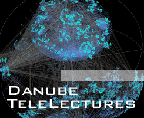
International Discussion - Innovative Image Direction
:: Inauguration of the DANUBE TELE LECTURES at Danube University Krems :: The Center for Image Science at Danube University Krems starts a new international lecture series in early September with prominent scientists of our time. The lectures will be presented by live online streaming technology. The series is realized in co-operation with the Österreichische Filmgalerie and the ORF Niederösterreich (Austrian Broadcast Corporation), and will be held in the Filmgalerie Cinema at Danube University Krems. For the inaugural Tele Lecture, internationally renowned scholars deal with key topics of Image Science and Media Art:
September 5, 2006 19:30-22:00 :: DOES THE WEST STILL EXIST? Are There Boundaries of West, East and Far-East in the World of Images Now? :: Lectures and debate with Sarat MAHARAJ and Machiko KUSAHARA: Hollywood, computer games, net and media art, micromovies, new devices* images are undergoing a new internationalization never known before, and are increasingly being charged as a vehicle of ideologies and worldview. Seemingly bygone clashes between image opponents and image believers are reanimated in contemporary media to include all areas of art, science, politics and economy - now on a global scale.
Can we still speak of images of the west today? Do we witness the arousal of a global visual language enriched universally by the various cultures, or are we at the brink of an ‘image war’, representing extremes between the old and new economic powers and their visual culture?
September 6, 2006 19:30-22:00 :: PYGMALION TENDENCIES: Bioart and Its Precursors :: Lectures and debate with Gunalan NADARAJAN and Jens HAUSER
Art and the natural sciences are forming a new interconnection that is closer than in past centuries. Recent developments in art such as Bioart, Techno-art, Genetic or Transgenic Art bring artists into the scientific laboratories and carry their visions to the general public. Not only do artists work cross-pollinated, they also create new creatures, frequently revealing spectacular spaces of reflection on new possibilities. International experts discuss these tensions oscillating between body and nature on one hand and artificial life and illusion on the other - none the least, in their historical contexts.
International Discussion over the Net - Innovative Image Direction
The DANUBE TELE LECTURES is a continuation and extension of the first international conference on MediaArtHistories Refresh!, which was held under the direction of Oliver Grau in Banff/Canada last fall und will see a remake called re:place in Berlin next year. Two cameras innovatively echo the studio character and seek a virtual intimacy with the lecturers and their audience. Internet viewers from all over the world have the possibility to pose email questions, broadening the international debate character of this event. Videos of the Danube Tele Lectures will be available in an online archive.
:: More at http://www.donau-uni.ac.at/cis ::
You can join us live in Krems or watch online and participate in the discussion via email.
The CENTER FOR IMAGE SCIENCE at Danube University Krems is an institution for inovative research and teaching on the complete range of image forms. The Center is situated in the beautiful Wachau, Austria - a UNESCO world heritage site - in the Goettweig Monastery and is housed in a fourteenth century castle. It is the base of the public documentation platforms www.virtualart.at and www.mediaarthistory.org. The Center's new low residency postgraduate master's programs in MEDIAARTHISTORIES, PHOTOGRAPHY, and IMAGE MANAGEMENT are internationally unique.
contact information: wendy.coones[at]donau-uni.ac.at :: +43 (0)2732 893-2543
Directions to Krems - 60km west of Vienna towards Linz - www.donau-uni.ac.at/route; Shuttle Krems-Vienna offered; reserve your seat at the Filmgalerie Cinema (entrance is free).
Posted by jo at 09:44 AM | Comments (0)
Vida 9.o
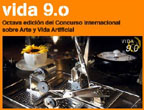
Eighth Art & Artificial Life International Competition
VIDA 9.o is the eighth edition of an international competition created to reward excellence in artistic creativity in the fields of Artificial Life and related disciplines. We are looking for artistic projects that address the interaction between "synthetic" and "organic" life. The international jury will grant awards to the most outstanding projects. Prizes: 1st Prize: 10,000 euros :: 2nd Prize: 7,000 euros :: 3rd Prize: 3,000 euros :: Incentive for Productions from Latinoamerica, Spain and Portugal: 20,000 euros.
Dates: Monday October 16, 2006 - Deadline for presenting the projects :: November 2-5, 2006 - Judging panel deliberates in Madrid :: November 6, 2006 - Winners are announced at round table.
Contact: Email: angeles.perezmuela[a]telefonica.es :: Tel: +34 91 584 23 05
Posted by jo at 09:36 AM | Comments (0)
August 21, 2006
DemoKino

Virtual Biopolitical Agora
DemoKino: Virtual Biopolitical Agora by Davide Grassi :: An Anti-entertainment interactive movie, that develops according to your vote! :: DemoKino is a virtual parliament that through topical film parables provides the voters (participants) with the opportunity to decide on issues that are, paradoxically, becoming the essence of modern politics: the questions of life. The project questions not only the utopia of contemporary virtual forum that is supposed to open ways for a more direct and influential participation but also points out a much deeper problem of modern democracy (virtual as well). With its reduced narrativeness - the story is built on the "pro and contra" inner dialogues of the protagonist who is led around his home in a parliamentary kind of way by the "voters", based on their decisions - Demokino shows how these ethical dilemmas of modern life suddenly become the core of our political participation.
When the issue of life enters the political arena and modern politics becomes biopolitics the democratic decision reaches an impasse: in the political arena laws are being debated on issues that can actually tolerate no decisions and any kind of majority rule is problematic in itself, any political regulation a publicly legitimated act of violence. Demokino is a virtual parliament that clearly displays how politics comes before law. Law is just a utopic and redundant technical procedure to cover the political essence. [via]
Posted by jo at 06:27 PM | Comments (0)
PLAY.Orchestra
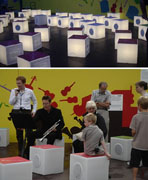
Sit and Play
If you go down to the South Bank in London this summer, outside the Royal Festival Hall is a wonderful installation titled PLAY.Orchestra. 56 plastic cubes and 3 Hotspots are laid out on a full size orchestra stage, each cube containing a light and speaker. Sit down on the cube or stand in the hotspot to turn on that instrument and bring 58 friends to hear the full piece. People with Bluetooth phones will be able to receive a ringtone of the piece created, as well as upload their own sound samples in September.
The production blog gives an interesting insight into the installing process & the complexity of the project. PLAY.orchestra is the result of a collaboration between Central Saint Martins College of Art & Design MA Creative Practice for Narrative Environments, South Bank Centre Education and the Philharmonia Orchestra.
Daniel Harris at Central Saint Martins was involved in the project from the beginning, details from his site:
"I was then responsible for the various human, computer and physical interfaces used in the build. 2 miles of cable are used to connect the 60 seats with the control system, which runs on a midi based Max MSP system.
The Objective was to get non-traditional audiences to experience an orchestra from new angles, and to involve themselves in activity of the philharmonia orchestra. For this purpose, a bluetooth system was set up, where members of the public can submit their own samples for composers to put together into a piece that will be played in the last few weeks of the installation."
IamtheMightyJungulator were also involved in the software side.
Photos stolen from Dan Harris Flickr Set.
(thanks for the tip Leslie, via BBC News) [posted by chris on Pixelsumo]
Posted by jo at 05:12 PM | Comments (0)
Research on Social Network Sites

Publishing in Peer-Reviewed Spaces?
I want to track down everyone who is actively doing research on social network sites. (Clarification: i'm looking for folks that are publishing in peer-reviewed spaces, not just researching for their company or blog.) Nicole Ellison and i are plotting to bring ways to bring everyone together. I'm also looking to create a list of all known publications. I know there's more than what i'm listing so i need your help. Please!
Researchers :: :: Alessandro Acquisti (privacy, Facebook) :: danah boyd (youth culture, identity performance, MySpace, Friendster) :: Judith Donath (signal theory) :: Nicole Ellison (Facebook) :: Ralph Gross (privacy, Facebook) :: Hugo Liu (music tastes, Friendster) :: Derek Lomas (reciprocity, MySpace) :: Alice Marwick (identity, Friendster) :: Jenn Mankoff (environmentalism, MySpace) :: Dan Perkel (literacy, codes, MySpace) :: Raquel Recuero (social capital, Orkut) :: Larry Rosen (predators, MySpace) :: Fred Stutzman (Facebook)
Publications and Presentations: :: Acquisti, Alessandro and Ralph Gross. 2006. "Imagined Communities: Awareness, Information Sharing, and Privacy on the Facebook." Privacy Enhancing Technologies. Cambridge: June 28-30.
:: Adamic, Lada, Orkut Buyukkokten, and Eytan Adar. 2003. "A social network caught in the Web." First Monday.
:: boyd, danah. 2007 (in review) "None of this is Real."
:: boyd, danah. 2006. "Identity Production in a Networked Culture: Why Youth Heart MySpace." Talk as AAAS 2006 (part of panel: "It's 10PM: Do You Know Where Your Children Are ... Online!"). St. Louis, Missouri: February 19.
:: boyd, danah and Jeffrey Heer. 2006. "Profiles as Conversation: Networked Identity Performance on Friendster." Proceedings of the Hawai'i International Conference on System Sciences (HICSS-39) , Persistent Conversation Track. Kauai, HI: IEEE Computer Society. January 4 - 7.
:: boyd, danah. 2004. "Friendster and Publicly Articulated Social Networks." Conference on Human Factors and Computing Systems (CHI 2004). Vienna: ACM, April 24-29.
:: Donath, Judith and danah boyd. 2004. "Public displays of connection." BT Technology Journal Vol 22, No 4. October, pp 71-82.
:: Ellison, Nicole, Charles Steinfield, and Cliff Lampe. 2006. "Spatially Bounded Online Social Networks and Social Capital: The Role of Facebook." Paper presented at the annual meeting of the International Communication Association, Dresden, June 19-23.
:: Gross, Ralph and Alessandro Acquisti. 2005. "Information Revelation and Privacy in Online Social Networks." ACM WPES Workshop.
:: Heer, Jeffrey and danah boyd. 2005. "Vizster: Visualizing Online Social Networks." IEEE Symposium on Information Visualization (InfoVis 2005). Minneapolis, Minnesota, October 23-25.
:: Liu, Hugo, Pattie Maes, Glorianna Davenport. 2006. "Unraveling the taste fabric of social networks." International Journal on Semantic Web and Information Systems 2(1), 42-71, Hershey, PA: Idea Academic Publishers.
:: Marwick, Alice. 2005. "'I'm a Lot More Interesting than a Friendster Profile': Identity Presentation, Authenticity and Power in Social Networking Services." Association of Online Internet Researchers. Chicago.
:: Perkel, Dan. 2006. "Copy and Paste Literacy: Literacy Practices in the Production of a MySpace Profile." Informal Learning and Digital Media. Odense Denmark: September 21-23.
:: Recuero, Raquel. 2005. "Um estudo do capital social gerado a partir das Redes Sociais no Orkut e nos Weblogs." Trabalho apresentado no GT de Tecnologias da Comunicacao e da Informacao da COMPOS 2005, em Niteroi/RJ. (in Portuguese)
:: Spertus, Ellen, Mehran Sahami and Orkut Buyukkokten. 2005. "Evaluating similarity measures: a large-scale study in the orkut social network." Conference on Knowledge Discovery in Data.
:: Stutzman, Frederic. 2006. "An Evaluation of Identity-Sharing Behavior in Social Network Communities." iDMa Journal. [posted by zephoria on apophenia]
Posted by jo at 04:04 PM | Comments (0)
RELIQUARY OF LABOR - Parallel Media Project
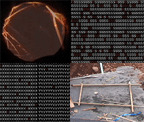
A Participatory Art Experience
The New Britain Museum of American Art is pleased to announce the performance of the participatory art experience Reliquary of Labor, a multi-media collaboration between media artist Gene Gort, composer Ken Steen, and electronic cellist Jeffrey Krieger. The project, designed as what the producers’ term "parallel media" -- a single project or phenomena experienced through various distribution systems and performance venues -- takes as its inspiration the creative process as a product of labor. Using the Museum’s building expansion as their source material, they have harvested video and sounds of the museum's new construction to develop a multi-media performance for video, electronic cello, percussion ensemble and pre-recorded sound.
Reliquary of Labor explores the collaborative process among artists, observes and reveals beauty in the ordinary, and celebrates the idea of labor as integral to any art work or production; that architecture, music, writing, visual art, or any creative endeavor doesn't merely appear out of the atmosphere. The artists seek to make their collaborative process transparent for the audience and, in keeping with the idea of "parallel media", have launched the website. It contains project updates and works-in-progress for viewing and downloading, as well as podcast material. Visitors to the site are encouraged to use sound, stills, and videos from the project for their own work through the "creative commons" license and to submit processed files for reintegration into the project.
A preview of the project/experience will be held on Thursday, August 31, 2006 from 4 p.m. – 6 p.m. The premiere will be held on Sunday, November 26, 2006 at 2:30 p.m. in the new Chase Family Building of the New Britain Museum of American Art.
BIOS:
Gene Gort is a visual artist, video producer, media programmer and educator. His videotapes, installations and digital imaging projects have been presented internationally including La Casa Encendida, Madrid, Spain; DeCordova Museum and Sculpture Park, Lincoln, MA; Pacific Film Archive/Berkeley Art Museum, Berkeley, CA; TheVideoArtFoundation, Barcelona, Spain; Cyberarts Festival, Boston, MA; Real Art Ways, Hartford, CT; Black Maria Film and Video Festival, touring. He has received two nominations from the Rockefeller Foundation Fellowship Program, received two MacDowell Colony Fellowships (2006 & 2004) and received grants from the Connecticut Commission on the Arts and the Pollack-Krasner Foundation. Gort holds the position of Associate Professor, Media Arts at the Hartford Art School, University of Hartford, a program he designed and directs.
Jeffrey Krieger, e-cellist and specialist in the performance of new music, is principal cellist of the Hartford Symphony Orchestra. He is among the new generation of solo recitalists who have incorporated technology - the computer and video - as well as an electronic cello built by Vermont craftsman Tucker Barrett into performance. Mr. Krieger’s many awards includes a 1993 Solo Recitalist Fellowship from the National Endowment for the Arts which allowed extensive touring in the USA performing concerts and workshops. He has collaborated with composers such as Virgil Thompson, Ned Rorem, Kaija Saariaho, Donald Erb, and Alvin Lucier, as well as numerous emerging composers. His own interactive video improvisation, Videocello, was chosen by American Composers Forum to be included on their touring program, Sonic Circuits, resulting in a performance at the Kennedy Center.
Ken Steen's music sits squarely on the frontier between the acoustic and electronic domains of musical expression; often combining traditional orchestra, chamber ensemble or soloist with electronic instruments or processed sound and noise. He recently received a MacDowell Colony Fellowship (2006), a Fellowship from the Connecticut Commission on Culture and Tourism (2005) and a residency at the Artist's Enclave at iPark (2004). Recent premiere performances and sound installations in such diverse locations as Xi'an, China, Fortaleza-Ceará, Brazil, Spring in Havana Festival, Havana, Cuba, Merkin Concert Hall in NYC and the Australian Centre for Contemporary Art in Melbourne, Australia, confirm that his work is fast attaining international recognition. Steen is currently Associate Professor of Composition and Theory and director of Studio D at the Hartt School, University of Hartford.
Posted by jo at 02:41 PM | Comments (0)
Cardiomorphologies
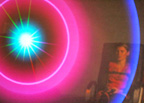
The Body as an Instrument
"George Khut is an artist working in the area of immersive and interactive installation environments. His research focuses on the development of interactive sound and video environments where users experience and learn to influencial aspects of their own psycho-physiological processes by reckoning changes in the sound, colour and form of the artwork. His latest project, Cardiomorphologies (now version 3.0) is an interactive installation that uses technologies and principles of heart rate variability and biofeedback training for this purpose. The biofeedback training, in fact, enables people to obtain voluntary control over various physiological processes providing an instantaneous electronic display of body functions. In this case breath and heart data, collected by a pressure sensitive strap placed around user's upper rib and by two sensors held in his hands, are used to control a large video projection. The video consists of a halo-like concentric circles that pulsate and change colour according to heart and breath rhythm. Heartbeats and breathing are also transformed into sounds emitted by speakers so that the user, sat in a comfortable chair, can watch his own 'bodysong'. According to Khut, Cardiomorphologies uses biofeedback design principals to help participants differentiate contrasting forms of psychophysiological orientation: ways of being present and relating to our own experience of the world and ourselves through mind-body organisation.
Refusing the traditional western preconception of an observing self and observed body/other, the installation might be experienced in two different ways by the users. The first is passive one: the participant is nothing more than a spectator amazed by his body show, enchanted by the translation of his vital functions in sounds and colours and surprised by the performance. The second, instead, is a pro-active one: like a musician the user can play his body as an instrument, hyperventilating or deep breathing, getting excited or relaxed. In both the cases the result is a hypnotic cyborg interaction experience." Valentina Culatti, Neural.
Posted by jo at 02:12 PM | Comments (0)
Reflecting Back on Screens:
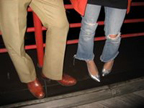
Inclusion & Exclusion
I'm back in Ottawa after a week in Banff with some really great people doing really great stuff, but before I switch my attention to fall teaching I'd like to think out loud about a few things that keep coming to mind.
It seems to me that our conversations on new media art ultimately revealed that it isn't the newness of media that's so interesting, but rather the artness of it. (Yes, I know that's not a word, but bear with me.) While "user-generated content" - or, as I prefer, public authoring and participatory media - repeatedly came up in conversation, it was quickly distinguished from artistic practice. While no one seemed willing to come right out and say it, I think the implied distinction was primarily quality-based, and both aesthetic and cultural quality are notoriously subjective.
My keynote address (which I'll post as soon as possible) chose to turn "screen" from noun to verb in an attempt to draw out the ways in which new media art and design practices involve acts of inclusion and exclusion. I tried to unpack a few of the primary metaphors that feed our notions of mobility, and I invited people to reimagine their senses of community and citizenship based on what it means to be in or out. The point of all this, of course, is to get producers of all sorts to acknowledge their own screening processes. In my mind, the most pressing political and ethical challenge facing us today is how we account for, and become accountable to, differences in perspective and practice. In other words, who gets to decide what constitutes quality content? The government? The broadcaster? The company? The artist? The designer? The academic? The public? And which public is that exactly? When it comes to collaboration, whose interests take precedence in which contexts? (As one artist said to me after my presentation, "I've realised I value art more than people.")
In my panel presentation (which I'll also post shortly) I discussed what I consider to be Proboscis' exemplary collaborative work, and how it was this sense of collaboration that helped shift a broadly technology-focussed project to a culturally-focussed one, or more specifically, how the two became entirely inseparable. Fiddian Warman also showed us a couple of Soda Creative's projects that specifically engage some of these questions, albeit in indirect ways. Both Nahnou-Together and b.tween2cultures explore what it might mean to create distinct cultural identities - together. Or how about this? The Residents and MOMA's new River of Crime Community Art Project seeks out a space for professionals and amateurs to work together. As "an exploration of the rise in popularity of instant-video-creation due to the proliferation of inexpensive video cameras, as well as both still cameras and phones that shoot video," ROCVID invites anyone and everyone to make a video - any way they like - to go with an audio clip provided by the legendary music group. Mass art and art for the masses indeed.
I'm sure I'll continue to think about these things as I prepare for my lecture on mongrel practices of art, design and anthropology at UIUC art + design next month, and as always, comments are welcome.
And for anyone interested, here are all my Interactive Screen 0.6 posts:
IA Screen : Introducing the Canadian new media context
The Convergence Conundrum: A Cross- Canadian Perspective on the Business of Content
Technology, Privilege and Innovation: The Legal Perspective
Creative Commons: Art, Activism and the Database
The View from Outside In: Margins of Art and Activism
The View from Inside Out: Margins of Technology and Business
Playing the Interface
Serious Games: Understanding the grey area between learning and playing
Filming Outside the Cinema
Blast Theory - Day of the Figurines workshop
The Impossibility Box: An Emotional Computation
(photo: Peter Horvath) [blogged by Anne Galloway on Purse Lips Square Jaw]
Posted by jo at 11:31 AM | Comments (0)
August 18, 2006
Darfur campaign in Second Life
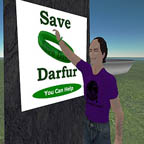
Embedded Social Messages
Darfur_Campaign [originally uploaded by eliane_alhadeff] (Rubber bracelets have made it into virtual life, as have hairy arms. Amazingly weird.) I found this on Flickr, and I'm rummaging around to find out what was going on - there was an interesting, Star-Wars style committee meeting for this online kidscamp project - maybe? - and a game has been produced, one of many to be produced by teens, each with a message:
Playing 4 Keeps is an innovative youth media project, in which a team of Global Kids Leaders at South Shore High School are gaining leadership and game design skills that they will use to develop and produce a socially conscious online game each year.
This is seriously impressive stuff.
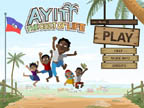
High quality, solid message:
Ayiti: The Cost of Life is a role-playing video game in which the player assumes the roles of family members living in rural Haiti. Over the course of the game, the player must choose among and balance various goals, such as achieving education, making money, staying healthy, and maintaining happiness while encountering unexpected events. The player must make many decisions that contribute to or detract from achieving his or her chosen goals.
Global Kids Digital Media Initiative - lots of interesting, game-based political and cultural activities, produced by and for teens,
SaveDarfur.org - the campaign [blogged by Alice in Wonderland]
Posted by jo at 03:34 PM | Comments (0)
The Prison of Embodiment
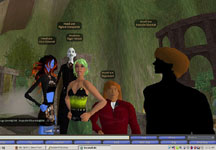
Eye Gaze and Intimacy
[screenshot by ceteri] As strange as it might seem, VR technology was a natural offshoot of the counterculture - a reliance on small-scale technologies to create a disembodied, connected global consciousness (think LSD, funky musical instruments, Whole Earth catalog of gadgets, and personal computers). As an aside, Fred Turner has a wonderful book coming out on the intersection of the counterculture and personal computing.
Of course, contemporary virtual worlds reveal an insistence on embodiment. Most virtual worlds are avatar-based. Where the counterculture was heading towards the liberation of disembodiment, the opposite has taken hold. In a recent study (PDF) at Stanford, we explored this tension between liberation and embodiment in virtual worlds.
There are many well-known patterns that goven how people interact in the physical world. For example, within a social distance of about 12 feet, the closer two people are, the less likely they will maintain eye contact. This is the elevator effect. Proximity and eye gaze are both signs of intimacy. To keep things in equlibrium, eye gaze compensates for distance when we stand too close to another person. Another well-observed pattern is that men maintain less eye contact with other men than women do with each other.
The question we looked into was: Do these patterns carry over into virtual worlds where people move with mice and keyboard instead of arms and legs, and where virtual gender need not match the real gender of a user? We used a script to collect positional and orientation data on social groups in Second Life over a period of about 2 months.
Our data showed that many patterns of physical interaction in the real world carry over into the virtual world. In other words, our insistence on embodiment in virtual environments structures social interactions in these worlds in ways that we may not consciously be aware of. On the other hand, this implies that virtual worlds may be useful platforms for studying things even as visceral as the rules of physical interaction.
Yee, N., Bailenson, J.N., Urbanek, M., Chang, F., Merget, D. (in press). The Unbearable Likeness of Being Digital: The Persistence of Nonverbal Social Norms in Online Virtual Environments. The Journal of CyberPsychology and Behavior. PDF [blogged by Nick Yee on Terranova]
Posted by jo at 12:26 PM | Comments (0)
MPG: Mobile Performance Group
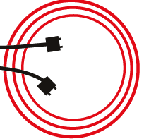
Art to Go
Founded by Matt Roberts, the MPG: Mobile Performance Group is a collective of new media artists interested in finding new ways to present art outside of traditional venues. MPG disseminates their work by using automobiles, video projection, cell phones, FM transmission, wireless hotspots, and any other technologies that allow artist to engage the public.
Parking Spaces investigates one of the most ubiquitous spaces in the United States, the parking lot. MPG moves through the city looking for empty parking lots to collect sounds and images. Using the collected material MPG creates an improvised performance in the space. Images from ZeroOne ISEA2006. Multi media feature from Mercury News. Flickr.
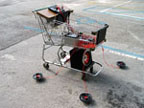
Shopping Carts: Using recycled cardboard, solar power, batteries and multimedia equipment, MPG converts shopping carts into modular performance units. During the day the carts are used to collect energy, sounds and images. Each cart is equipped with solar panels and batteries for energy collection. They are also equipped with audio/video recording equipment for sound and image collection. During the night carts carry panels, made of recycled cardboard, that allow several carts to connect and provide table space for the performers. The three basic carts are audio, video, and power. The audio module carries speakers, amps and mixing board. The video module carries video projectors, cameras, and lcd screens. The power module carries batteries, inverters and power strips to provide power for the performers.

Inflatables: A series of inflatables that can be used as performance space and projection screens. MPG is working with designer Gerry Christensen and a group of his students to create a series of apparatus for mobile performance. These apparatus include a bike trailer with a hybrid power source and wearables for performance space. The bicycle trailer is equipped with solar panels for energy collection and storage, and has the ability to tap into public power outlets. The trailers can cary multimedia equipment, local wireless network, and provide portable power. The wearable are portable devices that performers can wear to carry equipment and also convert into seating/table space for performance.
More information here. [thanks Craig]
Posted by jo at 10:29 AM | Comments (0)
Loca - Location Oriented Critical Arts
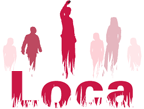
Grass-roots, Pervasive Surveillance
Loca is an artist-led interdisciplinary project on mobile media and surveillance. It forms part of an AHRB funded research programme exploring the shifting boundaries between art practice, the event and data systems. Loca is grass-roots, pervasive surveillance. A person walking through the city centre hears a beep on their phone and glances at the screen. Instead of an SMS alert they see a message reading: We are currently experiencing difficulties monitoring your position: please wave you network device in the air.
Loca is an exercise in everyday surveillance, tracking digital objects in physical space. What happens when it is easy for everyone to track everyone, when surveillance can be affected by consumer level technology within peer-to-peer networks without being routed through a central point?
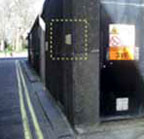
The project foregrounds secondary characteristics of mobile communications, such as the ability to locate consumer mobile devices in real-time and near-real-time, and the kinds of peer-to-peer pervasive surveillance that is possible as a result. Loca explores the shifting nature of surveillance as it ceases to be the preserve of governmental or commercial bureaucracies.
Pervasive surveillance has the potential to be both sinister and positive, at the same time. The intent of Loca is to equip people to deal with the ambiguity and to make informed decisions about the networks that they populate.
FOR IMMEDIATE RELEASE
SAN JOSE POLICE DEPARTMENT CONFISCATE EQUIPMENT USED IN SURVEILLANCE ART PROJECT DURING ZEROONE FESTIVAL.
On Sunday 13th August the newspapers were full of a story of 3 Palestinian-Americans facing terrorist charges for being caught in possession of 1000 cellphones, which the authorities suspected were to be used for surveillance or as bomb detonators. The following day San Jose Police Department seize and impound a cellphone wired up to a battery and hidden in a San Jose hotel lobby. Little did they know, but they had stumbled across a genuine case of DIY surveillance. This cellphone was running custom-made software by art group 'Loca' as a part of the ZeroOne festival and was a part of a surveillance network covering the downtown area.
A PLAYFUL ART PROJECT ON SURVEILLANCE THAT RAISES SERIOUS QUESTIONS
In 'Loca: Set To Discoverable' at the ZeroOne festival the Loca art group were able to track and communicate with the residents of San Jose via their cellphone without their permission or knowledge, so long as they have a Bluetooth device set to discoverable. Over 7 days more than two thousand people had been detected more than half a million (500,000) times, enabling the team to build up a detailed picture of their movements. People were sent messages from a stranger called Sly with intimate knowledge of their movements, written in such a way as to leave them unsure if they had not unwittingly joined a social network called Loca. The messages drew inferences based on the 'urban semantics' of the places they had been: “You were in a flower shop and spent 30 minutes in the park; are you in love?” Over the course of the week the messages became gradually more sinister, the would-be friend mutating into stalker, 'coffee later?' changing to 'r u ignoring me?'. The aim of Loca: Set To Discoverable was to enable people to question the networks they populate, and to consider how the trail of digital identities people leave behind them can be used for good or ill.
DEPLOYING 'NODES' IN PUBLIC SPACE
Each Loca 'node' consisted of a cellphone running custom made software, plus an additional battery so that the nodes could run independently for up to 5 days. Some were installed in concrete casings on lampposts, street signs and walls. Others were put in black plastic boxes in hotels, cafes, venues, cinemas and restaurants. They were hidden in flower pots, underneath a chaise longue, in the foot of the podium used by the cinema ticket collector, buried in the earth by a popular bar terrace. The project aims to raise ethical questions, not to be an irritant or prank, and permissions were obtained where appropriate.
SJPD: 'BOOKED IN EVIDENCE'
One node had been placed behind some plants in the lobby of the Sainte Claire hotel in downtown San Jose. Permission had been obtained from the hotel management to place it there, but it was found on the last day of the project by staff who had not been informed. The police were called, and on arrival found a plain black box containing a cellphone, positioned in a way inconsistent with someone leaving their personal cellphone to charge. The device was taken away as a suspicious object and 'booked in evidence'.
When the artists arrived at the hotel to collect the device later that day, Monday 14th August, the hotel duty manager informed them of what had happened. They were given the Crime Reference number and directions to the police station, and headed out to talk to San Jose Police Department. The duty sargeant told them that items booked in evidence are returned after a case has gone to court and that they would have to wait until they had been proven guilty or innocent to retrieve it.
[...]'As far we we were concerned, the police confiscating one of the nodes was as much a part of the project as us climbing ladders strapping nodes to street lights, or people engaging with the messages or receiving a print out of their movements at the exhibition stand. We set out to be fully transparent with the police, to see what their response to the project would be, and to document this at every stage.' - Loca
The only thing the artists forgot to mention was that the cellphone was continuing to scan while it was being held at the police station, providing Loca with surveillance data on people's movements at the station, whether they be officers, criminals or the innocent.
NOTES TO EDITORS
Loca is a group project by John Evans (UK/Finland), Drew Hemment (UK), Theo Humphries (UK), Mike Raento (Finland).
http://loca-lab.org
Posted by jo at 10:19 AM | Comments (0)
THE WONDERFUL WORLD OF IRATIONAL.ORG

Tools, Techniques and Events 1996-2006
THE WONDERFUL WORLD OF IRATIONAL.ORG: Tools, Techniques and Events 1996-2006 :: Daniel G. Andujar (Valencia/E), Rachel Baker (London/GB), Kayle Brandon (Bristol/GB), Heath Bunting (Bristol/GB), Minerva Cuevas (Mexico City/MEX), Marcus Valentine (Bristol/GB) ::
Have you ever taken part in International Tree Climbing Day? Did you know that there is a genetically modified "superweed" resistant to current herbicides such as Roundup? How would you react to the statement "Remember, language is not free?" Have you ever heard of "Public Sculpture Climbing" or the "Tour de Fence"? All of these are projects that have taken form around the server irational.org in recent years.
On August 27, 2006, the Hartware MedienKunstVerein in the PHOENIX Halle Dortmund is opening a unique exhibition project called "The Wonderful World of irational.org. Techniques, Tools, and Events 1996 - 2006". The show will run from August 30 to October 29, 2006.
Irational is a loose grouping of six international net and media artists who came together around the server irational.org, founded by the British net artist Heath Bunting in 1996, going on to make decisive contribution to early net art from the mid-1990s onward. With dry humor and minimal aesthetics, irational commented the Internet hype of the mid-to-late 1990s, competing with the commercialization-euphoria of the new market by developing its own pseudo-ventures. Net art was immediate during this period, neither needing nor enjoying the safety of a mediating space or instance. This is why irational often hit upon humorless trademark attorneys, who wanted to keep irational from using brand names such as 7-11, American Express, Sainsbury's and Tesco. These encounters, which the exhibition documents extensively, were little more than a prelude to more recent developments in the field of copyright, intellectual property, and brand protection. Heath Bunting was the first net artist to retire in 1997, putting an end to his exclusive work on the net and turning back to more intensive work in public space, which the Internet has become such an important part of today. If the activities of irational during its "net phase" were dedicated to calling virtual boundaries into question, its members now experiment with interrogating and overcoming economic, political, and social boundaries in real space, producing a great deal of comic relief, among other things.
Never before have so many complex and relevant artworks from around irational.org been shown in such a comprehensive exhibition. The goal of the exhibition is to use the media of a large-scale showing, workshops, and a comprehensive documentation to make these artistic-activist pieces more accessible to a general public.
The Hartware MedienKunstVerein, which - like irational - is celebrating its tenth anniversary this year, has received significant funding through the Federal Cultural Foundation of Germany (Kulturstiftung des Bundes).
Inke Arns, Jacob Lillemose
A comprehensive accompanying program can be found at www.hmkv.de
Exhibition curated by Inke Arns, Jacob Lillemose
irational Action Weekend curated by Francis Hunger
Managing director: Susanne Ackers
Exhibition architecture and technical director: Uwe Gorski
Organisation, coordination: Francis Hunger, Darija Simunovic
PR: Roland Kentrup, Dortmund
A catalogue will be published at the end of October 2006: Susanne Ackers / Inke Arns / Francis Hunger / Jacob Lillemose (eds.) The Hartware Guide to irational.org Revolver - Archiv fuer aktuelle Kunst, Frankfurt
am Main 2006, ISBN 3-86588-299-4
Funded by:
Kulturstiftung des Bundes
Der Ministerpraesident des Landes NRW
Kulturbuero Stadt Dortmund
dortmund-project
PHOENIX
LEG
Media partner: Heinz
Venue: Hartware MedienKunstVerein (HMKV) at PHOENIX Halle Dortmund Hochofenstrasse / corner Rombergstrasse Dortmund-Hörde (no postal address!)
Opening hours PHOENIX Halle
During the exhibitions of HMKV:
Wed 11:00 - 17:00, Thu until Sun 11:00 - 20:00
Tuesday, October 3, 2006, open 11:00 - 20:00
Admission: 4 Euro / reduced 2 Euro
Guided tours: Each Sunday at 16:00 ::Individual tours on request (Tel ++49 - 231 - 823 106)
How to get there by car: B 54 exit Rombergpark, Nortkirchenstraße
direction of Hörde, left into Entenpoth (speed 30 zone), then left into Hochofenstrasse
How to get there by subway: U41 direction Hörde until Dortmund-Hörde Bahnhof, 10 min. ride from Dortmund main railway station, then a 10 min. walk
Map: http://www.hmkv.de/dyn/e_contact_roaddescription/
HMKV Team: Dr. Inke Arns (Artistic director Hartware MedienKunstVerein) Susanne Ackers (Managing director Hartware MedienKunstVerein) Uwe Gorski (Technical director) Francis Hunger (Junior Curator) Darija Simunovic (Project coordinator and management)
Posted by jo at 09:47 AM | Comments (0)
p-tex performs GYOML
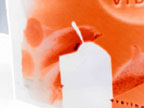
DiY in a Field
p-tex will perform GYOML in a field on Heysham Barrows near St. Peters Church on Saturday August 19, 2006 at 7.30 p.m. For live streaming copy and paste this URL into your media player's url window.
p-tex will be exploring how computer musicians can perform and create music without the need for mains electric, and using low budget or recycled / salvaged equipment and free open source software. He will also be using various sensors that will be manipulated and triggered by the surrounding environment, as well as by visitors to the site. p-tex has created software patches specifically for the piece which enable the sensors to communicate with the computer equipment. To achieve this he has used free software puredata and processing. For directions to Heysham Barrows, go here.
Posted by jo at 09:18 AM | Comments (0)
Upgrade! New York: We Passion Power and Control
![]()
The Dark Desires of Art Under Surveillance
Upgrade! New York presents We Passion Power and Control : The Dark Desires of Art Under Surveillance :: Thursday, August 24th, 7:30pm :: Eyebeam, 540 W. 21st Street, New York City :: This time we'll attempt to take on the dark desires beyond the basic art / privacy / surveillance discourse. Through three projects exercising different modes of surveillance we will discuss artists jealousy of authoritative powers and the desire to posses these powers themselves.
in(security) - 31Down's Online Surveillance Drama This is a live online theater piece that uses surveillance cameras as a playing space for actors and audience members as you become part of a security team policing the streets of New York. devised and developed by: Ryan Holsopple and Mirit Tal.
Little Feet - Little Feet Bureau International brings privatization to government surveillance. Four dot-matrix printers comb internet traffic. Upon finding words that threatens a client nation, the machines use the intercepted "evidence" to draft letters accusing and questioning the offenders. Obsessed with uncovering secrets, the final product of the system is a culture of paranoia. As such, the installation stands with one little foot planted in hysterical paranoia and conspiracy theory and the other in denial and the claim "it can't happen to me". Developed by: David Nolen, Toshiaki Ozawa and Mushon Zer-Aviv.
Generative Social Networking® - Taking advantage of Bluetooth security flaws in cellphones, Generative Social Networking® unlocks the hidden potential of mobile contact lists to automatically connect people. GSN® is an artistic experiment in urban hacking instigated by Christian Croft and Andrew Schneider, a critical media partnership currently researching at the Interactive Telecommunications Program at NYU.
Biographies
Ryan Holsopple, founder and director of 31 Down radio theater, has worked as an actor with directors: Richard Foreman, Pavol Liska, Tea Agalic and DJ Mendel, among others. He co-created the website Buskerdu.com with John Schimmel, a website that allows you to record and post your favorite subway buskers to the Web. Ryan is a graduate of the Interactive Telecommunications Program.
Mirit Tal is an Israeli media artist and a software engineer. Intrigued by the powers of technology on our life, her work deals with issues such as surveillance, paranoia, unconscious interaction and mind control. Soon after arriving to New York in 2004 she joined 31 Down and have since presented in venues such as the New Museum of Contemporary Art, Rhizome, Spark Festival 2006 and White Box/Performa 05.
David Nolen is an artist whose work incorporates both analog and digital processes and he enjoys playing at the blurry boundary between the intellectual rigor of code and the intuitive free play of the pencil. He now knows far too many programming languages for his own good though in a past life he studied film and curated an avant-garde music festival in Austin, Texas. Currently he’s writing his own software to analyze and animate his drawings. This project arose from his thesis work at NYU’s Interactive Telecommunication Program where he just received his masters.
Toshiaki Ozawa was born in Tokyo and has spent a great majority of his time ever since playing with light, shadow, emulsion and liquid-solutions. His work, screen based and otherwise, reflects this compulsively tactile approach to subject matter. He has collaborated on the work of many artists including Isaac Julien, Laurie Anderson, Leandro Katz, and Matthew Barney. As a cinematographer, he has photographed many films. One of them won the cinematography and best film awards at Sundance 2002. Another was reviewed by Roger Ebert in 2004 as "the worst film in the history of the [Cannes Film] festival. "Current projects include, 'Quixotic Unmeanings,' a robotic wire sculpture broadcasting Cervantes in semaphores, 'Pikadon Seoul,' a multimedia performance opposing the worldwide atomic arsenal, and 'Scar,' a slasher horror movie filmed in 3D.
Mushon Zer Aviv is an Israeli designer, a media-activist and a net artist. He is the co-founder of ShiftSpace (.org) – a new Open Source platform seeking to extend the current borders of the web and to allow the creation of public spaces within it. For that Mushon has recently won the Swiss Projekt Sitemapping new-media grant. Mushon is a new-media lecturer in the Shenkar college in Tel-Aviv and is the co-founder of Shual (.com) design studio. He has curated the BD4D Tel-Aviv and the Upgrade! Tel-Aviv New-Media events series. Mushon currently lives with his wife and cat in New York, studying for his masters degree in ITP, NYU's new-media program.
Christian Croft is a new media artist and interactive designer from Athens, GA currently doing research at NYU's Interactive Telecommunications Program. He works both collaboratively and individually on projects that revolve around such themes as info glut, technological ritual, and recombinatory language. He has received grant funding from Ideas for Creative Exploration (ICE) at the Univ. of Georgia and was chosen to participate in The Kitchen 2003 Summer Institute. He has shown work at the Georgia Museum of Art, ICE, Athens Institute of Contemporary Art (ATHICA), Rhizome Artbase, AskTheRobot Festival, Sony Wonder Technology Lab, and the Bushwick Arts Project Festival. More of his work can be explored online at xncroft.com.
Andrew Schneider is a performer and video artist. As a founding member of the Chicago-based multimedia performance ensemble bigpicturegroup, he has just recently completed an artist-in-residence program at the University of Chicago where the group has been developing their latest work TRUE+FALSE. His work has also been seen at P.S.122 as well as part of the New York International Fringe festival.
All three projects have been developed at the Interactive Telecommunications Program at NYU.
Upgrade! is an international network of gatherings concerning art + tech + community.
About our partner: Eyebeam supports the creation, presentation and analysis of new forms of innovative cultural production. Founded in 1997, Eyebeam is dedicated to exposing broad and diverse audiences to new technologies and media arts, while simultaneously establishing and demonstrating new media as a significant genre.
Posted by jo at 09:00 AM | Comments (0)
SEQUENCES

Real Time Festival
SEQUENCES: Real Time Festival :: reykjavik 2006 :: October 13 - 28, 2006 :: SEQUENCES is an international cross-media festival in Reykjavik with a focus on time-based art phenomena. The festival links contemporary visual art with other media, especially sound and performative art. It will take place in different locations in the city center of Reykjav’k, accompanied by exhibitions and video / shortfilm nights. SEQUENCES will invade established spaces (museums and galleries) as well as public spaces in the city center of Iceland's capital. A fine selection of international and local artists will participate in this unique event.
The strong interrelation between visual arts, sound and performance arts is significant for Iceland's vibrant art scene. These nexuses account for specific dynamic creative processes which develop especially in time-based art projects.
Programmatic frame: //vp-nites :: A row of video- and performance nights with a rich program of international and local artists build the attractive frame of the festival, in cooperation with other institutions and festivals. The venue is an old theater by the city pond :: //shows :: Several museums, galleries and project spaces will host exhibitions that focus on time-based art phenomena.
To name a few: The National Gallery will focus on the first generation influenced by pop and punk - a show of Icelandic painting in the 1980s. The Reykjav’k Art Museum will host a group show with young Icelandic artists and the Living Art Museum will show a retrospective of Carolee Schneeman. Galleries like i8, Kling & Bang or Boreas will present single artist's statements. Off-spaces like banananas or the dwarf gallery will host installations or performances :: //public spaces :: A lot of the projects in the festival seek to invade public spaces. Not only public venues and buildings but also shops, bars and concert halls will host visual, sound or performance projects.
The detailed program will be released in middle September.
SEQUENCES
c/o CIA.IS - Center for Icelandic Art
Hafnarstr¾ti 16 * IS-101 Reykav’k
T:++354-562 72 62 * F:++354-562 66 56
www.sequences.is * info[at]sequences.is
Sponsored by: Baugur Group In cooperation with: CIA.IS - Center for Icelandic Art | Ministry of Education and Culture | The City of Reykjav’k | SêM | Goethe-Institut | Artcircolo Kunstprojekt GmbH | The Icelandic Embassy in Berlin |
Hotel Nordica
Posted by jo at 08:55 AM | Comments (0)
CopyCamp

An Unconference about the Challenge to Copyright
CopyCamp: An unconference for artists about the Internet and the challenge to copyright :: CopyCamp is a place to meet people making art and making waves, an opportunity to discover how the Internet can work for artists and fans, and a chance to debate the value(s) of copyright with some of the key players. It is an event in which participants drive the programming, and debates are genuine round-tables. There are no observers: everyone has something to offer and is expected to contribute.
There will be an electronic salon showcasing successful projects. There will be internationally-acclaimed experts. There will be a carefully selected mix of artists, geeks, and bureaucrats, with conversation always focused squarely on the arts, and the interests of creators. The CopyCamp organizing team is passionate about convening an event like no other you have ever attended. Space at the event is limited. There will be a number of subsidized spots for artists.
Posted by jo at 08:34 AM | Comments (0)
Nettime

Net Art 2.0
"The world runs on Internet time." - Andy Grove, former CEO of Intel.
The early net artists were, in many ways, ahead of their time (or as Cocteau might have said, "would appear to be ahead of their time, for it is really the time that is behind the work."). But now that has all changed. Net Art 2.0 like Web 2.0 is embedded in the practices and rituals of everyday life. You can't be a net artist today without taking into account where the impetus for turning the net into an artistic instrument came from. That means that early net art history anticipated the socially interconnected "second lives" of the new generation of net artists for whom the digital is but an extension of their body's functionality as it navigates the network culture. I discuss this more thoroughly in the "Spontaneous Theories" section of META/DATA.
As Baudrillard reminds us, "[t]he image no longer even has time to become an image."
Perhaps we could say net art never had enough time to become net art but that Net Art 2.0 is more in sync with its time. This may be the reason why so much of the art work being created by next generation net artists is less avant (ahead of its time) and more pop (in its time). [posted by Prof VJ on Pofessor VJ]
Posted by jo at 08:00 AM | Comments (0)
August 17, 2006
"Echo" at the Tate Modern
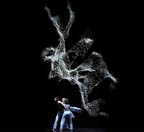
3D Point-Clouds in Real Time
UnitedVisualArtists have just uploaded on their website a video of their latest project, Echo. The 8-minute live performance piece was commissioned by Vamp and produced in collaboration with Mimbre for a launch in the Turbine Hall, Tate Modern in London. I found the video so beautiful that I pestered UVA with questions. Ash Nehru kindly answered me.
What's the technology behind Echo?
The LED screen we used was a Lighthouse R10 LED screen, 8m wide by 11m high. We used the Point Grey Labs' Bumblebee2 stereo camera system, mounted at the foot of the stage, and used our own proprietary software (dragonfly3) to render the resulting 3D point-cloud in real time. The motion of the 'virtual camera' was scripted within D3.
How about the collaboration with the dancers, Mimbre and choreographer Flick Ferdinando? How did it go?
Because we had very little rehearsal time (5 days), the dancers assembled the performance from sequences taken from their existing show, but simplified and slowed down to create a dreamlike, 'sculptural' effect. We set up the bumblebee system so that the choreographer could select moves that worked best for the camera.
Aside from offering our opinions as to which music worked best with which moves, we exercised as little control over the choreography as possible.
Once the choreography was fixed, we recorded the performance to create a 3D video file, which was then used to sequence the camera moves.
The idea for the performance came from our original work with the bumblebee system, an interactive installation called Mirror that we presented in the Kemistry gallery in horeditch, London. The particular rendering style we used for that project was developed slightly to work better with the LED screen.
Thanks Ash!
If you're in Northern Europe, Austin or Los Angeles, chances are that you can catch up with the work of UnitedVisualArtists, they are currently touring with Massive Attack.
More Interview of UnitedVisualArtists; their video for Colder. [blogged by Régine on we-make-money-not-art]
Posted by jo at 07:58 PM | Comments (0)
Full Contact Concert

Let's Get Physical
Vollkontaktkonzert - Full Contact Concert, by Stefan Brunner and Michael Wilhelm, arranges a musical composition out of a boxing match. Two performers are equipped with microphones. One microphone, connected to a stethoscope underneath the scapula of the performer’s back, records the repercussion of the beats hitting his chest. The other microphone, glued to the performer’s chin, records his breath.
The sounds are post-processed on the laptop controlled by a third person. The whole piece of music unfolds: the introduction is the warm up. Then the performers put on the boxing gloves and a beat-part begins: performers start beating each other in turns. Two punches to the stomach then one to the chest, two to the stomach, one to the chest, etc. It goes faster and faster until the break, all you can hear is the performers' breath and sounds from the laptop. After they have recoverd from the exhaustion, the boxers start to treat each other with more punches to their chests and stomachs.
The video isn't particularly spectacular but i still like the concept. More images. Via Vvork.

There's a few boxing performances and installations around: Videoboxing, a video performance in which Thomas Heijmans and Eliane Roest merge video, new media, music, fashion, choreography and physical violence on stage; Telephoneboxing (left), by Allard Roeterink, turns the phone call into a hard-work physical process; Soundslam, a highly sensitive punching bag with built-in trainer; Cyclone Uppercut, a boxing game that runs in Virtual Reality Simulators. [blogged by Régine on we-make-money-not-art]
Posted by jo at 07:28 PM | Comments (0)
not a time machine:
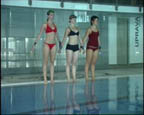
[: visible > audible > sensible :]
not a time machine: a composition for dancers, swimming-pool, camera, monitor and mixing board by Miha Ciglar, Mojca Kasjak, son:DA :; video file - 25 MB (divx codec) - rightclick + save target as) :: not a time machine is an interdisciplinary art project that uses dance, music and video as forms of expression. The two central elements (water and electricity) constitute the fundaments of a gestural interface. The main idea was to expose the intrinsic aesthetics of conventional electronic devices through a particular electronic connection of swimming-pool, camera, monitor and audio mixing board.
Since the dancers are electrically connected to this constellation of misused technology, they become a crucial part of the instrument and consequentially get misused as well. All of their actions (gestures) reflect themselves in unique sound events, limiting - but at the same time focusing - their standard expression spectra to the expressive potential and boundaries of the instrument. The induced sound respectively its electronic abstraction is in direct contact with the performers body and is providing a tangible feedback. This enables a different corporal perception and interpretation of the caused sound, since now the performers do not only have the audible but also a haptic reference - i.e. pain, caused by the electric current - for the choice of their following actions. In this way, a circle – based upon the principle of cause and effect – gets completed, which triggers a continuous oscillation of the three basic impressions: [: visible > audible > sensible :]. [PDF] [via VVORK]
Posted by jo at 12:27 PM | Comments (0)
LOCUS SONUS
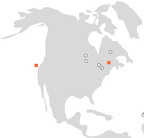
DUPLEX PERFORMANCE
THE THING invites your face and body and voice to 11 Harrison Street, ground floor storefront gallery, RIVERFAWN, for the Manhattan interface of THE THING.residency: LOCUS SONUS DUPLEX PERFORMANCE. This is a special performance that will be live from the Roebling Bridge on the Delaware River and from the RIVERFAWN Gallery in New York City. You will be part of the performance! :: 6pm –10pm Thursday August 24th :: 11 Harrison Street, ground floor* :: New York City.
Locus Sonus has constructed for this performance 2 IP webcams/parabolic microphones with which they can hunt for sounds in and around the venue streaming them simultaneously to the remote location. In each location laptop performers capture and remix the audio from the mic and video projectors show what the mobile microphones are capturing. Both mixes are played in both locations, the musicians responding to their remote counterparts. The Roebling Bridge will be set up on both sides of the river (the audience will be on the bridge). The idea being that we can use the local distance to reflect the remote distance. On the Manhattan side, the performance will take place in the RIVERFAWN Gallery where they will also use the wire/stream interface as an instrument to mix and control during the presentation. Live sounds from around the world (from the locusonus open web mics project) will also be used as raw material for the concerts.
Locus Sonus will be in residence between the 15th and the 29th of August in the USA with two installations and a duplex performance between them. The two locations will be at the DIGIT Festival, Delaware Valley Arts Alliance & Roebling Bridge Environmental Arts and at the RIVERFAWN Gallery in New York City.
DATES: The Installation at the Delaware Valley Arts Alliance opens on Saturday, August 19th and runs until August 25th. The performance Duplex Roebling Bridge/Manhattan will take place Thursday, August 24th at RIVERFAWN Gallery, 11 Harrison Street in New York City. There will also be a physical installation/interface on view from August 22nd to the 27th, 12-6pm at RIVERFAWN Gallery.
For more information: http://nujus.net/~locusonus/site/index_e.html
Audio streams: http://nujus.net/~locusonus/site/documentation/allstreams/index_e.html
ABOUT LOCUS SONUS
Locus Sonus is a research group specialized in audio art (École Supérieure d'Art d'Aix-en-Provence, École Nationale Supérieure d'Art de Nice Villa Arson). Our objective is to experiment and evaluate the innovative and transdisciplinary nature of audio art forms in a lab-type context. We are are also concerned with the communal, collective or multi-user aspects inherent to many emerging audio practices and which necessitate working as a group. Two main thematics define this research - audio in it's relation to space and networked audio systems. The "Lab" proposes a process combining practical artistic experimentation and critical evaluation in a group context. The Locus Sonus Lab is currently focusing on a process which revolves around the use of multiple audio streams. The streams which are basically open-mic continually upload chosen soundscapes or sound environments, as playable material. The way in which we work with other people to set up and maintain the streams is part of the methodology, indeed the technology provides the basis to construct a human network.
*Directions: by subway take 1 train to Franklin Street. Walk one block west on Franklin to Hudson and cross the street. Walk 1 block south to Harrison and turn right. 11 Harrison street is in the middle of the block on the south side of the street, By car: From uptown Take West Street to Vestry. Make a left on Vestry. Go two blocks make a right on Greenwich Street. Go two traffic lights , make a left on Harrison street. From downtown take West Street to Harrison street. Make a right on Harrison and go 1 block.
Posted by jo at 09:25 AM | Comments (0)
August 16, 2006
Social Media and the Networked Public Sphere
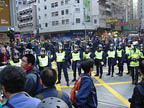
Improving Civic Participation
"Can social media increase and improve civic participation? If so, in what ways? There's a lot being said and written about the subject these days, but it is difficult to get a clear overview of the opinions. I attempt here to collect viewpoints both for and against the premise that social media is creating a better public sphere, and analyze them in the context of what constitutes a public and its antithesis, a mass. In presenting what are sometimes extreme positions within this debate (too idealistic v. too critical), my hope is to begin to understand the reality that lies in the middle, and come closer to understanding social media's potential (and limitations) as a tool to bring about social change.
At a general level, we could say that on one side of the debate are those who believe that social media can increase civic participation and shift the balance of power away from the institutions that currently stand in the way of change. On the other side are those who warn that social media can only offer a reduced form of participation, that it diminishes the value of individual contributions, and that it leaves social systems more prone to manipulation by lowering their intelligence to the minimum common denominator (i.e., stupidity or mediocrity).
Thus, the debate can be framed in terms of whether social media can engender democratic publics that embody an intelligence and capacity for action greater than the sum of its members, or whether it will merely continue to support the production of anti-democratic masses of disenfranchised and alienated consumers. Of course, social media is a big label encompassing many different technologies, and even the same technologies can be applied differently in various contexts. But while features and applications might differ, the people contributing to this debate are obviously focused on the aggregated impact that social media is having on our societies rather than on specific examples of applications." Continue reading Social Media and the Networked Public Sphere by Ulises Ali Mejias.
Posted by jo at 07:37 PM | Comments (0)
Data bodies

Re-Gaining a Sense of Privacy in Public Space
The Super Vision performance (via Grand Text Auto), by the Builders Association and dbox, was presented last week at ISEA and it looks taps right into my interests of the moment (which are roughly about artists/hackers' guerilla tactics to re-gain a sense of privacy in public space.)
Even before we are born, our personal electronic data begins to accumulate and to circulate. From our first sonogram, to birth certificates, academic records, dental records, credit card purchases, passports, and emails – as we grow, our “data body” grows with us, and becomes an integral part of our identity. In the age of information, we have come to accept, allow, and depend upon this new identity. How do we relate to the growing cloud of data that surrounds us and others?
Super Vision explores the changing nature of our relationship to living in a post-private society where personal electronic information is constantly collected and distributed. These bodies exist in a “data space” which remains mostly invisible. Super Vision makes that space visible.
SUPER VISION tells three stories:
1. As he crosses borders, a traveler gradually is forced to reveal all of his personal information, until his identity becomes transparent, with no part of his life left outside the bounds of dataveillance.
2. As a woman tries to digitally archive her Grandmother’s past, the grandmother slips into senility. The woman is left to discover what remains of her Grandmother’s life – and her own – outside the realm of data.
3. A father covertly exploits his young son’s personal data to meet the demands of the family’s lifestyle. This ploy escalates beyond control, until he is compelled to disappear. His wife and son are left with a starkly diminished data portrait, and his escape is shadowed by the long reach of the datasphere.
The artists will perform again on Thu–Sat, Aug 17–19 at the Yerba Buena, San Francisco.
Reading about this work made me think about a couple of projects that i'll introduce with a quote from Futurologist Ian Pearson: "[In the future] there will be chips all over the high street relaying information and you will be bombarded with digital information everywhere you go," said Pearson. "You will need a digital bubble force field — a shield that lets through what you want and blocks everything else." (via)

First project is the floatable jellyfish-like vessels, by Usman Haque. The vessels would drift around cities to create ephemeral zones of truly private space: an absence of phone calls, emails, access of GPS devices, TV broadcasts, wireless networks and other microwave emissions. They can also provide shielding from the gaze surveillance systems.

A second project is Freezone. British artist Stanza imagined that information free zones could become the holiday destination of the future. All mobile phones, passports, id cards or chips would be left outside the pod.
Katherine Moriwaki has also explored the data that follows us like a shadow with Recoil. Powerful magnets sewed into suits allow the wearer creates a data-free zone, by erasing the data contained in memory devices like credit cards.

These garments can also serve to heighten awareness in the wearer and others as to the high penetration of digital technologies into our everyday lives and reasserts awareness of bodily presence in the environment.
Last work that sprung to my mind was Chris Oakley's video The Catalogue which envisions humanity as a series of trackable units whose value is defined by their spending capacity and future needs. [blogged by Régine on we-make-money-not-art]
Posted by jo at 07:11 PM | Comments (0)
Copa Sonar

Recordings Available
Schlossplatz was once the home of the Berlin City Palace. In 1950 the palace, a symbol of Prussian pride and wealth was demolished by the GDR and erected in its place was the Palast der Republik. Due to the combination of the reunification of Berlin and the use of asbestos, the Palace of the Republic is being deconstructed and soon the old palace, Stadtschloss will be rebuilt.
Schlossplatz has historically been a highly contested site. On July 14th it became a site of public performance, sound broadcast and celebration.
Copa Sonar was organized by Marco Barotti, Emanuele Guidi and myself in collaboration with sonambiente, and tesla. Five experimental sound groups volunteered to overtake the desolate public plaza off of the touristic street Unter din Linden. Performances by ap/xxxxx, B Component, the rottt (the return of the thinking thing) and lekronk, OLYVETTY, saal-c were broadcast from the site via miniFM and visitors were offered free wine and beer. The audience was a diverse mix of sound art connoisseurs, curious tourists, and skaters.
The recordings from the event are now available as mp3s and high quality aifs to download - Copa Sonar. Enjoy the data tranformed into noise by ap/xxxxx; the relaxing sound of a Swiss precussion instrument electronically modulated by B Component; electronic and computer experimentation by the return of the thinking thing; Olyvetty's trans-like performance or the more melodic compositions of saal-c.
Also read an interview concerning the public intervention with Emanuele Guidi. [blogged by Ricardo on Structural Patterns]
Posted by jo at 06:39 PM | Comments (0)
mur.at NetWorkArt Contest „net_sight“ 2006
![]()
call for submissions
Idea: Since 1998 mur.at has been working on a virtual NetSculpture which is constantly growing and branching out. This widely ramified Net – the leased line net – offers a democratic and unbureaucratic access to new communication and information technologies to people engaged in the artistic and cultural sector in the area of Graz apart from e-business and e-commerce. The NetNodeSculpture includes an infrastructure which allows continuous work of art organisations and people engaged in the cultural sector.
In order to be able to experience the virtual space in real public space, mur.at initiates a contest for making this virtual sculpture - which is spread over Graz like a network - visible for all.
Target of the contest: For the promotion of NetArt and NetCulture mur.at offers the possibility to deal with the community in an artistic way and to implement the winning project. The virtual sculpture will be transferred to a tangible space in order to be visible also as real locality. Therewith the virtual sculpture becomes a sculpture that can be conceived with all senses in the public space of Graz. The sculpture shall be developed and implemented in various media.
Desired form of submitted projects: desired are...
..artistic projects, which refer and use the contents and infrastructure of mur.at, the nodes and/or the mur.at-community.
..artistic projects which excel at using unconventional ideas of „Visualization“.
..unrealised projects from the various areas of art; projects which deal with the subject of a NetSculpture. This can be projected in form of media- and space- installations, sound projects, memorial tablets, photo or video projects, as long as it appears meaningful with regard to the subject. The expression „Visualization“ shall be considered a metaphor and the type of realisation shall not be limited to a specific medium.
Prize money/Implementation
First prize: The project which is ranked first by the jury will be implemented from December 2006 to end of May 2007. The budget for the implementation (incl. remuneration) is € 10.000,-. The project will be showcased during a ceremony.
Appreciation prize: The most innovative, but not realizable project will be awarded with an appreciation prize amounting to € 300,-.
Exposition: During an exposition opening on December 1, 2006, the 10 best projects will be presented to the public. The budget for the presentation of the concepts is € 200,- each, whereas the form of presentation (choice of media, etc.) is up to the presenters.
There is no splitting of the prizes.
Jury: Members of the Jury:
1 representative of the mur.at team: Johannes Zmölnig: financial treasurer of the mur.at executive committee; artistic-scientific assistant at IEM (Institute for Electronic Music) (Graz, A).
1 representative of the nodes: Reni Hofmüller: media artist and artistic director of ESC im labor (Graz, A).
1 vote of the mur.at-community: every mur.at member has the right to vote. The resulting ranking counts as the community-vote.
Katharina Gsöllpointner: Culture- and mediatheorist (Vienna, A) (to be confirmed).
Inke Arns: Artistic director of hartware medien kunst verein Dortmund. Since 1993 free curator and author with focus on MediaArt, NetCultures, Eastern Europe (Dortmund, Ger) (to be confirmed).
The meeting of the jury is open to the public.
When: Friday, November 3, 2006 at 10:00 hrs
Where: mur.at, Leitnergasse 7, A-8010 Graz
Submission
The Call for submissions is open to the general public. The target group consists of people engaged in the artistic and cultural sector with the focus on the community of mur.at. There are no limits of age, education or nationality of the submitting persons.
Please note
Final date for submission is October 15, 2006. The submission may only be made online by filling out the submission form.
All informations for the submission at http://mur.at/verein/net_sight
In addition to the personal data (not visible for the jury), please upload (in pdf format) an abstract (max. 3000 characters) as well as a detailed project description incl. a rough estimate of cost and a time scedule (Attention: only one pdf-file can be uploaded). The submitted projects may not exceed a cost frame of € 10.000,-. Any maintenance activities of the projects must be included in the cost estimate.
Due to the fact that the submitted projects will be handled anonymously, please do not mention names nor logos in the project descriptions. We can only accept submissions which are complete and made anonymous.
We do not assume any liability for the submitted concepts. In case of a refusal of a project, its authors are not entitled to raise any claims upon mur.at or persons acting on behalf of mur.at. mur.at reserves the right to use the submitted material for the purpose of documentation.
Notification
The winners (first prize, appreciation prize, the 10 best projects) will be informed about the results by e-mail until November 10, 2006. In their own interest, the participants in the contest shall strive to be reachable at the e-mail address contained in the submission form during the whole period of notification.
Awards Ceremony/Presentation
When: December 1, 2006 at 19:00 hrs
Where: to be defined
The awards ceremony of the contest will be held on December 1, 2006 during the exposition of the 10 best project concepts. The artists are not obliged to present their concepts. The winners (first prize, appreciation prize) commit to personally receive the prizes and present their projects during the exposition. Groups and institutions are requested to nominate one or max. two representatives. Any travel expenses of the winners for the journey to the exposition / presentation will be compensated by mur.at (train: 2nd class; plane: economy class).
The implementation budget and the remuneration for the best project are dedicated to its implementation. mur.at assists in the whole period of implementation and reserves the right to ask for a proof of the adequate utilization of the prize money.
Documentation
It is the intention of mur.at to document the entire contest (incl. all submitted concepts and the finally implemented project) in an online archive.
Contact
For general questions please contact:
Andrea Schlemmer (Project Coordinator)
mur.at, Verein zur Förderung von Netzwerkkunst
Leitnergasse 7, A-8010 Graz
tel: ++43/316/82 14 51 ext. 26
cell: ++43/699/126 05 795
fax: ++43/316/82 14 51 ext. 26
e-mail: andrea_at_mur.at (Subject: „net_sight“)
For technical questions please contact the noc-team:
Monday to Friday from 10:00 to 16:00 hrs.
tel: ++43/316/82 14 51 ext. 55
e-mail: noc_at_mur.at (Subject: „net_sight“)
Posted by jo at 06:03 PM | Comments (0)
Cellphonia
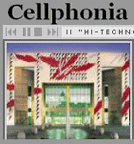
A Cellphone Opera
After the great success of this version of our "cellphone opera" at the ZeroOne festival we have decided to leave it going for now, so please join in. If you already have, you can do it again and again. Admission free (especially on nights and weekends). Call 408-228-5848.
"Some projects take audience participation one step further, allowing people to add voice, text or images to an artwork in progress. By dialing up another project, Cellphonia, ... a caller (presumably but not necessarily from the area) can join the chorus of a current-affairs opera. The libretto for that day, based on news feeds from The San Jose Mercury News, is voiced one line at a time; all the caller has to do is echo it back into the phone. The performance is recorded and automatically mixed with other voices. Later a caller can download an MP3 file of the song for playback on his own phone at http://cellphonia.org
“So often people with cellphones to their ears are in their own world, cut off from reality,” said Steve Bull, a New York artist-programmer who developed the opera with composers Scot Gresham-Lancaster and Tim Perkis. “This will pull people back into the community, as they sing the community story and hear their voice in the community chorus.” At ZeroOne, Paintings Are So Last Century, JORI FINKEL, SAN JOSE, CA, NY Times, August 6, 2006
We will be putting occasional mixes up at the "Cellphonia San Jose podcast" at:
http://cellphone.el.net/podcast. If you are interested in sponsoring your own variation on this concept of a cellphone opera don't hesitate to contact us. info[at]o-art.org
Posted by jo at 09:23 AM | Comments (0)
August 15, 2006
antiterror line
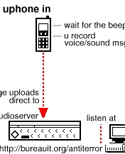
Uphone In
Bureau of Inverse Technology's antiterror line is a service that enables every phone [home/cell/booth] to act as a networked microphone. For collecting live audio data on civil liberty infringements and other anti-terror events.
You call in and leave a message. Message may be spoken report or in-progress recording of an anti-terror attack. UPHONE uplinks your audio recording direct to the BIT online terror database. An audio accumulation of micro- incidents which individually may be inactionable but en masse could provide evidence for a definitive response.
The bit UPHONE is a distributed, publicly readwriteable newsnetwork designed to withstand the militarisation of your government/the martial takeover of your regular broadcast networks. System facilitates information collection under conditions that cannot be accurately predicted / for which you may be unprepared, for example when an antiterror event occurs you may be away from your Desk. The resultant audio files are held in an open database and can be monitored, syndicated or remixed for your purposes. Bureau will provide a full report and system maintenance.
BIT advises members of the public to report individuals or activity that may be directly or indirectly associated with anti-terrorist or antiterroristic activity. Public telephone booths provide the most effective anonymizing device for those who would prefer to remain unidentified. Individuals uploading information will not be re-contacted but authorship can be credited.
Uphone audio collection is designed to provide higher standards for evidence than other forms of documenting the erosion of civil liberties, such as questionaires, opinion polls and other statistics. Voice and sound data will be uploaded through this system. Inarticulate and non-vocal artefacts such as live civ-lib infringement actuality, will be fully credited, however recordings will need to be 2 seconds or more in length to appear in the database. Unclear recordings should be annotated.
Posted by michelle at 07:57 PM | Comments (0)
Serious Games:
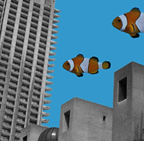
Understanding the Grey Area Between Learning and Playing
Michael Magee and Owen Brierley talked about how game playing is always already a learning experience - along the lines of Steven Johnson's Everything Bad is Good for You.
Serious Game Initiative "The Serious Games Initiative is focused on uses for games in exploring management and leadership challenges facing the public sector. Part of its overall charter is to help forge productive links between the electronic game industry and projects involving the use of games in education, training, health, and public policy."
Serious Games: Improving Public Policy through Game-Based Learning and Simulation
Serious Games Summit 2006
Serious Games Canada
Canadian Game Studies Association
Interesting stuff, but I would have loved to hear more critical discussion of military games and the civilianisation of technology. Someone brought up Pax Warrior - an interesting twist on the war game based on the absolutely tragic experiences of General Roméo Dallaire in Rwanda, where Canadian peace-keeping forces were abandoned by the UN and were not able to stop the genocide of hundreds of thousands. (If you haven't seen Shake Hands With The Devil, I highly recommend it.) My concern is not just with the skills that can be learned in serious games, but the values too. Mia asked about activist games or games for social change, but the panelists pointed out that their value depends on who is trying to do the indoctrinating or resocialising. [blogged by Anne Galloway on Purse Lips Square Jaw]
Posted by jo at 07:04 PM | Comments (0)
Writing About Virtual Words

Second Life Arts & Total Entertainment Magazine
I have to confess I’m moonlighting in another world. I’ve started working in the virtual world Second Life as an “embedded journalist”. SLATE Magazine (Second Life Arts & Total Entertainment Magazine) is a new Second Life magazine that covers the arts in SL. There are 14 authors in the collective so far and we’re a mixed bunch of artists, academics, writers, business people and designers. At present there isn’t much analysis of SL out there as most blogs provide essential but simple reportage on events with little reflection. We’re taking a different tack and hoping to provide not only interesting information about things to do for SL residents, but analysis on what we think is going on. And, in true SL style we have a virtual office building with desks (I don’t get that, but it is funny). [upper left] is a pic of our boardroom created by the talented Dell and Anya.
We are also paid in Linden dollars (the inworld currency), we’ll be having frequent events and there was a big launch. I unfortunately was unable to attend the launch because my interstate flight was delayed. But here is a pic taken by the wonderful editor of SLATE Anya Ixchel:

There are more details and pics at Anya’s page and at her flickr. Anya/Angela Thomas is a respected academic who has been looking at literacy in SL, even running postgraduate classes in it. The event had live streaming music and was attended by the 40 who could get in. Many couldn’t get in and this will be changed for future events when the SIM allowance will be tweaked accordingly.
The Magazine is now online at http://www.slatenight.com/. It will be available inworld and in pdf format very soon. Advertising space is available too. My first article is: A Commanding Conversation and is a continuation of the ideas discussed here previously in this post on the poetics of keywords. In future articles I will be looking at how the gallery space and curatorial dynamics change in a virtual world and the writing and games specific to inside virtual spaces.
And IM me if you’re ever in SL, especially if you have some artwork, performance, book or game in SL. My SL name is Lythe Witte.
Reblogged at CME [blogged by Christy Dena on WRT]
Posted by jo at 06:48 PM | Comments (0)
TROYANO

Up Dating, Art and Technology
TROYANO: Up Dating, Art and Technology :: A series of conferences that will aboard the limits between art and technology from the last experiences made by artists. The event is divided in two phases ::
<---////////////// From 6 pm in the Centre Cultural of Spain of Santiago, Chile, during the days 17, 18 and 19 of August, will be broadcasted online to Espacio H located in the city of Cordoba, Argentine. These activities will be part of the 8th Digital Days Works from Cordoba, Argentine //////////////---> To the days 24th, 25th y 26th of August in the School of Arts in the city of Valparaiso, will be transimitted the 8th Digital Days Works from Cordoba, Argentine.
PROGRAM :: Cultural Centre of Spain of Santiago, Chile :: 17 of August / 18 - 21 hrs :: Igor Stromajer (sl) 18 of August / 18 - 21 hrs :: Dmitry Bulatov (ru) 19 of August / 18 - 21 hrs :: Angellique Waller (us) more information www.t-r-o-y-a-n-o.cl
Posted by jo at 05:40 PM
| Comments (0)
(note--Michelle also blogged about the iDC thread here] Hello All - A pleasure to meet some of you at ISEA. A brief introduction - my name is kanarinka/Catherine D'Ignazio. I am an artist, software developer, co-founder of iKatun and the Institute for Infinitely Small Things, former Co-Director of Art Interactive in Cambridge, MA, and part-time faculty in the Digital+Media dept at RISD. I have been lurking on the list for some time now but have not posted. I wanted to post a nagging doubt I have in light of the title of the ISEA conference theme "Interactive City" in conjunction with the ZeroOne "Global Festival of Art on the Edge" and the artwork showcased there. This is not a condemnation, more of a call to reflection for myself (who participated in a project there) and possibly for others. I would be interested to hear from others as to their thoughts on this. The festival's imagination of the "Interactive City" seemed to be characterized by a spirit of play which feels increasingly oriented towards middle-class consumer spectacle and the experience economy. To give you an example of some art experiences that were possible at ISEA: - eating ice cream and singing karaoke So, my questions to the artists, the organizers, the attendees and everyone else is - is psychogeography/locative media work simply R&D for a new generation of entertainment spectacle? Or, what are we actually trying to do with these ideas of "play" in urban space? Who gets to play? And what about the interactive cities in Iraq and Lebanon and elsewhere? Why didn't we address war, security, militarization and terrorism as aspects of the contemporary interactive city? For me, running around making the city into a sandbox, a playground or a playing field feels increasingly irrelevant and irresponsible. A gentleman invited to drift with us summed it up nicely "Sorry, I can't go with you. I have to work here until 8PM and then I have to go to my other job." What are your thoughts? Thanks, Responses: Kevin Hamilton
Posted by jo at 09:14 AM
| Comments (0)
The Edge Conditions exhibit at the San Jose Museum of Art runs through November 26, 2006 and anyone who didn't catch it as part of ISEA/ZeroOne and who is local to the area, should make the effort to experience it. Most remarkable sensory engagement was Listening Post by statistician Mark Hansen and media artist Ben Rubin. If you know that Ben, in addition to a background in computer science, works in sound and live performance you can undertand why this piece is so compelling. It is conceptually rich in that the content is pulled live from the internet, but it's the implementation and presentation of the audio, music, and physical layout that combine to envelope, and mesmerize. It's contemplative, yet disturbing in its slickness; seemingly simple in its presentation though it's underlaid by technical sophistication. In sum, it's the well executed balance of aesthetics and computation that is so powerful. The artists' statements are insightful as well. The above installations, each in a gallery, comprised part I of the exhibit with part II comprised of sculptural and screen-based works. The Edge Conditions curatorial statement noted computers and the internet are simply a set of tools and that the Edge referred to in the exhibit's title is about boundaries and intersectional territories. The following artists re-imagine space in some way, recognizing that the contemporary condition is to be in several places at once.
Posted by michelle at 01:44 AM
| Comments (0)
DataNature is a mult-site electronic artwork by Ben Hooker and Shona Kitchen who state: As artists we are inspired by people's (local residents', frequent travelers', airport employees'--and our own) love-hate relationship with airports, and with technology in general. DataNature is an attempt to capture and visually articulate this tumultuous relationship ... our emotional zigzagging between nostalgia for a simple life and cyberpunk fantasy for being connected to everything everywhere... I encountered the nondescript kiosk in the Cesar Chavez Park at night and like the small crowd gathered, watched others for signs of what to do. We each pressed the button and received our dispensed boarding pass ticket, discussed how to best illuminate and position for the chest-height camera, once it was discovered that a passport-type photo was being taken and printed on the boarding pass. One woman pressed the button while setting off her camera flash, another held her key-chain flashlight close to the face of the next in line. We all compared our tickets as they contained different pictures and text, though all the passport photos came out black in the night light. The dot matrix type printing proved too difficult to read in the low light of evening and other events nearby drew recipients away after they received their “souvenir”, as the artists called the passes. The artists’ state on the reverse of the ticket: By presenting a remix of live data and archived information collected from the many people we have met during our time as artist-in-residence at SJC, we hope Datanature captures the spirit of the eclectic, yet deeply connected place that is this airport. Now that the festival activities have subsided I’ve read the narrative of the artists’ experience included on the back of the ticket and puzzled together the disparate data fields on the front. I hope that others will do so as well because it provides insight into the artists process of discovery and synthesis so often invisible to the public which may take the art experience as a mere artifact or souvenir without reflecting on the creative process or deeper meanings. Given the security alerts that rippled through airports as a result of the uncovered (supposed) terrorist plot last week in the UK, ISEA/ZeroOne attendees will no doubt be affected on their return flights. While they wait in the inspection lines they can read the details of their DataNature souvenir boarding pass and perhaps have a humanistic reminder of the many folks required to keep the airport operational, even if such operations include the seemingly misguided data-driven response actions in the name of terror. Hopefully there will be another DataNature souvenir holder with whom to compare passes, as the stories therein and the ensuing discussions with others are the strength of this piece.
Posted by michelle at 12:47 AM
| Comments (0)
The final transmission of the San Jose to the World project, which sent subscription content directly to your phone or email, writes: Z1 ends. ISEA stakeholders disperse to destinations worldwide. Last minute meetings suggest future gatherings to follow. The pithy, haiku-like communiqué suggests the reflection and continuing dialogue that ISEA / Zero 1 has generated. (And the attendant illustrative video suggests that much can yet be done with this technology in the name of art and activism....) The current iDC thread continues this discussion, critiquing the spirit of play which feels increasingly oriented towards middle-class consumer spectacle and the experience economy. Questions posed in the iDC discussion: is psychogeography/locative media work simply R&D for a new generation of entertainment spectacle? Or, what are we actually trying to do with these ideas of "play" in urban space? Who gets to play? And what about the interactive cities in Iraq and Lebanon and elsewhere? Why didn't we address war, security, militarization and terrorism as aspects of the contemporary interactive city? For me, running around making the city into a sandbox, a playground or a playing field feels increasingly irrelevant and irresponsible. Though the iDC thread focuses on the Interactive City events, another post-ISEA discussion, on empyre for the month of August, continues the dialogue of the Pacific Rim New Media summit and begins with the Raqs Media Collective presentation Pacific Parables. They pose broad questions that engage the questions above: So much of the discourse about information technology and communication is about light, about transparency and knowledge that we forget that information is crucial for the manufacture of disinformation. We are thinking right now of the enormous energy that is being put into the media, electronic, online and print, all over the world, but also especially here, in the United States, in justifying the naked aggression that the State of Israel is inflicting on the people of Lebanon. How can we begin to talk about the dark matter of information, or disinformation, and the political management of information, or at least with as much attention and energy as we do about information enlightenment? How can we render the deep and the dark in our work with light?
Posted by michelle at 07:44 PM
| Comments (0)
The current U.S. led war in Iraq has suffered enormous casualties, where the toll on civilian lives is vague and many times unreported. The number of U.S. casualties is reported and monitored, many of which are the result of I.E.D.s (improvised explosive devices). Overall, the media coverage of these atrocities is given very little attention, often overshadowed by more personal and spectacular stories, such as child abductions and runaway brides. SWAMP's I.E.D. project aims to give real and physical presence to the death and violence occurring in the Middle East, by creating direct physical pain from the event of killed soldiers, whose toll and details are silently relegated to small or no print. A Custom software application continuously monitors a web-site (icasualties.org) that updates the accumulation and personal details of slain U.S. soldiers. When new deaths are detected the data is extracted and sent wirelessly to custom hardware installed on the I.E.D. armband. The LCD readout displays the soldiers' name, rank, cause of death and location and then triggers an electric solenoid to drive a needle into the wearers arm, drawing blood and immediate attention to the reality that someone has just died in the Iraq war that is raging far away. SWAMP--Doug Eastery and Matt Kenyon--is an organization whose primary goal is to find creative expression within elements of culture that are inherently counter-creative. Clusters of fast food chains are proportioned around residential subdivisions like feedbags strapped to the demographical heads of the middle class. Shopping malls tesselate around the structures of the automobile, leaving our phantom limbs to sleepwalk strapped in our seatbelts. At home, social spaces are replaced with control spaces: chairs and sofas rotate to obsequiously receive the glowing radiation from hundreds of channels whose collective voice weaves "BUY-NOW" messages into every facet of the meme-machine mislabeled 'creative programming'.
Posted by jo at 04:23 PM
| Comments (0)
Sufferosa (neo-noir) interactive narrative space, by Dawid Marcinkowski, is an interactive, narrative project combining photography, film, music and web. It is a multidimensional, audiovisual collage referring to Jean Luc Godard's 'Alphaville' (1965). Sufferosa derives from the American film noir, silent cinema and the aesthetics of music videos. Surrealistic, full of cliche, it is a reflection on the cult of beauty and fear of death in our present-day world; a world that is getting dramatically older (by the year 2025, one in four people in developed countries will be over the age of 60).
Posted by jo at 09:52 AM
| Comments (0)
Saturday, August 12, 2006, 15:00 - 19:00 PM CEST [--> 16:00 - 20:00 EEST] :: After one month of violence and carnage, this Global Web Jam brings together live interviews and conversations, video clips, cartoons and blog blurbs, soundscapes, DJs and VJs, a lively mix of information, art, protest, party and reflection. We feature the voices, images stories, reports and initiatives from Lebanon and beyond, with participation of activists, artists, bloggers, journalists, musicians and many others. This is a call for an immediate end to the violence and destruction, in defiance of war, and in search for solidarity. With contributions and participation of: Wahid el-Solh, Mounira el-Solh, Sonya Knox, Naeem Mohaiemen, Kanj Hamadi, Jim Quilty, Randa Mirza, Mazen Kerbaj, Raed Yassin, Charbel Haber, Nathalie Fallaha, Henri Gemayel, Fadi Tufayli, Tariq Shadid, Peter Speetjens, Chalaan Charif, Martin Siepermann, Arjan El Fassed, Ruud Huurman, Kadir van Lohuizen, Thomas Burkhalter and Anna Trechsel, Beirut DC, Tarek Atoui and many others. This Global Web Jam is an initiative of Jo van der Spek, Geert Lovink and Cecile Landman (from Streamtime), Nat Muller, Paul Keller and Denis Jaromil Rojo in Amsterdam; and Tarek Atoui and Rawya el-Chab in Beirut. info: http://beirut.streamtime.org | mail: beirut[at]dischosting.nl This project is supported by Waag Society, Novib (Dutch Oxfam) and X-Y
Posted by jo at 08:57 AM
| Comments (0)
Hyperyarn, a conceptual artware, will be overcoded by criticalartware core.developers in 20 minutes during ISEA2006! criticalartware core.developers based in Chicago IL .US are participating in ISEA2006 in San Jose CA .US via the re:mote program curated by Adam Hyde with an 'overcoded' [presentation/performance]. join criticalartware to collaboratively overcode the Open Source Hyperyarn artware application during this 20 minute artware development session [+/or] just view the source tree grow as script kittens get stuck climbing in these branching metastructures Enjoy extreme programming style collaborative codeworking, discursive hyperactivity + deeply self-referential intertwingularity in this experimental Multi-Protocol Realtime Communication Client Server Application + Live Coding Environment! Hyperyarn will be overcoded on FRI 2006.08.11 @ 3 PM PDT (Pacific
Posted by michelle at 05:30 AM
| Comments (0)
During ZeroOne San Jose, the Cellular Memory project enables you to listen to a short, recorded message describing various artworks in the fesitval. Call 888.411.0106 and enter the corresponding three-digit code from this list to hear a description of various works. The project was nowhere to be found on the ISEA site and the introductory comments on the recording suggested that perhaps stickers or other visual markers can be encountered around the city directing one to call for info. I didn't spot any but happened upon a sheet of paper describing the project and listing codes - technologically quaint by comparison, perhaps, but oh so effective at info dissemination! These are perhaps the perks of being in attendance - on the reverse of the sheet, a second mobile phone project: the People's Choice Award. "Vote with your cell phone for your favorite artwork...for the most challenging, provocative or entertaining artwork". American Idol meets emerging tech art. The winner receives $2500 from the City of San Jose. Not bad. But can multiple votes be cast?.... SMS contest voting aside, this listing proved to be the best information design as it grouped all artworks and artists by venue. A handy referrent in an immersive swarm of distributed sensory input.
Posted by michelle at 03:06 AM
| Comments (0)
Over tea and biscuits discussion at the Crisis Center turned to conflict. Offered one participant, "Do the right thing." This is today's syndicated text+video message received from the Z1SMS project. Didn't find your way to San Jose? ZeroOne to the Globe—The World to San Jose delivers daily messages to subscribers during the ISEA Zero One San Jose conference. Micro docu-dramatic portraits and insider news are sent to your cell phone or email address. sign up here .
Posted by michelle at 01:00 AM
| Comments (0)
FILE FESTIVAL 2006 :: Venue: Galeria de Arte do SESI - Av. Paulista, 1313 :: Date: August 15 - September 3. Silverfish Stream--by Constanza Silva--is a sensual, poetic exploration of the potentials of human-machine interaction. Communicating robotic spheres move through the gallery space, adjusting their behaviours in relation to each other; the result is an awkward "pas de deux" that both absorbs and excludes the viewer. Within this field of metal and fleshy bodies that adjust and readjust to each other, a complex sound environment emerges. Sonic vibrations from the machines are transformed and modulated by the movements of bodies within the multi-centric system. Viewers become part of the system in ways they can sense but not fully understand. This invites experimentation and reflection on the ways we relate to seemingly "intelligent" systems. Constanza Silva was born in Bogotá, Colombia; she was raised in Canada and currently lives and works in Montréal, Quebec. Silva creates complex sound and robotic environments by setting minimal forms into motion within networked interactive systems. Evoking natural, technological and political ecologies, her work challenges the viewer’s sense of human-centredness and, at the same time, can elicit the most human of responses. Silva holds an MFA from Concordia University, Montreal.
Posted by jo at 07:04 PM
| Comments (0)
INTERVIEW: Local: 0, Global: 1. Igor Stromajer / Entrevista a Igor Stromajer by Ignacio Nieto :: This interview is published in Spanish and English :: Ignacio Nieto: In an interview for the 24th issue of Neural, you said that you prefer low-tech software for use by the public; do you think that a big part of technology that has been commercialized since the ‘90s no longer has any relevance today? And if it is so; which and why, would be for you, the models and/or protocols that are out of this marketing logic? Igor Stromajer: Today nothing is outside the marketing logic, not even free software. Nowadays also the basic democracy is expensive and is a part of the logic of the capital. You have to pay for nature, for water and for intimacy; therefore it’s normal that there is no such thing as non-marketable protocol or software. But since we can’t do bigger revolutionary steps anymore, small steps are of an extreme importance. We have to be very flexible, dynamic, inventive and resourceful, learning how to use time-limited free software, freeware and shareware programs, beta versions and demos. By actively and constantly following this development on the Internet market, we’re able to do almost everything with our computers, without paying anything. That includes guerrilla tactics, of course, and learning modern marketing strategies. [continue reading at newmediaFIX]
Posted by jo at 06:53 PM
| Comments (0)
Getting Under the Skin: Body and Media Theory by Bernadette Wegenstein :: The concept of disembodiment disseminated by computer networks has affected as a virus our perception of what is physical. The physicality is something different now, instinctively considered more precious, more related to the time lapse we experience it and in the end more deeply enjoyed in its own organic and synthetic forms. The ocean of body representations that surrounds us in the twenty-first century has definitevely altered the human body (as a category) perception. But this hasn't happened suddenly. This text is a deep research that investigates extensively the body as an entity that dramatically changed and influenced contemporary society and culture. Its fragmentation, holism and mediation have defined a completely new concept of body that includes its current many different internal and external relationships, as the here analyzed architectural interactions and ratios. The senses, the skin, the body movements are incredibly enhanced in the media, as triggers of attention, contributing at the same time to the overwhelming multiplication of body immaterial pictures that easily enter our minds. So, coupling with the author's definition of the body as a medium, will the body itself end to be the place of an endless collective performance, played in the streets everyday as the new social code, or will it be the node of the individual networks eternally connected? Touch the first skin on a screen you'll see and you'd figure out your answer. [posted on Neural]
Posted by jo at 06:46 PM
| Comments (0)
Public Mood Ring by Will Pappenheimer :: ISEA2006 ZeroOne San Jose: A Global Festival of Art on the Edge & the Thirteenth International Symposium of Electronic Art :: AUGUST 7-13, 2006. Public Mood Ring is an installation / network artwork--integrated into C4F3 Interactive Cafe at San Jose Museum of Art--designed by Milan-based design firm Syneo.is inspired by the common wearable "mood ring," which displays the emotional condition as color hue. At the request of remote and installation viewers, this project utilizes varying cultural color models, a search engine and data processing to find the color mood of a current public issue represented by Internet news. The color is then transferred to bays of colored ceiling lights. Viewers are immersed in “mood” lighting that is both a gift and representation of current public conditions. The project is produced with the collaborative efforts of Oz Michaeli, computer Science Student at Pace University and Lighting Designer, Thom Huchinson. The website requires Adobe Flash Player 9.
Posted by jo at 05:13 PM
| Comments (0)
Ars Electronica, Hauptplatz :: September 1-5 2006 :: 10:00 am - 8:00 pm :: Regrets--by Graham Budgett and Jane Mulfinger (US)-- are often the conceptual vehicle of self-improving tendencies, but they are rarely communally active in any meaningful way. The Regrets team seeks to intervene and enable such interaction. In particular, remorse is posited here as a positive entity, incorporating recall, reflection, and learning. Five custom mobile computer units roaming public space in and around a chosen city, community, or event, collect anonymously submitted regrets from the public, gathering and comparing them to comprise a sociological database of contemporary regret. Instant feedback to the individual user based on other contributors' similar concerns is algorithmically generated to 'share the burden'. Random selections of the regrets are made public via locally negotiated sites and existing signage, network, and broadcast facilities. The archive represents a glimpse of a given community at a particular time through the rubric of regret; its results available for future studies.
Posted by jo at 04:30 PM
| Comments (0)
This summer and fall you are invited to contribute to the creation of an open-access publishing house, a Free Press, to be launched at Röda Sten contemporary art center in Göteborg, Sweden. A project of artist Sal Randolph, Free Press will accept all kinds of writing from the public; contributions in any language can be as short as a single word or as long as an encyclopedia and can include manifestos, statements, documentations, studies, stories, recipes, poems and whatever you can imagine. "Even in the age of the internet, book publishing is a walled garden where editors and commercial interests filter out most of what is written," says Randolph. "To publish is to 'make public,' and the published materials of the world create their own kind of public space, a city of books where readers and writers are citizens. Free Press aims to open up access to that public space. Like any city, Free Press is bound to include both ugliness and beauty, though the definitions of each will certainly differ." All participating manuscripts will be published as printed books in the Free Press series, available in the project's library and reading room at Röda Sten, where events and discussions will also take place. Additional copies will be placed on shelves in local bookstores and libraries. Readers will be able to download copies from the website and order them at cost from an internet book printer. Free Press builds on several earlier projects by the artist -- in particular, Free Words, where 3000 copies of a free book were infiltrated onto the shelves of bookstores and libraries by a worldwide network of volunteers, Opsound, a gift economy of music, and Free Biennial / Free Manifesta, in which the form of an art biennale was appropriated and re-imagined to create large open-participation exhibitions of free art in the public spaces of New York and Frankfurt am Main, Germany. In her work, Randolph explores the effects of gifts and gift-economies in the creation of social architectures. The Free Press exhibition will take place from September 17 - October 20, 2006 at Röda Sten. Free Press: Call for Participation :: Free Press is looking for writing of all kinds - any language, any style, genre or subject matter, experimental or traditional, unpublished or previously published. Manifestos, artists statements and conceptual/experimental texts are especially welcomed, as well as writing about gifts and gift economies, open systems, freedom of expression, censorship, surveillance, intellectual property, the commons & the public domain, anarchy, cooperation, political philosophy, alternative economies, public space, urbanism, situationism & psychogeography, conceptual, performance, and participatory art, graffiti and street art, distributed creativity, social software, virtual worlds, open source, happenings, the 1960s, the future, utopian and postutopian visions. All material included in the Free Press project will be released under Creative Commons licenses which will allow the texts to be printed and freely shared. Deadlines: Texts will be accepted through the Free Press website starting August 1, 2006 continuing through the end of the exhibition on October 20. However, if you wish your text to appear in the gallery, please allow for publication time (2-4 weeks) and send it as soon as possible, certainly before the end of September. If you want your book to be there at the opening (September 17), send your text now! For guidelines and more information please visit: http://freewords.org/freepress/you/info/help About Röda Sten Röda Sten is a cultural center in Göteborg, Sweden. Röda Sten is also a cultural landmark which lies on the sea entrance to the city and is a popular port of call for many who take a stroll on the banks of the harbour. Once housing the huge industrial boiler, Röda Sten today is an exeptional centre of the arts. It entices and fascinates with i's enormous dynamic space and opportunity to work large scale. The outside of the building is a zone for the graffiti artists of the city while within the building remnants of past graffiti is preserved. This unconventional exhibition space sets the scene for daring, ground breaking explorations.
Posted by jo at 03:42 PM
| Comments (0)
The Eclectic Tech Carnival 2006: The Learning Bazaar :: Five days and nights of collaborative learning, sharing, installing and experimenting with computer technology - by women, for women :: DATES: Monday 4th - Friday 8th September :: MAIN PLACE: Galeria H.Arta, Strada Iuliu Maniu nr.3, et.2, Timisoara, Romania :: COST: sliding fee scale in ecorates - see the web site for details :: REGISTRATION :: LANGUAGE: English, with Romanian translations :: CONTACT: info[at]eclectictechcarnival.org The Eclectic Tech Carnival (/etc) is an annual nomadic event organised by an international collective of women into free technology and free culture. It's about - women learning with women - using and understanding FLOSS (Free/Libre Open Source Software) - DIY culture and collaborative information sharing - gender and technology - creating and distributing our own content. The /etc features a programme of computer workshops during the day and cultural activities in the evening. The full programme will be on the web site closer to the time of the festival and will include the following: - computer hardware course: take it apart, name it, and put it back together again Public Presentations - everyone invited: Tuesday 5th, 18.00 - 20.00: 'Open Discussion' :: Friday 8th, from 18.00: 'Closing Carnival' Presented by the WAITS Foundation in collaboration with D Media and H.Arta.
Posted by jo at 03:28 PM
| Comments (0)
APPARITION II (World Premiere) Klaus Obermaier X Ars Electronica Futurelab :: 16-17.9.2006 (Sat-Sun) 8pm :: Auditorium, Kwai Tsing Theatre :: Details. Klaus Obermaier began with the production of D.A.V.E. (2000) (Digital Amplified Video Engine), a solo dance theater work, using a unique approach to moving body projections that fused body and image into a consistent narrative. Following the success of D.A.V.E. (having performed over eighty shows in eighteen countries), Obermaier embarked on the creation of another media and dance performance work, VIVISECTOR (2002). Neither of these works used interactive technologies, but relied on a creative and precise combination of set choreography, staging and recorded video. Obermaier decided to further develop the aesthetics of body projection by making a piece that would use interactive technologies to release the performer from the determination of set choreography and would use digital media performance software to generate the video and sound content in real-time. Discussions with engineers and designers at the Ars Electronica Futurelab about building the interactive and real time generation system, and involvement in the organisation of the DAMPF_lab (Dance and Media Performance Fusions - a European joint performing arts / technologies research project) stimulated the initiation of the APPARITION (2004) and APPARITION II (2006).
Posted by jo at 08:45 AM
| Comments (0)
The Fete Mobile is a mobile public art installation involving a robotic blimp carrying a file server and surveillance equipment with which participants can interact through wireless devices. The project addresses pressing social/technological issues through metaphor and public performance. The project seeks to ignite debate around the value of a digital public realm in an era of increasing corporate and governmental control by projecting current aspects of media activism into a future scenario where the Internet is down, surveillance cameras are everywhere and advertising invades the public mind. Deployed as flying interactive sculpture for the media art festivals ISEA 2006, the Movable Feast project centers around a 6 meter surveillance blimp, the flight and optics of which participants can control through their wireless devices. An onboard wireless local-file server allows the public to exchange media files, remotely view their surroundings from above via a video camera, and display text message on an LED panel mounted on blimp.
Posted by jo at 03:50 PM
| Comments (0)
Chit Chat Club is an experiment in bringing together the cafe and the online world. Chit Chat Club is now live. In a cafe in downtown San Jose, three inhabitable sculptures sit at tables, waiting to be brought to life. One is an undulating form, another a chair just starting its metamorphosis into human form, and the third is a giant spoon. Be one. WHEN: August 7-13 :: 8am to 10pm Pacific Time :: WHERE: ISEA Interactive Cafe, San Jose Museum of Art, San Jose, CA and/or http://chitchatclub.org Cafes are social spaces - they are places where people come to converse, to meet friends, to people watch. It is a physical space, rich with the smell of coffee and the sound of chatter, a navigable place that people must negotiate to find good seats, to see and be seen. The cafe is local, fixed in space and reflecting and defining the social structure of the neighborhood. The online world is also social, but far less physical. Its inhabitants have no bodies, its borders are porous. It is global rather than local. Yet there is a different kind of depth that exists in the online world, a depth of persistence, of vast collections of data, of conversations that remain permanently archived, unlike the ephemera of the spoken word. Conversing online while in a cafe is not of course a novel idea. Many cafes today feature wireless access, and patrons read blogs, write email, instant message, etc. Yet this arrangement moves the patron's attention from the public and physical space of the cafe to the private world of these typed interactions. Chit Chat Club brings the online visitors into the public physical space of the cafe. It does this by both providing them with a view of the cafe and by giving them a physical presence with it.
Posted by jo at 02:55 PM
| Comments (0)
Receiver #16 wants to spark off some ideas about social networking the mobile way: clubbing, seeing your favourite band, sharing memories of a night out or playfully exploring the city, getting to know and experiencing, even creating, music – can mobile add to all these? And how does it affect how we get our friends together for joint action? Does it trigger emergent behaviour? Or is it the ideal means to pull it all together? What do *you* think? Lee Humphreys: Out with my mobile - exploring social coordination in urban environments :: Tim Cole: The mobile phone as the next electric guitar (or any other instrument you want) :: Rudy De Waele: Connecting cultures through music :: Charlie Schick: One night - a global story of one night in the mobile life :: Antony Bruno: Where the long tail ends :: Karenza Moore: Come together - the use and meanings of mobiles amongst UK clubbers :: Frank Lantz: Big Games and the porous border between the real and the mediated :: Mark Curtis: Mobilising our meat based selves - social planning while on the hoof.
Posted by jo at 02:21 PM
| Comments (0)
Responsive Environments: Architecture, Art and Design by Lucy Bullivant :: Responsive environments - by definition spaces that interact with the people who use them, pass through them or by them - have in a very short space of time become ubiquitous. Not just confined to the fantasy worlds of films ... digital technology-enabled spaces, notoriously employing unprecedented levels of CCTV as well as demonstrating the seemingly infinite powers of multimedia, have invaded our lives, fundamentally affecting the identity of public, corporate, retail and cultural spaces, and connecting remote environments ... Artistic manifestations of the use of digital technology in physical spaces are growing. Electronic billboards have been around for decades, but now the concept of connectivity has also literally seeped into the skins of buildings in new ways. Artists - and architects working in hybrid fields on interactive projects - are responding to the electro-physical flux of urban environments, coopting responsive dynamic media systems, wireless sensing, wearable computing and even topological media. They proactively consult scientific institutions to dig deeper into their environmental interests, and are not interested in 'tech' or smart spaces for the sake of it, but to create environments that act as mediating devices for a new social statement. While IT applied purely commercially for applications and products always focuses on new technologies' speed and efficiency, the responsive projects featured in this book - many of them using low-tech elements - engage through experiment with our wishes and bodily sensations on an existential level. Our bodies are able to directly experience their environment in a very direct and personal way. A number of young architects have chosen to create interactive spaces instead of designing and constructing buildings in a more traditional sense. Their interests now overlap strongly with those of designers and artists resulting in a shift in priorities which transcends objects, to reinvent design as more of an event-based installation concept - an approach that is of huge value now that the best museums, galleries and visitor attractions are striving to open up more participatory ways of engaging their publics. Drawing on interviews by the author with the designers, architects and artists featured - including Jason Bruges, Lars Spuybroek, Scott Snibbe, Diller + Scofidio, Ben Rubin, Rafael Lozano Hemmer, David Small, Christian Moeller, Usman Haque, HeHe, Electronic Shadow, Shona Kitchen and Ben Hooker, Stefano Mirti and Walter April, Casson Mann, Golan Levin, Sponge (Chris Salter, Sha Xin Wei, Laura Farabo), Toyo Ito, UN Studio, Mark Goulthorpe, Toshio Iwai and KDa, Maywa Denki, Sociable Media Group (MIT), d-squared, Allofus, Kas Oosterhuis, Tobi Schneidler, Décosterd + Rahm, Realities:united, Adam Somlai-Fischer and Mette Ramsgard Thomsen - this unique account sheds fresh light on the way new technologies are being harnessed, amidst a cultural context of growing multidisciplinary activity in art, architecture and design during the last 15 years. [via]
Posted by jo at 01:31 PM
| Comments (0)
Exploded Monologues, by Troika, is a wearable machine that allows the user to literally send his voice on one or more of the four different speakers, each of them located approximately one meter from the mouth of the user. A control interface with four different buttons enables the user to choose where his voice will be heard. An additional mask containing a microphone is worn to prevent the listener from hearing the performers voice directly. Exploded Monologues starts from a reflection on the dialogue through our new technologies of communication and the way they explode the boundaries of our bodies. Exploded Monologues is a performance tool that expands the possibilities of the narrative. The user is able to simulate different characters and play with the sonic space perceived by the listener. [via]
Posted by jo at 12:20 PM
| Comments (0)
NOT FOR DISTRIBUTION EXCEPT on the networked_performance blog. PLENUM was a plenary meeting session in 12 hours, 5 acts , 2 interludes plus the optional epilogue. A "01. Intro: PLENUM allows you to experience the significance of software and its ability to consciously design environments which shapes social patterns and relationships. An open invitation for people to ‘inhabit’ along side each other is pivotal to the experience. It addresses the cultural aspect of the Free Software debate over copyright, creativity and intellectual property in a live performance installation. You are a part of an emerging exchange not just about conceptions of net culture and media arts but the interaction via the software is reflected during the dialogue itself. It places priority on group agendas whilst the durational timeframe ruptures the rational coherency of a formal social-political debate. As you digest the sound, food and drink, raw dialogue is processed and pushed through this network. Agendas are compressed and rendered. Knowledge exchange is live algorithmic process where different propositions are brought forth." From PLENUM: Security is an illusion: encoding fragility by Nancy Mauro-Flude (continue reading or download PDF) 0.2. Main Whither net culture/media arts today. - How do we relate to experience rather than product? Participants position themselves in roles that are continually re-negotiated in a dynamic structure. In these following statements, we can get a tiny glimpse into the encoding processes being acted out in the event: - Can we all just realize who of us here are dominating the discussion? This self-reflexive environment begins to expand and reflect the software used. Microphones are positioned throughout the space and feed through a central mixer. Pure Data [Pd] patchers process the conversations, and output them into the environment. This is a dynamic site of information, exchange, discussion, contestation, organisation, ideas, thoughts and display of perseverance, around the emerging importance of new technologies within social spaces created by software. A manifold of perspectives are engendered by the questions raised by the body of the participants, who group and regroup in a collective decision making framework: Wrapping up ‘ACT FOUR: The emperor's new clothes’. A man in a tweed hat, addresses the remaining collective of about 5 or 6 participants (I name these as Players): Knowledge is shared within a mix of contemplation and endurance, people operate at their limit whilst engaging in anchoring dialogue. What follows is a brief example where a dancer (fouth player) engages in a conversation with a programmer (third player): FORTH PLAYER I attended the event as a note-taker in order to document the structure of the meeting, introduce other techniques of engagement, summarize the current state of the discussion and so on. The participatory model is reinserted and folded back into the event engineered by KOP and XXXXX, whose impetus is to continue a conversation about the state of new media practice in a public event, but also to see how a self-reflective, collaborative rule-making environment can be encoded. This performance installation seemed at times to me like a contemporary form of political cabaret. As expressions of the public are processed and worked back into the space via abstraction which distances the players and prevents identification in favor of awareness. What exactally is performance in this context? How does it relate to software? The formality of the acts blend into loose informality which people responded to in the moment: ACT FOUR: I am struck by the juxtaposition and layering of action and thinking; a convergence of these nebulous shifts which mix reality and illusion, software, performance and agendas. As with most social events a wide variety of foreknowledge’s, agendas, abilities and prejudices were brought to PLENUM. Players cast aspersions across the room: That’s vanguard capitalism! The sound people are fascists!, then return to a shrugging functionality of need - real, blatant and irreverent. We see how the sound rubs up against language, an antagonism that agitates the semiotic calm of logical progression; ACT THREE: Trade for power. This might be a conservative thing to say but I have an aesthetic question, I wonder ‘what the Art is‘ in Node London, as when I look at the work I'm not feeling very poetic. Another woman quickly walks in a strong sudden and direct manner to the microphone ring… This example shows how some people begin to explore the possibilities towards a genuine exchange, which is grounded in experience of the event. The sound is an information environment tracking a dictionary of atmospheres, tracing tangents and pursuing the pointers in the network. Similarly R.W. Fassbinder (1992), explains how in his films he specifically gestures to noise that constantly washes over us from people, television, radios, and the street; Someone wrote about the film that you can't always make out what's being said because it's drowned out by the background noise, the loudspeakers, the radio and television announcements...But that's just want I wanted to point out, not really the thinking of the individual characters, who are completely secondary in comparison to the climate of noise and racket they live in. The terrorism doesn't consist in my reproducing all that; rather it's the media, which constantly hammer away at people, who in the meantime have become so hooked and helpless that by now they can't even manage to push a button to get some peace and quiet. Similarly the programming of the sound in Pd software during PLENUM ruptures conversation and gives multiple levels of meaning relative to the determining elements of the communication. It breathes through the evening and maintains its fundamental position in the map of agendas and questions which manifest into a climax during Act four. ACT FOUR: The moment the machines are unplugged - it is as if then the evening would die. Does the action of unplugging the sound by player four reveal the status quo in the event? Either way it teases its features into high relief, for a moment silence floods the room. The act by its nature is a protest and simultaneously a reflection of the software. In its excessiveness to cut off an aspect of feedback the norm attempts to protect itself. The participants that last untill ACT FIVE tap into their last reserves. True to the scripts’ command: The repository is symbolically drained. They collect what little is left of themselves, pull together in the spirit of effort mutualisation. 03. Conclusion What kind of environment is best for cultivating freedom and human wellbeing? This question is becoming increasingly urgent. A question that can only be acknowledged in commitment and suspension of judgment. Making complex interconnections at a specific site overtime has a profound impact. On one hand not only did this event touch upon the degradation of a free society, it also revealed social injustice, ignorance, and hypocracy: MISTRIX and NOTETAKERS encourage PLAYERS to make three final topics and groups: PLAYERS AGENDA'S COMPRESSION OF TOPICS WHITE BOARD: If the practice of an event such as PLENUM opens our way of seeing, doing, understanding and being in together in a place, then it has important implications for us at this stage of history as we begin to learn to live with greed induced crisis. As the late visionary writer, Kathy Acker (1997) reminded us: Primarily because my friends were artists. Musicians, painters, performance artists, filmmakers, dancers anything but writers. We hung our together, shared problems and misery. Usually poverty, though I’m not sure poverty’s shareable, fucked each other, and lived together. Later on I wrote some publications: all of these articles rose, first out of friendship. Friendship and an inclination for what I call joy. The formalised excersise of PLENUM leads me to place a final emphasis upon expandable software and its role within the model of the event. I heard recently from Evelina Domnitch a Russian artist that the best ruler is the one who does her work without anyone knowing that she exists. Is it the software used in the event or the model that creates the portal of perception? Or both? Nowadays how often do people come together and dissolve in communal joy? What is freedom? Is this joy what we call true freedom and is it the responsibility of net culture and media artists to create environments that encode this? References: Fassbinder, Rainer Werner. 1992. The Anarchy of the Imagination: Interviews, Essays, Notes. The Johns Hopkins University Press
Posted by jo at 09:54 AM
| Comments (0)
The Travels of Mariko Horo by Tamiko Thiel: Sometime between the 12th and the 22nd centuries Mariko HMrM, Mariko the Wanderer, journeys westward from Japan in search of the Buddhist Paradise floating in the Western Seas. She does find Paradise, but finds also a chilling, darker side to the West, an island where lost souls are held in an eternal Limbo. She encapsulates her impressions of the places she visits in a series of 3D virtual worlds and invites you to see the West through her eyes. The Travels of Mariko is an interactive 3D virtual reality installation. The image is generated in real time on a fast gaming PC and projected on a large 9 x 12 screen to produce an immersive experience. Users move their viewpoint through the virtual environment with a joystick or similar navigational input device. Mariko is a fictitious character Thiel invented to incorporate the viewpoint for the project - users will never actually see Mariko, except perhaps in a mirror. In essence they will be Mariko, seeing the exotic and mysterious Occident through her eyes and experiences. The virtual environment is sensitive to their presence, changing around them as a result of their movements and actions: An empty church fills with saints who vanish into the heavens. A basilica transports the user directly into the Western Cosmos, where angels sing the praises of the Goddess of Compassion. A pavilion takes users deep into the underwater realm of the Heavenly King. A plain wooden chapel leads into a Limbo of constant torment. Music for Mariko Horo is embedded in the piece itself, localized to specific places within the 3D world. The composer Ping Jin, Professor of Music at SUNY/New Paltz, studied music both in his native China and in the USA. Ping describes the music as "creating a sonic dimension for Mariko's meditation on the mythic West. Created from both sampled and computer generated sounds, there are fusions and juxtapositions of Eastern and Western sounds to enhance the scene and mood of each section." World premiere: July 29 - November 26, 2006 :: "Edge Conditions" show, part of the Pacific Rim Theme of ISEA2006 Symposium/ZeroOne San Jose Festival at the San Jose Museum of Art, USA. European premiere: As the 2006 winner of the "Young Art/New Media" prize of the City of Munich, curated by Bettina Wagner-Bergelt and Dr. Stefan Urbaschek, "The Travels of Mariko Horo" will form an interactive 3D stage set for a specially commissioned Butoh dance performance by Shinichi Iova-Koga (www.inkboat.com) and Ishide Takuya during the Dance2006 Festival in Munich. November 10-12, 2006 :: Dance2006 Festival of Contemporary Dance at i-camp / Neues Theater, Munich, Germany. See also Mariko Horo's Logbook: This is a "preview" or "trailer" that Thamiko did as a brief narrative commentary on the much larger, non-linear VR installation. It was published in the June edition of the online art journal mark(s).
Posted by jo at 05:05 PM
| Comments (0)
The open walk-through is a chance for you to learn about the UpStage environment and to play around in it with others. The next UpStage walk-thru will be held this coming Wednesday, 9 August, at the following times: California, USA: 2am; New York, USA: 5am; UK: 10am; Western Europe: 11am; Finland: 12am; Australia - NSW: 7pm; NZ: 9pm. Check here or here for your local time. Audience members, point your browser at http://upstage.org.nz:8081/stages/presentation. If you want to participate as a player, email Helen Varley Jamieson for a log in--helen[at]creative-catalyst.com http://www.creative-catalyst.com
Posted by jo at 04:48 PM
| Comments (0)
From Dusk Till Dawn will begin at sundown on August 19, 2006 and run until early morning at the Kiosk "Akuna Matata" (subway station Eberswalder Strasse), Berlin. From Dusk Till Dawn is a visual, interactive installation of mobile communication technologies in urban space. Mobile communication networks have become a prominent part of our daily lives stretching all around the globe, linking people from all continents and accompanying us in every move we make by laying their complex framework over our cities like virtual worlds. But how do people react to ubiquitous communication? How is it used and how is interaction accomplished? What consequences arise concerning the environment we live in? Today, every mobile user alters through mobile communication or data exchange actively but invisibly his surrounding space and his spatial relations. From Dusk Till Dawn makes mobile communication visible and creates awareness for the openness, transparency and possible exploitation of users employing these technologies.
Posted by jo at 04:37 PM
| Comments (0)
The SKIN-PÔ project--by Mark Fournel--seeks to bring the creative process into the public forum and allow citizens to reclaim their community spaces through technological works of art that spur spontaneous creation. The artist offers an interactive environment within an urban space, such as a public square. Passers-by are able to interact with the work's audio and visual components via wireless interfaces that control video projections on surrounding buildings and create and distribute sound in the venue. SKIN-PÔ challenges urban structures, disputes their composition and reconstructs them where they stand. We are impelled to scrutinize and confront the urban reality imposed upon us, the conventions that rule it, and the acceptance of these conventions by the key stakeholders of our urban spaces, the passers-by. With SKIN-PÔ, Fournel reaches out to passers-by and strives to change how they look at their surroundings. He destabilizes them and in doing so forces them to call into question what they have previously accepted as fact. The project seeks to create distance — both critical and playful — between us and our role as urban players. In this vacuum between reality and fiction, the artist creates a type of "escape," which he sees as essential if we are to truly explore our rapport with the urban space around us. This void fascinates him, as it represents a respite that allows us to relax, take a deep breath, and reconnect with our imagination. The project incorporates the implementation and use of a highly accurate, quick response, spatial positioning system and a number of video and audio control software applications and modules. SKIN-PÔ promotes an open source philosophy, with all of the modules, tools and software developed for the project made available to the community. SKIN-PÔ is the second phase of the Transduction project, a body of research and production work begun in 2000 that explores and confronts the various methods we use to take ownership of our architectural space and the integration of these methods into the construction of "artistically sensitive ecosystems." SKIN-PÔ evolved directly from the Tontauben installation, the first phase of the Transduction project. [J.P. © 2006 FDL]
Posted by jo at 12:56 PM
| Comments (0)
Tablescape Plus: Upstanding Tiny Displays on Tabletop Displays by Yasuaki Kakehi, Makoto Iida, and Takeshi Naemura, The University of Tokyo :: Emerging Technologies :: SIGGRAPH2006 :: Placing physical objects on a tabletop display is common for intuitive tangible input. The overall goal of our project is to increase the possibility of the interactive physical objects. By utilizing the tabletop objects as projection screens as well as input equipment, we can change the appearance and role of each object easily. To achieve this goal, we propose a novel tablescape display system, "Tabletop Plus." Tabletop Plus can project separate images on the tabletop horizontal screen and on vertically placed objects simlutaneously. No special electronic devices are installed on these objects. Instead, we attached a paper marker underneath these objests for vision-based recogniton. Projected images change according to the angle, position and ID of each placed object. In addition, the displayed images are not occluded by users' hands since all equipment is installed inside the table. Example application :: Tabletop Theater (pictured above) :: When you put a tiny display on a tabletop miniature park, an animated character appears and moves according to the position and direction of it. In addition, the user can change the actions of the characters by their positional relationships.
Posted by jo at 08:29 AM
| Comments (0)
Machine Fragments by Onomé Ekeh :: Needs Flash player 8+ and speakers; optimized for Internet Explorer and Safari :: Perhaps the question, "Can Machines Think"? should be re-articulated as "Is the Machine different from you or I"? Why is there a perceptive gap between our tools and ourselves? Do they also not constitute consciousness and by extension the body? The cultural schisms that generate this differentiation between "man" and "machine" are also responsible for spawning voids and displacements – and the ghosts that inhabit them. It is these ghosts who constitute "Machine Fragments." Machine Fragments are essentially sound fictions spun from the perspective of sentient machines, testing humans for machine intelligence. Not so much to expose the machinic dimension in humans (we suspected as much), but to arouse the sense that "Machine" is also a kind of gender. "Machine Fragments" is a 2005 commission of New Radio and Performing Arts, Inc., (aka Ether-Ore) for its Turbulence web site. It was made possible with funding from The Greenwall Foundation. BIOGRAPHY Born and raised on most sides of the Atlantic, Onomé Ekeh started out as a painter, gravitated towards design and fell in love with cinema. The collusion effect is a lifelong fascination with hybrid forms of media and their perpetuation in contemporary culture. Ekeh has written for film, and literary and technological journals both in Europe and the United States; produced works for theater; and created "radio fictions." She is a frequent collaborator in a number of cross-disciplinary projects. She lives in New York City and has been the recipient of several fellowships and grant awards including the Jerome Foundation/Media Alliance (2000); Harvestworks Digital Media Center Artist-In-Residence (2002). Ekeh is currently a Fellow at the Kunstlerhaus Buchsenhausen in Austria.
Posted by jo at 03:51 PM
| Comments (0)
"In collaboration with the ISEA2006 Festival and Symposium taking place from August7-13 in San Jose, intelligent agent is featuring the papers presented at the ISEA symposium in this special issue, which is published both online and can be ordered print-on-demand at the intelligent agent website. As the symposium is breaking with some of the conventions of a conference – encouraging a more dialogical format where papers are not formally presented but pre-published online and discussed in the symposium sessions – this special issue also slightly deviates from the traditional publication format of conference proceedings. Rather than serving only as a form of "documentation" after the festival, this issue also functions as an "on site" companion to the symposium, making the papers available to symposium visitors for easy reference. It is part of the nature of this process that the essays included here are in various stages of "development": some of them have been previously published and discussed on mailing lists and then revised; others are in a "beta" stage, proposing ideas for further discussion within the symposium..." -- Patrick Lichty and Christiane Paul, Intelligent Agent. Absence in Common: An Operator for the Inoperative Community by Kevin Hamilton :: absence, community, networks, memorials, communication, space, place Expanding on Jean-Luc Nancy's theory of the Inoperative Community, this paper will draw from recent memorial practices and communication theory to argue for the importance of absence in the construction of sound networks. Blindly celebrated by dystopian modernists, and blissfully ignored by utopian technophiles, the experience of absence is crucial to a nonviolent and just approach to communion. Ars Memorativa in the Interactive City: Private Layers in Public by Tapio Mäkelä :: public space, mobile, city, interactive, art of memory, interface, city, critical practice, tactics, participatory, engaging Location based media often present a claim for reconfiguring public spaces. Exclusive access, and difficulties in designing tactics for engagement within public spaces raise questions about the validity of that claim. Mobile authoring resembles ars memorativa, art of memory, in its ability to construct private layers and memory traces over representations of place. How these traces and practices are shared and made manifest, and how critical are they as practices to begin with, should be starting points for evaluating their transformative qualities. Art as Antibody: A Redefinition of Art for the Internet Age by Jon Ippolito, Joline Blais :: art, immunology, research, genre, perversity, arrest, revelation, executability, recognition, perseverance Art's recent infiltration of stock markets, courtrooms, and mobile phones marks a seismic shift in the role it plays in society. The once-academic question "what is art" has acquired new urgency now that society depends on this collective immune system to confront technology's increasing encroachment into daily life. Drawing on case studies from our 2006 book At the Edge of Art, this paper examines the special powers granted art of the Internet age, which--no longer content to sit on a pedestal or auction block--can respond aggressively to the ethical crises caused by technology's infection of society. Chinese Archival Futures:Thinking Digitality Via Cornell's Wen and Goldsen Archives of New Media Art by Timothy Murray :: Chinese new media art, digitality, Archive Rose Goldsen, Archive of New Media Art Cornell University Cornell University's Rose Goldsen Archive of New Media Art and its specialized collection, The Wen Pulin Archive of Chinese Avant Garde Art, include an extensive array of new media art from China, Hong Kong, and Taiwan. In addition to artworks on CD-Rom, internet, and digital video, The Wen Pulin Archive includes 360 hours of digitized video documenting contemporary Chinese art events and installations since 1984. As the Founding Curator, I have been struck by how these collections and the socio-cultural conditions of their production have expanded my sense of the mission of the Goldsen Archive as well as the cultural conditions and promises of digitality itself. Coming to Terms with the Digital Avant-Garde by Steve Anderson :: digital, avant-garde, design, music video, commercial art, new media, convergence This paper maps two divergent trajectories within a narrowly defined sphere of short-form, time-based, digital media - specifically music videos, design-oriented short films and motion graphics - of the past ten years. I am particularly interested in considering this work's potential for understanding emergent relations to the perception and construction of space, time and bodies; the status of narrative; relations between technology and material culture; and shifting conceptions of the roles played by producers and consumers. Community Networked Tales: Stories and Place of a Dublin by Valentina Nisi, Dr. Ian Oakley, Dr. Mads Haahr :: absence, community networks, memorials, communication, space, place The paper Community Networked Tales: Stories and Place of a Dublin Neighborhood describes the content capture, design and implementation of the Media Portrait of the Liberties project. It focuses primarily on the results of a subjective user study conducted to gauge reactions to this novel media format. We close this paper by discussing the results of this study, and speculating on future directions for this work. Device Art: A New Concept from Japan by Machiko Kusahara :: media art, technology, science, material, gadget, entertainment, toy, commercialism, product, movement, history, culture In the international community of media art, Japanese media artists are often criticized for having positive attitude to technology rather than being critical. It is true that playfulness is often appreciated in Japanese media art, and there is no clear border between art and entertainment, or with popular culture. Why is that so? Is it wrong to appreciate technology? The paper discusses cultural and historical background of Japanese media art that leads to a proposal of "Device Art", a new concept in media art. From Scenography to Planetary Network for Shanghai 2010 by Franck Ancel :: World-Expo City Shanghai is in the process of becoming the Asian New York, at the heart of the continent. It is this urbanisation process, emerging in a city with no end and no limits, that is being discussed for 2010. Consequently, what is being prepared at Shanghai is not simply an immaterial bridge between a universal-type event and a planetary dimension. Similarly, the theme of the contemporary city is coming increasingly to the fore in exhibitions dedicated to the electronic arts, as at the forthcoming international ISEA gathering, to be held at San Jose in 2006. Some of these planned interactions between urban evolution and current techno-scientific developments constitute the linkage between today's artistic mutations. Indigenous Domain: Beyond the Commons and Other Colonial Paradigms by Joline Blais :: indigenous, commons, internet, property, belonging, colonize, stories, networks, webs of trust, cyberspace Indigenous Domain discusses the limitations of current colonial paradigms for cyberspace which try to rope off "commons" or "reservations" for the public good, but which still operate within a larger colonial framework. The paper proposes alternatives to the prevailing colonial paradigm of the "commons" and "copyleft" based on both indigenous models and new digital practices including "grounded stories," "indigenous networks," and "webs of trust." Finally, I look at a local Acess Grid art project in the Wabanaki community which combines all three of these indigenous/digital approaches. Organised Networks, Distributive Education and New Institutional Forms by Ned Rossiter :: organised networks, distributive education, new institutional forms, collaborative transdisciplinary practices Organised networks are emerging as the new institutional form best suited to address the uncertainties of labour and life in network societies and information economies. Public Secrets: information and social knowledge by Sharon Daniel :: community, public domain, citizenship, information society, social justice, digital inclusion Secrets are the opposite of information. There are secrets that are kept from the public and then there are "public secrets" - secrets that the public chooses to keep safe from itself - like, "don't ask, don't tell." Such shared secrets sustain social and political institutions. The injustices of the war on drugs, the criminal justice system, and the Prison Industrial Complex are "public secrets". This paper will discuss the phenomenon of the "public secret" in the context information culture and present strategies for using information technologies to unmask such secrets. The presentation will reference an online audio database of statements by incarcerated women and injection drug users, which reveal the secret injustices of the war on drugs, the Criminal Justice System and the Prison Industrial Complex. Redefining The Basemap by Alison Sant :: mapping, basemap, collaborative mapping, locative media Current collaborative mapping projects, using locative media technologies, have often overlooked the conventions of the basemap as a site for reinvention. Although these projects imagine alternative organizations of urban space through the way it is digitally mapped, they remain bounded by datasets that reinforce a Cartesian and static notion of urban space. This paper questions the methodology of the basemap, as it is utilized in these projects, and proposes alternative tactics for mapping the city. The Participatory Challenge: Incentives for Online Collaboration by Trebor Scholz :: self-organized cultural projects, online collaboration, free cooperation, social software, mutual aid Current debates focus too much on what social tools can do and not enough on the people who use them. Motivations of the multitudes who add content to online environments matter a great deal. What follows here are hands-on guidelines and an outline of preconditions for online participation. Terms like: involvement, turn taking, network, feedback, or distributed creativity1 are frequently applied to characterise this kind of social and cultural interaction. The Urbane Potential of Public Screens for Interaction by Mirjam Struppek :: interactivity, digital displays, urban screens, public sphere, urban space, interactive facades, local culture, social sustainability, neighbourhood reactivation, urban communication Urban Screens are digital displays in urban space being used in consideration of the wellbeing and sustainability of the urban society - Screens that support the idea of public space as space for creation and exchange of culture. Towards New Class of Being - The Extended Body by Oron Catts, Ionat Zurr :: art and science, art and biology, new species, extended body, semi-living, partial life, tissue culture, tissue engineering The biomass of disassociated living cells and tissues is in the thousands of tons. These fragments do not fall under current biological or cultural classifications. The notion of the extended body can be seen as a way to define this category of life, while at the same time attempting to destabilise some of the rooted perceptions of classification of living beings. The extend body can and is an amalgamation of the human extended phenotype with tissue life - a unfiled body for disembodied living fragments, an ontological device, set to draw attention to the need of re-examining current taxonomies and hierarchical perceptions of life. Voice and Code: From Spoken Word and Song to Writing to Music to Code by Josephine Bosma :: language, voice, song, body, code, music, social, authorship, folk data The relationship between code and language, cultures, and machine has started being analyzed quite profoundly the past few years, yet how does code relate to human voice? Code is an interesting mixture of human and machine languages, of social and mathematical communication. With the work of Florian Cramer as an inspiration and big influence I would like to speculate wildly about how code not only reflects a changing attitude in the transcription and creation of meaning (related to music, hypertext and computer screen based narratives), but also on how this in turn reverberates in the use of our human voice, specifically in the arts. Media Referentiality: "Productive" Knowledge Networks in Experimental Arts by Mara Traumane :: Self-productive practices, interdisciplinary avant-garde, collaborative tools in new media, proximity, alternative history structures, content shortcuts, community effects, collective memory The paper will examine the self-referentiality and tools for its development introduced by the avant-garde, experimental interdisciplinary arts movements and will follow these practices in new media. It will survey how theoretical and artistic self-referencing in variety of media have had been a constitutive part of historic collaborative movements. A chapter will be devoted to New Media and will see internet and tools like mailing lists, blogs, wikis and ad-hoc networks as multimedia platforms for self-referentiality. The paper will argue that self-referentiality differs from independent media as it is rather serving as a tool of the internal dialogue, creative collaborative co-production, and invention of new vocabulary. Sources: intelligent agent Vol. 6 No. 2 and ISEA 2006
Posted by jo at 02:52 PM
| Comments (0)
"From the (below) list it will be evident that the kind of practices that we are talking about range from comics to high theory, with software, web-based work, radio, documentary filmmaking, and self-published broadsheets in between. Crucially, each of these might involve either a level of sociality in the production of cultural processes or a willingness to engage with a discursive register (and sometimes both). This unties art and cultural work from decorative or propagandist demands and enables it to claim a space for forms that are generative of questions, thought, reflection and communitas." -- Monica Narula, Raqs Media Collective A Place Like This, A Time Like Now: Sometimes it feels like things are beginning to get really interesting. We imagine that Calcutta in the 1940s and ‘60s (or in the 1880s) and Bombay in the 1920s and ‘50s or Delhi in the 1850s and (briefly) in the 1970s, might have been really rewarding times and places to live in. We have a sense that Delhi, today, in the first decade of our young century, is again showings signs of quickening to the possibilities of a new life. A Place Like This, A Time Like Now Sometimes it feels like things are beginning to get really interesting. We imagine that Calcutta in the 1940s and ‘60s (or in the 1880s) and Bombay in the 1920s and ‘50s or Delhi in the 1850s and (briefly) in the 1970s, might have been really rewarding times and places to live in. We have a sense that Delhi, today, in the first decade of our young century, is again showings signs of quickening to the possibilities of a new life. This new life does not come upon us without its share of pain, because it exists simultaneously with the cruel transformation of the city that evicts hundreds of thousands of people, and destroys their carefully built frameworks of existence. It is not without its share of paranoia, as the shadow of the deep state, through a variety of surveillance networks, leaches into every street corner. It is not without its vulgarity as new money explodes and talks tough and dirty. Perhaps it is at times precisely such as this one – when large structural conflicts play themselves out on the urban landscape – that the forging of critical and reflective cultural practices seems all the more urgent and compelling. Perhaps that is why we sense them so keenly when they begin to intimate themselves to us. And so, even as our city re-invents itself through escalating conflicts over extant and looming habitation and property, new migrants re-define the face and voice of the street, women take an increasingly visible place on the precincts and old urbane certainties crumble; a new sensibility takes hold. Delhi has outgrown the destiny of being a small town with a violent past and burdened with Imperial grandeur. It is now just a city, just another very big city. A city that has set out on a journey to find the world. Circuits and Cities Interesting connections are being formed, between Delhi and Bangalore, between Delhi and Lahore, Delhi and Kathmandu, Delhi and Berlin, New York, Beirut, Bandung. There is also a relationship with mofussil towns, and regional centres in north India which is not only extractive. Traffic between Delhi and Benaras, Allahabad, Gorakhpur, Ballia, Patna, Jabalpur and Jaipur has a different cultural significance now. People bring new thoughts and voices from these places, and return to them with the connections that they make in a place like Delhi. Within our city, entire worlds, like those of the resettlement colonies of Dakshinpuri or of the threatened riverside settlements like Nangla Machi or of inner city squatter zones, are finding a voice. The sense of Delhi being a place that contains entire worlds is more vivid today than it has ever been. Writers, artists, practitioners, performers and audiences travel between spaces more than before, and the magnet of Mumbai, which necessarily took away the best of Delhi, seems to have weakened, replaced, in parts, by a genuine conversation. We can no longer think of our milieu only in terms of the physical boundary of the National Capital Territory of Delhi, of the Republic of India, or even of the South Asian region, but crucially, in terms of how different sub cultures and scenes in Delhi function as nodes in an expanding network that intersects at key points with other networks which may have originated in other cities. Here, the distance (or proximity) between Delhi and Bangalore or Mumbai, or for that matter Beirut or Bandung, becomes a function not of geography but of the affinities and interests that transcend frontiers of one kind or another. What’s going on? Where? In the domain of the imagination, images, sounds and thought, there is a quiet ferment that marks our city. Its signs are muted, nascent, fragile. There is nothing overt or spectacular about these symptoms and we must not rush headlong to any conclusions or prognoses. Everything is uncertain. But the symptoms of a specific sensibility are insistent on revealing themselves. They demand from us a renewal of the terms of engagement which have hitherto ruled the domain of cultural praxis and artistic work. New publics beckon us to join them at play. So many things wait to be done. This is as good a time as any to initiate a conversation that indexes some of these developments around us, points to things further away that might be of interest, and pauses to take stock of what might lie head. First, to take a look at what is around us: Spaces like Khoj in Delhi which provide an excellent context of hospitality for new and emerging work, cross-border initiatives in modest and unconventional public spaces by artists and practitioners in India and Pakistan like Aar-Paar, and the recent initiatives taken by documentary filmmakers to challenge censorship in exhibition are signs that there exists a strong desire to re-write the terms within which cultural practice occurs in our milieu. Younger practitioners are trying out new forms – lawyers (such as in the Alternative Law Forum) are making comic books and html works against intellectual property and censorship, and the comic book or graphic novel is emerging as an interesting complex new form (see the work of Sarnath Bannerji, Vishwajoyti Ghosh and Parismita Singh, among others), as its practitioners explore difficult zones in personal experience and history. Architects and urban theorists, such as Solomon Benjamin, are experimenting with performance based presentation formats. A new generation of photographers is making edgy and personal work, without obligatory colourful turbans and the tyranny of the ‘well made photograph’. There is a new energy in the documentary, and the short and experimental film making scenes, made possible in part by more accessible technologies of production. Zines appear and disappear with an interesting frequency and broadsheets inaugurate the advent of a serial image-text essay form, and a new kind of critical fiction as well as non-fiction writing is making its presence felt in English, Hindi, Bangla, Tamil and Malayalam on Blogs. It appears that things are stirring. Meanwhile, elsewhere... At times like this, it also becomes useful to try and see what may be going on in other places and in other milieux. In our travels over the last six years, we have had the good fortune of observing many initiatives and practices all over the world that we think might serve as interesting provocations, so as to begin a conversation about what might be possible. We are placing this list on record also to register our kinship and solidarity with the people who have actualized these practices. We are mentioning here only those spaces and initiatives that we consider to be modest. We need to focus on situations and processes that can be initiated and sustained with limited resources. What we have noticed in each of these instances is that a tight budget, or a lack of expansive resources, has not by any means implied a handcuffed imagination. Exciting things can also be done in small spaces, with little money, with no captive audiences, and by people who have full time jobs and next to nothing in terms of social security. We have also restricted this list to instances where we have actually encountered the concerned practitioners personally. The list of practices and initiatives that we have found interesting, exciting and challenging which we have read about in addition to these, or seen in a show or on the internet, (although we may not have met the people involved with them) is far longer, and would require separate writing! This list is not exhaustive, and we intend to update and expand it from time to time so as to maintain a public database of the conceptual, intellectual and practice based context that we are nourished by. There is no specific design or hierarchy implicit in the order in which they appear in the list below: Queen's Nail Annexe, San Francisco A verymall not-for-profit exhibition space (two rooms) which also doubles as a recording label in the Mission district in San Francisco, sustained by the innovative work of two dynamic persons. They work as community pedagogues, artists, facilitators and curators. The Queen’s Nail Annex offers space to young and old practitioners and curators who are able to offer a rigorous argument in their work. When we visited the Annex (which borrows its name from its neighbour - a Nail Beauty Parlour) we saw the opening of an exhibition devoted to videos and music produced by and in collaboration with the veteran experimental architecture and urbanism practice Archigram. AndCompany, Frankfurt A group of performers, theatre artists, musicians and theorists, based mainly in Frankfurt. We collaborated with them on a 'reading performance' in connection with 'The Wherehouse', a process and work that reflects on the relationship between cities and people termed as illegal migrants. What attracted us to Andcompany&Co's work was its practical adventurousness, which took in a strong interest in the legacy of Brecht's work, along with theatre, music, acrobatics and theory with a sense of enjoyment in working together as an ensemble. Their commitment to music, fun and philosophy, within the constraints of a modest working style and a commitment to working with all available materials was interesting to engage with. Mongrel, London A collective of software programmers, artists, technicians, writers located in and around London. Mongrel considers its practice to be a kind of art hacking, and is founded on meticulous, almost obsessive research often initiated by Mongrel Graham Harwood in collaboration with itinerant theorist Matt Fuller. What continues to attract us to Mongrel's diverse productivity is its eclecticism and serious irreverence. They are just as happy doing cut and paste xerox comic books and newsprint broadsheets as they are writing complex bits of code for a piece of software or hacking games and applications. Park Fiction, Hamburg An ensemble of people and practices located in close proximity to the depressed Saint Pauli district in Hamburg. A very successful instance of how cultural action within a community/neighbourhood context can stall the designs of urban redevelopment that might have resulted in eviction and demolition. Atelier BowWow, Tokyo An innovative architecture practice located in Tokyo, initiated by Yoshiharu Tsukamoto and Mayomi Kaijima, with whom we collaborated on the making of Temporary Autonomous Sarai (TAS) in Minneapolis in 2002. Atelier BowWow's investigations in what they call 'da-me' or 'not good' and 'pet' architecture, with their accent on researching informal and improvised architectural interventions in dense urban spaces is something we have a great deal of sympathy for. BowWow’s take on built form in urban space privileges that which may seem marginal at first, but is actually vital to the life of a neighbourhood or a street. It gestures to a density of contact, a plurality of usage and function, to the animatedness of interstitial spaces, and to a democracy of the sidewalk, the verge and the back alley that we find resonant with the urban forms of our city. It would be interesting to see what could occur if architectural practices in South Asia began taking an active interest in the informal city as an expressive of an architectural language. TOROLAB, Tijuana Another architectural practice, like Atelier BowWow with a strong presence in contemporary art venues. Torolab is based in Tijuana at Mexico's northern frontier with the USA, and much of its work is by way of an imaginative and focused reflection and research on the special conditions of the border zone, the peculiar relationship between the twin cities of Tijuana in Mexico and San Diego in the USA and the forms of improvised and 'emergency' architecture, using discarded automobile bodies, car tyres, crates and cardboard boxes that are a hallmark of subaltern urbanism in Tijuana. Arab Image Foundation, Beirut An archival initiative undertaken by a group of photographers, critics and theorists spread across the Arabic speaking world, and in the Arab diaspora, to archive and document popular photographic and image making practices, especially with a view towards the destabilization of the 'Arab Image. They have spoken in Delhi, at an invitation from Khoj. The Atlas Group Archive, Beirut/New York A somewhat disembodied entity centred around the personage of Walid Raad that invokes an archival register to explore the contemporary history of Lebanon through mixed media installations, single channel screenings, visuals and literary essays and lectures/performances. What we find interesting in the work of the Atlas Group is the close attention to history, a sense of archival irony and a highly sophisticated visual language. What the Atlas Group Archive does is to use a historical imagination to weld a set of philosophical statements about the politics of seeing. The invocation of an image by the archive becomes an occasion for thinking about truth claims and uncertainty. Images, even the memories of images, become things to think with, not just objects to look at or recall. It may be interesting to see what happens were we to transpose aspects of this register of thinking with images and memories to the fractured history of our city. Common Room & The Bandung Center for New Media Arts, Bandung A dynamic cluster of self-organized spaces in Bandung, Indonesia, with a special interest in expressing the enormous vitality of urban youth culture in Bandung, with its distinct political and critical edge and commitment to having a very good time, with music, murals, experimental video, street fashion, new media, publishing and comics. The Common Room and the Bandung Center are object lessons in the ability to organize a dynamic public space and presence that is non-commercial, that has little or no funding, and that survives because of a close relationship to a young public that nurtures it with time and with improvised resources. Long March Foundation, Beijing A highly intense ensemble of artistic, cultural and archival practices, developed over many years and within the matrix of a densely collaborative framework, particularly interested in areas such as migration within China, that emerges from the space of the Cultural Transmission Center in Beijing. We found this practice, which we encountered for the first time at the Taipei Biennale 2005, to occupy a different, more nuanced but far more quietly subversive register of expression compared to the by now formulaic visual sensation of contemporary art from China. kein.org: collaborative media production, Internet/Munich kein.org is a peer to peer network of cultural practices that encompasses software, theory, performance, events and conferences - kein.org has in its history been the site for very precise and focused online and offline interventions ('Kein Mensch ist Illegal' and 'Deportation Class') against the detention and deportation of illegal immigrants in Germany and Europe. Metareciclagem, Rio de Janeiro/Sao Paulo Metareciglagem is a loose ensemble of people and practices that embody a critical free and open source practice with software, machines, people and spaces in Brazil. Equally distant from the NGO scene and the imperatives of self-consciously political language, metareciclagem is basically interested in initiating a set of creative processes that reclaim autonomies for human presence and subjectivity in all processes involving technological mediation, especially, but not only in those that use computers (accessible, assembled hardware) and software. Chaos Computer Club, Berlin A pioneering group of hackers and who were and continue to be active in the Berlin scene, intervening critically and through cultural and artistic work in areas to do with intellectual property, electronic surveillance and technological creativity. Radioqualia, London, Bacelona, Auckland An online art collaboration by New Zealanders Adam Hyde and Honor Harger, it was founded in 1998 in Australia and is currently based in Europe. Using various streaming media softwares, r a d i o q u a l i a experiments with the concept of artistic broadcasting, using the internet and traditional media forms, such as radio and television, as primary tools, and aims to explore broadcasting technology within the context of philosophical speculation. Bureau d'etudes, Paris/Strasbourg A practice consisting of researchers and cartographers who map flows of power and control in politics, economy, society and culture and render their work through elaborate diagrams, often exhibited within contemporary art venues and events. Visible Collective, New York A collective of artists, documentarists, legal practitioners, designers, programmers, cartographers and activists - creators of the 'Disappeared in America' project that documents the detention and disappearance of people in the United States of America following September 11, 2001 Temporary Services is a group of three persons: Brett Bloom, Salem Collo-Julin and Marc Fischer. Their work draws on their varied backgrounds and interests to produce creative exhibitions, events, projects and publications. Within their work they create socially dynamic situations and spaces for dialogue. They are distinguished by their fondness of self published pamphlets, and public projects that are temporary, ephemeral, or that operate outside of conventional or officially sanctioned categories of public expression. We were especially struck by Temporary Services collaboration with a prisoner serving a sentence of life imprisonment that resulted in a project called 'Prisoners Inventions' consisting of a collection of ingenuous inventions made by a prisoner, a book and the replica of a prison cell. Red 76, mainly Portalnd, Oregon Red76 is the title used by a group of people working on collaborative projects in Portland, Oregon. The guiding constructs holding Red76 projects together are the facilitation of thought in public space and the examination of how to define what and where that space can be. The wish to charge space, to create an atmosphere where the public may become hyper aware of their surroundings and their day-to-day activities – such as making a lecture series in Laundromat shops – is an important construct for them. Critical Art Ensemble, dispersed locations online A collective of artists, theorists and scientists known for their critical research and creative work located at the intersections of technology, biology, cybernetics, feminism and a trenchant critique of the military-industrial-information technology complex. CAE produces events, performances based on laboratory experiments, books and web-based renditions of research themes and ideas. Middle Corea describes itself as a virtual networked territory actually located in the Internet, and ideally located within the ecosystem of the demilitarized zone between North and South Korea. It realises itself through a variety of artistic and documentation activities undertaken by a group of artists, practitioners, photographers, theorists and curators loosely located in and around Seoul. Mute and Metamute, London A print journal and website devoted to a wide ranging critical discussion of the politics and culture of new technologies of communication Improbable Voices is an archive of reflections in the form of interviews from inside a women’s prison, and a proposal for a monument to the prison-industrial system. The Improbable Voices project emerges out of a collaboration between a California based artist, Sharon Daniels, a group of ten women inmates who are incarcerated at the Central California Women’s Facility (CCWF) in Chowchilla, CA - the largest female correctional facility in the United States and Justice Now, a human rights organization that works with women in prison to build a safe, compassionate world without prisons. From the above list it will be evident that the kind of practices that we are talking about range from comics to high theory, with software, web-based work, radio, documentary filmmaking, and self-published broadsheets in between. Crucially, each of these might involve either a level of sociality in the production of cultural processes or a willingness to engage with a discursive register (and sometimes both). This unties art and cultural work from decorative or propagandist demands and enables it to claim a space for forms that are generative of questions, thought, reflection and communitas. Many of these formal approaches might seem somewhat alien to the current milieu of art exhibition practices in places such as Delhi, but we are certain that there is a change in the offing. New spaces will emerge and are emerging where new forms and new people will be at play. This is nascent now, but we think that this will take on a momentum of its own in a matter of years. What is also evident is that as in other areas of human creativity (science, music, filmmaking) the rise of collectives, ensembles and networks will accelerate a vibrant cultural milieu. We hope that this listing provides everyone in our milieu with reasons for reflection, and we look forward to carrying forward a conversation. We look forward to more interesting times in our city! August 1, 2006 Monica Narula Raqs Media Collective: For the Record [posted to Saria by Monica Narula] [Related entry]
Posted by jo at 08:38 AM
| Comments (0)
Dear all, Welcome to the August edition of the Architecture and Situated Technologies installment. Thanks Trebor for warming up the netwaves. I wanted to pull together a few threads that were begun in July and steer the discussion towards the objects that we as producers of things will be making. In light of the "internet of things" I thought it would be worthwhile to collectively characterize through examples the nature of these things. Will their mode of production differ from the way we have previously made things? Will they have agency beyond immediate service to users? What are some of these? How will these objects work at the scale of architecture? technically and socially? Will there be a further individualizing of ownership or will new types of public access/ownership to these objects emerge? Bruce Sterling in his brief pamphlet manifesto Shaping Things …a good summary of the whole thing which unfortunately lacks a bibliography… it would be nice to come across a manifesto with a bibliography…calls these objects "spimes". Setting aside the proselytizing Sterling makes a lucid observation of how information and the material object will become so enmeshed that: "you care little about the object per se; that physical object is just a material billboard for tomorrow's vast, digital, interactive, postindustrial support system." The other useful insight he makes is that the confluence of material objects (atoms) and information (bits) will give us incredible insight into an objects mode of production. We will be able to track its entire life cycle…construction from raw materials, uses and misuses and finally its obsolescence and post-existence. This will provide us a means to properly manage resources ultimately leading to a "sustainable" society. An extraction from Rob's post: "The most interesting thing about it will be that you won't be able to see it all at once because all these data structures, computational devices, digital networks and cyberspaces that are built upon those components will be invisible unless you have the password or unless you are a member of the group that is permitted to see them”.[iii] In such an environment, - a truly magic one - people themselves become information spaces. Building, cars and people become information spaces." Access to these information spaces is especially interesting. The carving of the network through group membership and password protections is inevitable as people are drawn to creating collectives. But what about "non-biological" things? If agency is to be given to them what kinds of collectives might they (in)(de)form? What would characterize their performances? Purpose? From tiziana's post: "the October symposium interesting because it addresses exactly this feature of this type of communication that I am interested in - communication not as an exchange of messages between subjects, but communication as an environment - a field of interacting effects. There is a whole set of terms that have been used historically to talk about the many - peoples, mobs, masses, crowds, populations, publics, multitudes. I have come to believe that the interconnection of bodies/minds present some really interesting features which are biological without being reducible to what we might call a 'human nature'. An inorganic biological, feeling, sensing, perceiving, intelligent mass (?) - a biomass that constitutes on the one hand the field of interacting effects with an autonomous logic not reducible to individual actors and also a surface for experimenting with strategies of manipulation of affects, percepts and ideas (for publicists, marketing experts, but also activists, artists, engineers, architects, designers etc)." The topology of self-organization to understand the behavior of these "things" is helpful. Parts and wholes are related but not easily reducible from one another. But with totalizations like these the specter of surveillance and control as pointed out by Grant is not far behind. As an architect I find the "biomass" visualization helpful, some way to grasp the "you won't be able to see it all at once". Also I think it points to the spatial turn the these "things" which on one level are conceived as tools but instantiated themselves as environments: From mark's post on cellphones: "Kenichi Fujimoto refers to the devices themselves as "territory machines" capable of transforming any space -- a subway train into "(one's) own room and personal paradise." While late 20th century (and predominately western) notions of the Internet promised to unlock us from the limitations of offline relationships and geographic constraints, keitai space flows in and out of ordinary, everyday activities, constantly shifting between virtual and physical realms." And tiziana’s: "The problem for me is that these new technologies are not tools which can be used by autonomous agents in one way or another depending on context and will. They constitute an environment, a milieu, a field of effects, an assemblage a zone of indistinction between natural, social and technological components and effects. Can you say an environment is liberating or oppressing depending on how you use it? Is it a legitimate question to ask of an enviroment?" Is this fluctuation from tools to environments simply a consequence of digital technologies? Or is there a paradigm shift in our expectations of the objects we produce? “This way of thinking about architectural systems is not necessarily technological: it is not about making your online shopping experience more efficient, or your apartment funky and interactive. Nor is it about making another nice piece of hi-tech lobby art that responds to people flows through the space (which is just as representational, metaphor-encumbered and unchallenging as a polite watercolour landscape). It is about designing tools that people themselves may use to construct (in the widest sense) their environments and thus to build their own sense of agency. It is about developing ways to make people themselves more engaged with, and ultimately responsible for, the spaces that they inhabit. It is about investing the production of architecture with the poetries of its inhabitants.” And john’s response: This is the key: what tools? Can we look to rapid prototyped houses like those being designed/proposed by someone (name escapes me). Are we talking about the company in Calgary (again, blanking on the name) that lets you design your house online from a wide selection of elements and then they ship you the parts, a cross between prefab, lego and simcity? Or about responsive emotive materials (i.e. Oosterhuis' Hyperbody?) Or other stuff entirely? I'm very intrigued by the possibilities but if you're going to promote do-it-yourself space design in the physical world you have to deal with hard realities like materials, costs, durability, the elements, bylaws, lived use, walls falling down – things that simply don't have the same urgency in virtual space. So the question is whether the comparison with p2p media is apt given the constraints of actualizing that fluidity in the material world. What is the material-world architectural equivalent of an mp3 - or of this listserv? I have a feeling there are some really interesting answers available but I'm not sure what they are.” Thanks for the question john. Perhaps the architects among us may want to take a crack at it. I look forward to this discussion. Omar iDC mailing list ::: Institute for Distributed Creativity ::: List Archive
Posted by jo at 08:34 AM
| Comments (0)
The Earworm Assault Devices (EAD), by fur, are a set of weapons for the propagation of highly infectious sound or music (earworms). Prologue: Sound is unavoidable (the ear can't be shut like the eye) and evolutionary hardwired into our cognition apparatus, it can reach into the subconscious and arouse emotions. A well made sound can get stuck in the head of the hearer and loop for a varying time span. The infected person oftentimes repeats the sound involuntarily by singing, humming or whistling, eventually spreading the earworm like a virus. Messages can be modulated onto earworms like radiowaves on a carrier frequency, as a result earworms can be used to distribute messages or manipulate the individual. This fact is recognized and commercially exploited in various fields of modern life - like pop music, cellphone ringtones, audiobranding or elevator music to name a few. The Earworm Assault Devices (EAD) enable individuals or small groups to distribute their own earworms. Small pieces of highly infectious sound or music can be recorded onto the devices and fired at single or multiple persons, eventually spreading your message out into the world. They come in different shapes and sizes and are affordable for small budgets. The EWGL-1 [Earworm Grenade Launcher v.1] is one of several models currently available: Technically the most advanced development within the Earworm Farm program. This caterpillar-driven tank is extremely agile and can be stopped by almost nothing. It is equipped with an on-board camera and a grenade launcher with a range of approx. 3 meters. The grenade is loaded before deployment (max. earworm duration 12 seconds) and the vehicle can be guided into the target area by remote control. The camera signal is radio-transmitted and gives the vehicle an extraordinary broad reach. Upon arrival at the target site the grenade is launched by pressing a button on the remote control and the earworm is triggered and looped on impact. The EAD were developed under the umbrella of the Earworm Farm Project for the CyNetArt Dresden with generous support by the Ministry of Science and Arts, Saxony. See also: Roman Kirschner's EarwormCollider for the creation of earworms. Related Stuff: Photos of the presentation during CyNetArt 05 :: The_Earworm_Farm_Project.pdf [via Pixelsumo]
Posted by jo at 05:24 PM
| Comments (0)
Acclair--by Luther Thie and Eyal Fried--is a security and neuromarketing service that points to a new form of discrimination: Acclairism, a discrimination based on the individual’s bio-data and membership in an "acclaired" elite. Through Acclair, a company providing brain-testing services as part of an exclusive security clearance for air-travelers, we explore a situation wherein people freely accept a highly invasive, highly authoritative manipulation in return for financial, tangible rewards and an upgraded social status. We illustrate the financial and social benefits of such a system through its Neurocapital and Amnesty programs that offer alternatives to racial profiling. Acclairian / Ac-clair-i-an Pronunciation: u’kle ree en *adjective (of service): Biometrically-evaluated; one who’s social status reflects his bio-data appraisal, requiring complete subservience to a biometric system and corporate values in return for financial and social rewards. *noun: a person advocating such a system. DERIVATIVES: *noun: acclairism Pronunciation: u’kler izum. Let us assume that the state of crisis emerging today calling for invasive security systems, is here to stay, and the linking of brain, computer and data history is inevitable - how can we be protected from abuse that impairs or destroys our reputation, credit or worse? More importantly, do we want to be protected from it? If the terms are right, could we grow to like it? We use the contemporary airport setting as a relevant stage to manifest our system in. However, we endeavor to import the concept as well as the system to everyday, urban spaces, wherein the Acclair service can be as common and accessible as pulling money out of the ATM or taking a photo in an instant photo booth. Part of Edgy Products at ISEA2006
Posted by jo at 01:56 PM
| Comments (0)
If it's true that the internet has experienced periods of transition and redefinition, moving from private to public, slow to fast, local to global, and so on, it can also be said that feminism has experienced similar shifts. Historians already refer to different 'waves' of feminism, and those undulations in audiences and attitudes have not been blind to advances in technology. The online archive entitled function:feminism outlines the many important art works, public events, and essays produced from 1991 to the present. A scrolling timeline provides an abundance of valuable links that create a context for considering thoughts about gender, race, identity, embodiment, networks, and technology, and the way in which the ebbs flows of these theories and experiences developed simultaneously or influenced each other over time and internationally. One could spend a long time 'surfing' the waves referenced here. - Angela Moreno, Rhizome News.
Posted by jo at 11:21 AM
| Comments (0)
E-volver is a software that invites an "image-breeding-machine" and a human "gardener" to collaborate together. While the machine has no notion of the aesthetic qualities of the evolved images, the human can barely understand what internal processes are taking place. It all begins with a an incoherent tangle of moving lines and points and colored planes, and on the basis of the user’s personal preferences, this gradually evolves into a more coherent image. The software generates artificial ‘organisms’ measuring one pixel. Each ‘organism’ is made up of genes that determine how the organism will ‘behave’ on the monitor. The genes read the properties of the surrounding pixels and, based on what they find, tell the organism what to do and where to move next. Each image is like a garden in which newly-cultivated plants are left to their own devices. The way images look is not only a result of the collective behavior of the organisms, but also the result of the users. By touching the screen, visitors can influence the visual patterns displayed on the monitors. They can deactivate one of the four pixel gardens. Voting out the least exciting images devalues those particular genes and upgrades the genes of the three surviving pixel gardens. In other words a group of organisms evolves that contains properties that generate the most pleasing collective image. That is, until the computer “resets’’, which happens when a predetermined number of votes has been cast. And then the whole process begins again. E-volver monitors have been installed at the Leiden University Medical Center (NL). The work echoes the research that takes place in the LUMC. Whereas the scientists are mainly focused on biochemistry, genetics and the evolution of biological life, the installation shows how autonomous processes such as growth and evolution, which can maybe be understood theoretically but which are never directly perceptible in daily life, can be perceptible on a sensory level. A work by Erwin Driessens & Maria Verstappen, of Tickle Salon the fame. Via re-qualia. [blogged by Régine on we-make-money-not-art]
Posted by jo at 08:50 AM
| Comments (0)
[iDC] Interactive City: irrelevant mobile entertainment?
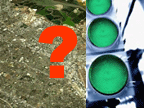
"Interactive City": Middle-Class Consumer Spectacle?
- calling an old person in San Jose to talk about whatever you might
have in common with them
- pressing a button on a machine and getting an artsy plane ticket
with your photo on it
- drifting through the city as if it were a sports field via applying
sports plays in urban space
- visualizing your social network via bluetooth as you go around the
conference and talk to your friends
- watching/listening to noise music made by people riding skateboards
around the conference
- listening to an erotic sci-fi narrative about san jose on your cell
phone while riding the train
- flipping light switches to make a one-word message in public space
- viewing colorful 3D representations of wireless digital data
kanarinka [kanarinka at ikatun.com] [from iDC: Interactive City: irrelevant mobile entertainment?]
Sarah Kanouse
tobias c. van Veen
Brad Borevitz
mollybh at netspace.net.au
Daniel A Perlin Edge Conditions
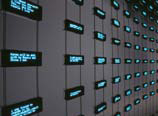
intersectional territory
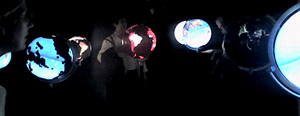 Most remarkable cognitive engagement was Ingo Gunther's fascinating WorldProcessor, an installation of illuminated globes visualizing social, political and environmental issues. This catalogue gives some indication of the data represented and how it's mapped to the globes. But it's the ability to walk around each globe and move one to another through the array of illuminated globes in the space that contributes to the impact of the meaning. The relative scale of the globes in relation to your comprehension of the data on a global scale is quite powerful. In this 2001 Shift interview he talks about his process and this ongoing project that began in 1988.
Most remarkable cognitive engagement was Ingo Gunther's fascinating WorldProcessor, an installation of illuminated globes visualizing social, political and environmental issues. This catalogue gives some indication of the data represented and how it's mapped to the globes. But it's the ability to walk around each globe and move one to another through the array of illuminated globes in the space that contributes to the impact of the meaning. The relative scale of the globes in relation to your comprehension of the data on a global scale is quite powerful. In this 2001 Shift interview he talks about his process and this ongoing project that began in 1988.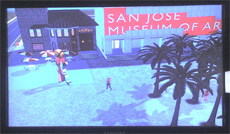 SimVeillance uses surveillance camera footage of the plaza outside the museum to generate characters in the game environment; I-5 Passing Lane uses pollution sensors along US I-5 to dynamically playback video scenes from the road; Takuji Kogo's Song for Silicon Valley is a video fabricated from the imagination based on iamgery culled from the internet; Tamiko Thiel's 3d VR installation The Tales of Mariko Horo inverts the Marco Polo story as an exploration of the mythic west; Michael Samyn and Auriea Harvey's MMORPG game Endless Forest, also envisions a fantasy game place that is beatiful and other; C5's Analogous Landscape sculpture and GPS data visualization investigate if mapping from one mountain ascent can be used to navigate another; while Thomson and Craighead's Light from Tomorrow draws attention to the social construction of time, yet the international date line exists because of the interconnectedness of time, space, and place where a day is lost or gained when circumnavigating the globe.
SimVeillance uses surveillance camera footage of the plaza outside the museum to generate characters in the game environment; I-5 Passing Lane uses pollution sensors along US I-5 to dynamically playback video scenes from the road; Takuji Kogo's Song for Silicon Valley is a video fabricated from the imagination based on iamgery culled from the internet; Tamiko Thiel's 3d VR installation The Tales of Mariko Horo inverts the Marco Polo story as an exploration of the mythic west; Michael Samyn and Auriea Harvey's MMORPG game Endless Forest, also envisions a fantasy game place that is beatiful and other; C5's Analogous Landscape sculpture and GPS data visualization investigate if mapping from one mountain ascent can be used to navigate another; while Thomson and Craighead's Light from Tomorrow draws attention to the social construction of time, yet the international date line exists because of the interconnectedness of time, space, and place where a day is lost or gained when circumnavigating the globe.DataNature

Cohabitation Artifact
August 14, 2006
after ISEA
Looking back to look forward
August 11, 2006
SWAMP
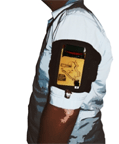
Improvised Empathetic Device
Who's Rosa von Braun?
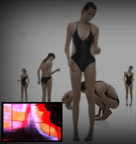
SUFFERROSA
Global Web Jam
![]()
Call for Solidarity
http://beirut.streamtime.org :: http://streamtime.org :: Live audio/video streaming transmission from Waag Society in Amsterdam, in direct connection with Beirut and surrounding localities. The event was initiated by Streamtime, a web support campaign for Iraqi bloggers.
Solidarity Fund.ISEA re:mote > live coding
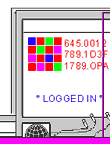
Intertwingularity
Daylight Time) if you are in San Jose CA .US [+/or] 5 PM (Central
Daylight Time) if you are in Chicago IL .US [+/or] 958 Internet Time
if you are onLine [+/or] 22:00:00 UTC (Coordinated Universal Time) [+/
or] GMT (Greenwich Mean Time) everywarez...at ISEA: tech goes retro
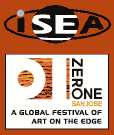
the power of paper
at ISEA: the world is getting smaller
Z1SMS
August 10, 2006
Silverfish Stream
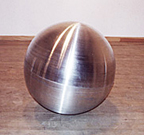
Awkward Pas de Deux
INTERVIEW: Local: 0, Global: 1.

Igor Stromajer by Ignacio Nieto
Getting Under the Skin:
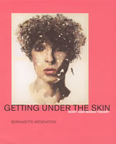
Body and Media Theory
Public Mood Ring

Collective Public Mood
Regrets
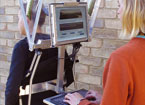
Collective Remorse
Free Press

Call for Participation
The Eclectic Tech Carnival 2006:
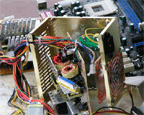
The Learning Bazaar
- Linux: learn the basics, install or share and extend your skills
- FLOSS: what is it and how you can use it?
- HTML: hand-coding web pages
- other scripting languages: Perl, Python, CSS etc
- computers as creative tools for communication: UpStage, audio and video streaming
- lecture on Creative Commons
& other random analogue elements of creativity that sizzle during the eventAPPARITION II
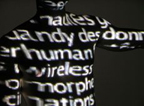
Furthering the Aesthetics of Body Projection
The camera based motion tracking system developed for APPARITION uses complex computer vision algorithms to extract the performer's moving outline or shape from the background to provide constantly updating information for a body projection as well as qualitative calculations of certain motion dynamics, e.g. speed, direction, intensity and volume. The information derived from these calculations is assigned dynamically to the real-time generation of visuals that are projected either directly back onto the body and/or as large-scale background projection. The precise synchronization of projections on the background and the bodies result in the materialization of an overall immersive kinetic space or a virtual architecture that can be simultaneously fluid and rigid, that can expand and contract, ripple, bend and distort in response to or an influence upon the movement of the performers.August 08, 2006
Fete Mobile

The Movable Feast Project
Chit Chat Club

A Teatime Telepresence
Receiver #16
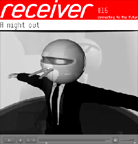
Social Networking the Mobile Way
Responsive Environments:
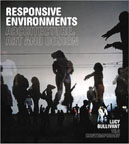
Architecture, Art and Design
Exploded Monologues
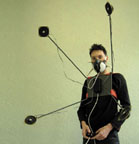
Transcending the Bodies' Boundaries
PLENUM: Security is an illusion:
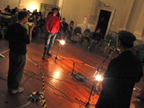
Encoding Fragility by Nancy Mauro-Flude
In the frame of 12 hours, 5 acts, 2 interludes, a sensual realm of poetic politics unfolds. As you ascend the staircase and enter the Limehouse TownHall, you become an actor immersed within the mise en scene, a variable of the ensemble. While the event points to net culture and media arts, in the context of NodeL programme, PLENUM also addresses how these function within larger contemporary society. Specifically addressing NodeL as a successful porthole and clearing house for new media arts, a man in tweed hat asks: But what about my level of autonomy and sustaining my own freedom? On entering some people need direction and ask: What do “they“ expect from me? In due time they disolves into we because here anything goes. What one encounters is an evolving fluid and fragmented series of conversations around the statement initially posed by the MC MISTRIX:
By Act Four a core of individual, autonomous actors emerge. A myriad of discussions take place, from reflections about the discrete art object, to engaging with the actual technical specificity of a wireless network, to a hope for a broader understanding and more nuanced language in order to engage with media art;
- We need a many-festo!
- I came because of the sheer incomprehensibility of the publicity around PLENUM. It was a relief from catch phrases such as outreach, engagement, sustainability, reworking of conversations and bandied about terms. I'm so tired of all this middle management speak.
- Do we need media arts as a term?
- There was once a hierarchy within the media arts scene i.e. who is more tech than the others, it is becoming better now.
- It was always better off for me to stay on the periphery of media arts.
- Make sure that we all get a chance to speak our points: I noticed it because I tend to talk a lot.
- People are starting to act like the software; this process is the most remarkable thing.
Question: Who is going to sum it all up and take it further? Who will be our spokesperson?
Answer: Why do we need a spokesperson anyway? This is just representative democracy.
We are fragile about our positions. We are inherently full of questions.
If we were all very confident we wouldn't be here.
THIRD PLAYER
Security is an illusion,
We have to encourage fragility,
In situations where we feel fragile, we question ourselves and learn.
FORTH PLAYER
We are scared of commitment, because we are not sure of our position.
We need to provide infrastructures for security.
Shall we all go to bed now?
PD PATCHERS’ SOUND BEGINS TO INTENSIFY, CONVERSATION BECOMES INCOMPREHENSIBLE
FORTH PLAYER begins to teach a dance class to the other willing participants
She begins with how to do a classical ballet plie`
PD PATCHER floods the room with disco music
The woman stops the class and begins to dance freely.
Actors are taking turns on the microphones, working through the agendas vying their points of view. A player asks:
The PD PATCHERS’ SOUND LAYERS OVER THE CONVERSATION
FORTH PLAYER RUNS pulls the plug, disconnects the electricity to the computers processing the sound and exits
PD PATCHER re plugs in the machine, it switches back on. He turns it up to full volume
ACT Five: Walk the dog
The Pd patchers are invited to come into the centre to explain how they were manipulating the players.
PLENUM generates a lot of communication and interaction in the setting it provides. This event is a transformative process, a mutual apprehension of a series of acts, patches, scripts, conditions and discussions as a means for speaking and thinking, between each other, and ultimately, perhaps the extent to which this may contribute to the nascent stutterings of the hoped for conversation with the larger public sphere. Here we experience an expandable software model for collaborative communication, a practice that is concerned with ontological, as well as, social and political issues. I would wish to argue that a profound re-coding of awareness and perception is what is required if we are to confront some outdated human legacies that are resistant to mobilisation. This structure brought forth new considerations that simultaneously shift the limits of individual articulation and critical embodiment. It allowed me to experience the significance of software as consciously designed landscapes that shape social patterns and relationships. PLENUM’s setting is intentionally autocratic, understood by some participants in semantic extremes: This is a Boot Camp! or even This reminds me of those Trance Parties in Goa in the early 90s. Perhaps it can be said that to fully understand the particular model of intensification introduced by KOP and XXXXX was as an event where you may begin to fully comprehend what the meaning of freedom is, nothwithstanding the whole debate around free software and how this actually relates to operating systems in daily life.
MISTRIX
New Europe has arrived
NEW PLAYERS ARRIVE AND FORM A NEW CLUSTER. They begin to speak in their first language; many different languages are circulated and used in response to agenda items. NOTE TAKERS REPEAT THE AGENDAS ON THE BOARD AND ASK PEOPLE TO BEGIN TO CLUSTER INTO 3 TOPIC GROUPS IN ORDER TO CONTINUE THE DISCUSSION. PLAYERS PITCH THEIR TOPICS THE LOUDEST IS HEARD.
PLAYER:
I hate Ars Electronica its like a Mercedes Benz logo.
Just get out there and do it
It took us 10 years for people to start listening to us
You might be 30000 pounds in debit but we are working with all different types of cultural sectors, street kids etc.
1#Relevance - presence
2#Lexicon - multi-lingual inclusion/exclusion
3#Real-play
4#Infrastructures- event driven models
Acker, Kathy. 1997. Bodies of Work: Essays. London: Serpents Tail.August 07, 2006
The Travels of Mariko Horo

Being Mariko Horo
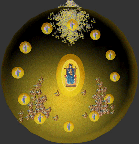
Upstage
![]()
Open Walk-Through
http://www.avatarbodycollision.org
http://www.writerfind.com/hjamieson.htm From Dusk Till Dawn
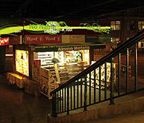
Visualizing Communication in Urban Space
August 04, 2006
SKIN-PÔ
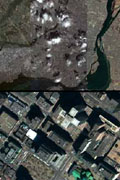
Artistically Sensitive Ecosystems
Tablescape Plus
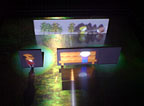
Upstanding Tiny Displays
August 03, 2006
Turbulence Commission:
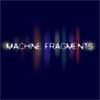
Machine Fragments
ISEA2006 Papers
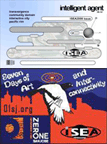
Intelligent Agent Special Issue
Raqs Media Collective

For the Record
Raqs Media Collective
Sarai-CSDS
29 Rajpur Road
Delhi 110054
www.raqsmediacollective.net
www.sarai.net iDC: Architecture and Situated Technologies
![]()
the "internet of things"
August 02, 2006
Earworm Assault Devices

Weapons of Mass Distraction
Global brands are using huge budgets to propagate their earworms by means of multiple costly channels, the respectable citizen remains defence- and powerless. Until now: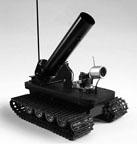
Acclair

A Neurocapital Service
function:feminism
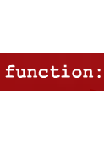
World Wide Waves of Cyberfeminism(s)
August 01, 2006
E-volver
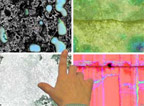
image-breeding-machine
